What's Happening at the Dam
This page reports the Corporation's actions to preserve and maintain our iconic 165-year-old dam on Rattlesnake HIll Road. The log begins in 2003 and runs in chronological order through the present, with the most recent events at the top. Use the list of headlines below to jump to any article. For more information on visiting the dam, including access and parking, and a review of the laws and regulations which apply to our dam, click here.
![]()
 Pond Refills, But Drought Lingers 4/25
Pond Refills, But Drought Lingers 4/25
 2025 Refill Starts as Drought Hangs On 3/25
2025 Refill Starts as Drought Hangs On 3/25
 Pond Reaches Its Winter Level, Beavers Be Dammed 12/24
Pond Reaches Its Winter Level, Beavers Be Dammed 12/24
 With an Assist from the Drought, Drawdown Nears Completion 11/24
With an Assist from the Drought, Drawdown Nears Completion 11/24
 After a Mild Winter, an Early Refill 5/24
After a Mild Winter, an Early Refill 5/24
 Annual Drawdown Lowers Pond to Its Winter Level 12/23
Annual Drawdown Lowers Pond to Its Winter Level 12/23
 Like Clockwork, Waterfall Is Back 5/23
Like Clockwork, Waterfall Is Back 5/23
 Pond Begins to Refill, Right on Schedule 4/23
Pond Begins to Refill, Right on Schedule 4/23
 Drawdown Starts, With an Assist from Drought 11/22
Drawdown Starts, With an Assist from Drought 11/22
 Waterfall Returns, Marking Completion of Refill 4/22
Waterfall Returns, Marking Completion of Refill 4/22
 Annual Refill Starts 4/22
Annual Refill Starts 4/22
 Dam Passes Its 5-Year Safety Inspection 12/21
Dam Passes Its 5-Year Safety Inspection 12/21
 Flowers Still Blooming, but Winter Drawdown Starts 11/21
Flowers Still Blooming, but Winter Drawdown Starts 11/21
 Unusually Wet Summer Keeps Waterfall Flowing Over Dam 9/21
Unusually Wet Summer Keeps Waterfall Flowing Over Dam 9/21
 As Pond Refills, Waterfall Returns 6/21
As Pond Refills, Waterfall Returns 6/21
 And for the Finishing Touch: 11 More Tons of Rock 5/21
And for the Finishing Touch: 11 More Tons of Rock 5/21
 Dam Gets a New Spillway, and Spring Refill Begins 5/21
Dam Gets a New Spillway, and Spring Refill Begins 5/21
 Volunteers Move a Mountain to Restore Dam 5/21
Volunteers Move a Mountain to Restore Dam 5/21
 Winter Drawdown Gets Underway 10/20
Winter Drawdown Gets Underway 10/20
 Refilling the Pond: After Three Weeks, It's Done 4/20
Refilling the Pond: After Three Weeks, It's Done 4/20
 2020 Refill Starts 3/20
2020 Refill Starts 3/20
 Right on Schedule: Pond Ebbs to Winter Level 12/19
Right on Schedule: Pond Ebbs to Winter Level 12/19
 Annual Winter Drawdown Starts 11/19
Annual Winter Drawdown Starts 11/19
 In Case of Emergency . . . 9/19
In Case of Emergency . . . 9/19
 That's Water Over the Dam 4/19
That's Water Over the Dam 4/19
 2019 Refill Gets Underway 3/19
2019 Refill Gets Underway 3/19
 Drawdown? Not So Fast 12/18
Drawdown? Not So Fast 12/18
 Drawdown Starts on Schedule 11/18
Drawdown Starts on Schedule 11/18
 April Monsoon Refills Pond 4/18
April Monsoon Refills Pond 4/18
 Refill Begins as Snowpack Dwindles 3/18
Refill Begins as Snowpack Dwindles 3/18
 Pond Ebbs to Winter Level, But Beavers Stage Nightly Protests 12/17
Pond Ebbs to Winter Level, But Beavers Stage Nightly Protests 12/17
 Winter Drawdown Starts, As Dry Conditions Hang On 11/17
Winter Drawdown Starts, As Dry Conditions Hang On 11/17
 Drought Ends and Pond Fills 4/17
Drought Ends and Pond Fills 4/17
 Water Level Raised Early, As Drought Hangs On 3/17
Water Level Raised Early, As Drought Hangs On 3/17
 Dam Earns "Satisfactory" Safety Rating 3/17
Dam Earns "Satisfactory" Safety Rating 3/17
 Drawdown Quandary: Should We Expect Continued Drought - Or Another Flood? 12/16
Drawdown Quandary: Should We Expect Continued Drought - Or Another Flood? 12/16
 Winter Drawdown Ends, But Winter Doesn't 4/16
Winter Drawdown Ends, But Winter Doesn't 4/16
 2016 Refill Gets Early Start 3/16
2016 Refill Gets Early Start 3/16
 2015-16 Winter Drawdown Is Under Way 11/15
2015-16 Winter Drawdown Is Under Way 11/15
 Maintenance Effort Takes Tons of Material 5/15
Maintenance Effort Takes Tons of Material 5/15
 Pond Refills After Heavy Rains 7/14
Pond Refills After Heavy Rains 7/14
 Drawdown Ends As Repairs Proceed 5/14
Drawdown Ends As Repairs Proceed 5/14
 Volunteers Start Repairs on Sinkhole 4/14
Volunteers Start Repairs on Sinkhole 4/14
 Mother Nature Jumps the Gun on Winter Drawdown 11/13
Mother Nature Jumps the Gun on Winter Drawdown 11/13
 Tropical Storm Andrea Fills Pond 6/13
Tropical Storm Andrea Fills Pond 6/13
 Drawdown Ends After Volunteers Rock the Dam 4/13
Drawdown Ends After Volunteers Rock the Dam 4/13
 With Superstorm Near, 2012-13 Winter Drawdown Begins 10/12
With Superstorm Near, 2012-13 Winter Drawdown Begins 10/12
 Pond Refills Despite Drought 5/12
Pond Refills Despite Drought 5/12
 Bucket Brigade Strengthens Dam 3/12
Bucket Brigade Strengthens Dam 3/12
 Safety Inspection Rates Dam "Satisfactory" 12/11
Safety Inspection Rates Dam "Satisfactory" 12/11
 2011-12 Winter Drawdown Begins 11/11
2011-12 Winter Drawdown Begins 11/11
 Welcome Sight: Water Over the Dam 6/11
Welcome Sight: Water Over the Dam 6/11
 With Leak Repaired, Refill Begins 5/11
With Leak Repaired, Refill Begins 5/11
 Pond Refill to Start Soon 4/11
Pond Refill to Start Soon 4/11
 Winter Drawdown Barely Shows After Summer Drought 12/10
Winter Drawdown Barely Shows After Summer Drought 12/10
 Volunteers Pitch In to Repair Damage from Spring Storms 6/10
Volunteers Pitch In to Repair Damage from Spring Storms 6/10
 2nd March Storm More Damaging Than 1st 4/10
2nd March Storm More Damaging Than 1st 4/10
 Deluge Hits Andover, But Dam Takes It in Stride 3/10
Deluge Hits Andover, But Dam Takes It in Stride 3/10
 2009-10 Winter Drawdown Beats the Freeze 12/09
2009-10 Winter Drawdown Beats the Freeze 12/09
 Spring Showers Gently Refill Pond 5/09
Spring Showers Gently Refill Pond 5/09
 Refill Begins, Ending Drawdown 4/09
Refill Begins, Ending Drawdown 4/09
 2008-9 Winter Drawdown Gets Underway 11/08
2008-9 Winter Drawdown Gets Underway 11/08
 Rebuilt Wall Erases Last Sign of '06 Flood 10/08
Rebuilt Wall Erases Last Sign of '06 Flood 10/08
 State Finds Dam In Compliance 8/08
State Finds Dam In Compliance 8/08
 Heavy July Rains Are No Problem for Rejuvenated Dam 8/08
Heavy July Rains Are No Problem for Rejuvenated Dam 8/08
 New Safety Inspection Gives Dam a Passing Grade 5/08
New Safety Inspection Gives Dam a Passing Grade 5/08
 Late-April Showers Raise the Pond As Drawdown Ends (4/08)
Late-April Showers Raise the Pond As Drawdown Ends (4/08)
 Pond and Temperatures Drop As Winter Sets In (12/07)
Pond and Temperatures Drop As Winter Sets In (12/07)
 With Restoration Complete, Winter Drawdown Begins (11/07)
With Restoration Complete, Winter Drawdown Begins (11/07)
 Bench Added to New 'Pocket Park' (9/07)
Bench Added to New 'Pocket Park' (9/07)
 Dam's East Side Nears Completion (8/07)
Dam's East Side Nears Completion (8/07)
 West Side of Dam Is Almost Finished (7/07)
West Side of Dam Is Almost Finished (7/07)
 Work Progressing On Dam (7/07)
Work Progressing On Dam (7/07)
 2006-7 Winter Drawdown Ends Quietly (5/07)
2006-7 Winter Drawdown Ends Quietly (5/07)
 Torrential Rains Test Drawdown and New Wall 5/07)
Torrential Rains Test Drawdown and New Wall 5/07)
 Work Resumes on Dam (4/07)
Work Resumes on Dam (4/07)
 Inspection Report: Dam Needs Some Work (12/06)
Inspection Report: Dam Needs Some Work (12/06)
 Balmy Weather Aids Dam Repairs (12/06)
Balmy Weather Aids Dam Repairs (12/06)
 Engineers Inspect Dam (11/06)
Engineers Inspect Dam (11/06)
 Winter Drawdown Starts (11/06)
Winter Drawdown Starts (11/06)
 Dam Spruces Up For Inspection (10/06)
Dam Spruces Up For Inspection (10/06)
 New Pathway Takes Shape (9/06)
New Pathway Takes Shape (9/06)
 Conservation Commission Okays Dam Access Plan (8/06)
Conservation Commission Okays Dam Access Plan (8/06)
 Flood of '06 Leaves Its Mark on Foster's Pond Dam (5/06) [with video]
Flood of '06 Leaves Its Mark on Foster's Pond Dam (5/06) [with video]
 First Winter Drawdown? Consider It Water Over the Dam (4/06)
First Winter Drawdown? Consider It Water Over the Dam (4/06)
 Sluiceway Restored to Enable Winter Drawdowns (10/05)
Sluiceway Restored to Enable Winter Drawdowns (10/05)
 April
Showers Hit Dam Hard (4/04) [with pix of overtopping]
April
Showers Hit Dam Hard (4/04) [with pix of overtopping]
Updates
Pond Refills, But Drought Lingers
April 2025
After a night of light rain (mixed with a little spring snow, this being New England), water began cascading over the Dam's 12-foot-wide spillway April 12, ending the the 2024-25 annual winter drawdown.

April 12: A thin sheet of water cascades over the spillway for the first time since last December.
After stoplogs were inserted in the narrow sluiceway adjacent to the spillway on March 25, the Pond rose an average of eight-tenths of an inch a day. By April 10 - having risen about 13 inches - the water was lapping at the lip of the spillway. Two days - and an inch-and-a-half - later, the Dam's iconic waterfall was back in action.
Notwithstanding about three-and-a-half inches of rain in April, the U.S. Drought Monitor continued to characterize the area, including much of Massachusetts, as experiencing "moderate drought."
2025 Refill Starts as Drought Hangs On
March 2025
With the insertion of three stoplogs into the narrow sluiceway of the Foster's Pond Dam, the gradual process of reversing the annual winter drawdown got underway on March 25.

March 25: FPC volunteers Paul Chase (left) and Zac Johnson lower the first of three stoplogs into the Dam's sluiceway, beginning the month-long process of ending the annual winter drawdown and refilling the Pond.
Just how long it will take for water to begin flowing over the Dam's spillway is up to Mother Nature, who has delivered less-than-optimal precipitation for weeks.
According to the U.S. Drought Monitor, "moderate drought" conditions have persisted over much of Massachusetts, including almost all of Essex County,
This U.S. Drought Monitor map, released March 20 and based on data from March 18, shows "moderate drought" conditions across much of Massachusetts. The FPC "flying duck" icon indicates the location of Foster's Pond. Click on the image to see an enlargement.
Although there's not a strict schedule for ending the winter drawdown, April 1 is the usual target date for beginning the refill process, with the Pond resuming its flow over the spillway three to four weeks later.
Heavy spring rains can speed up the refill. But if the precipitation gets out of hand (the Mother's Day Flood of 2006 comes to mind), one or two stoplogs may have to be pulled out to increase the outflow before the water rises too high for the Dam to handle safely.
Pond Reaches Its Winter Level, Beavers Be Dammed
December 2024
Right on schedule, the 2024 annual winter drawdown as of early December lowered Foster's Pond to its target level, nearly a foot and a half below the lip of the Dam's spillway.
But while the first foot of the drawdown was achieved without effort (drought conditions had dropped the water level long before the normal November 1 start of the drawdown), the last few inches proved more challenging.
Exactly one week after stoplogs were removed from the Dam to complete the drawdown process, the Resistance sprang into action. A few newly-gnawed branches appeared in the sluiceway, brought by beavers drawn to the sound of rushing water. One day later, the sluiceway was fully blocked.

November 30: It took the beavers just one night to plug the sluiceway after it had been cleared of a blockage the previous afternoon. (Scroll down to the November 20 picture of the Dam, below, to see the torrent the beavers interrupted.) The beavers fully dammed the sluiceway twice in two days, but partial blockages continued daily. Note the bright orange fishing bobber entangled in the branches.
FPC volunteers responded immediately, clearing the sluiceway and restoring the flow.
Those efforts didn't last the night. By the following morning, the sluiceway was once again fully plugged.
Volunteers cleared it in the afternoon. The beavers struck again overnight. Volunteers cleared. The beavers countered. And so it went for the first week. Eventually, ice near the Dam puts an end to each year's beaver battles, but in 2024, Week 1 was a draw.
With an Assist from the Drought, Drawdown Nears Completion
November 2024
Normally, the annual winter drawdown of Foster's Pond begins on November 1, with the removal of the first of three stoplogs from the narrow sluiceway of the Foster's Pond Dam. The additional outflow gradually lowers the water level by about 3/4 of an inch a day, and after about 10 days, the second stoplog is removed. After another 10 days, the final one comes out.
Weather during the fall of 2024, however, has been anything but normal. The area endured a severe drought, just a stone's throw from from a swath of the State characterized by the U.S. Drought Monitor as suffering from extreme drought.
As a result, Foster's Pond (which hadn't seen a serious downpour in two months) had by November 1 fallen to a level normally seen as of Week 3 of the drawdown process.
On November 20, with measurable rain finally in the forecast, volunteers picked up where Mother Nature left off. They removed all three stoplogs from the Dam (the top two were completely dry), letting water course through the sluiceway to complete the final stage of the drawdown.

November 20: With the water already down about 2/3 of the way towards the winter drawdown's target level, courtesy of Mother Nature, the stoplogs were removed to complete the process by December 1.
Under the Order of Conditions which governs the Corporation's lake management program, the preferred schedule for winter drawdowns calls for gradually reaching the winter water level by December 1. That gives submerged critters such as mussels time to shift to underwater locations that will not freeze solid during the winter.
The primary reason for winter drawdowns is public safety. Lowering the Pond creates freeboard so that accumulations of snow and ice, along with spring rains, can be accommodated when the weather warms. Containing the spring runoff can avert overtopping, which erodes and may weaken the Dam. A secondary reason for the drawdowns is to expose shallow areas to freezing temperatures, which can kill some nuisance vegetation.
After a Mild Winter, an Early Refill
May 2024
As a mild winter - featuring little snow and almost no ice on the Pond - came to an end, refilling the Pond got a jump-start in early March. By March 11, water was flowing over the spillway, restoring the Dam's picture-postcard waterfall.

March 4: With the first two stoplogs inserted in the Dam's sluiceway, the 2023-24 winter drawdown was put in reverse.
Two of the Dam's three stoplogs were placed in its narrow sluiceway on March 4, all but blocking the flow of water out of the Pond and beginning what is often a slow process of restoring the water level ahead of warm weather.
Depending on precipitation, it usually takes three or four weeks for the Pond to rise to the point where the Dam's iconic waterfall is fully restored. But spring rains came fast and hard, hastening the refill. One week after the first two stoplogs were inserted, the waterfall was back.
The third stoplog was inserted on May 13, allowing the Pond to rise a few inches higher for the summer.
The drawdown is a common New England practice to spare a dam from overtopping when spring rains, melting ice, and frozen ground combine to raise the the dam's impoundment, sending torrents over the top. The result can be catastrophic, especially for an earthen dam like ours, which is highly vulnerable to erosion.
But with the snow and ice gone and the ground already thawing by the end of February, the need to prolong a drawdown had diminished. And in 2024, hydro-raking was set to begin in April in order to make way for an early-spring fanwort treatment. It was essential that the water level be high enough by the end of March to let the rake reach shorelines in order to dump spoils.
Annual Drawdown Lowers Pond to Its Winter Level
December 2023
Over the month of November, Foster's Pond was lowered to its normal winter level, about 18 inches below the lip of the Dam's spillway. The drawdown is an annual process, a routine part of the Corporation's lake management program.
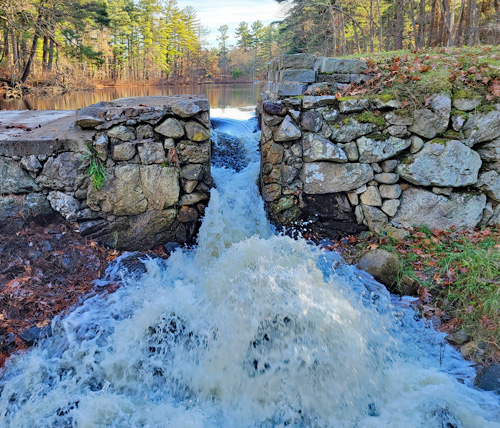
November 24: With the last stoplog removed from the narrow sluiceway of the Foster's Pond Dam, it takes only a few days for the Pond to drop to its normal water level for the winter.
The drawdown began with the removal of the first of three stoplogs from the Dam's narrow sluiceway on November 3. The second came out on November 14, and the last followed ten days later, dropping the water level to about one and a half feet below the lip of the much wider spillway which channels the Dam's iconic waterfall.
The main purpose of the drawdown is to create freeboard for the accumulation of winter ice and springtime rains which might otherwise overtop and erode the Dam - a catastrophe narrowly averted in the Mother's Day flood of 2006.
Like Clockwork, Waterfall Is Back
May 2023
Exactly one month after the start of the process of refilling the Pond from its winter drawdown, water began trickling over the spillway of the Foster's Pond Dam. On May 1, after the Pond rose another inch following a heavy rain, the water was cascading in picture-postcard splendor, restoring the Dam's most iconic feature.
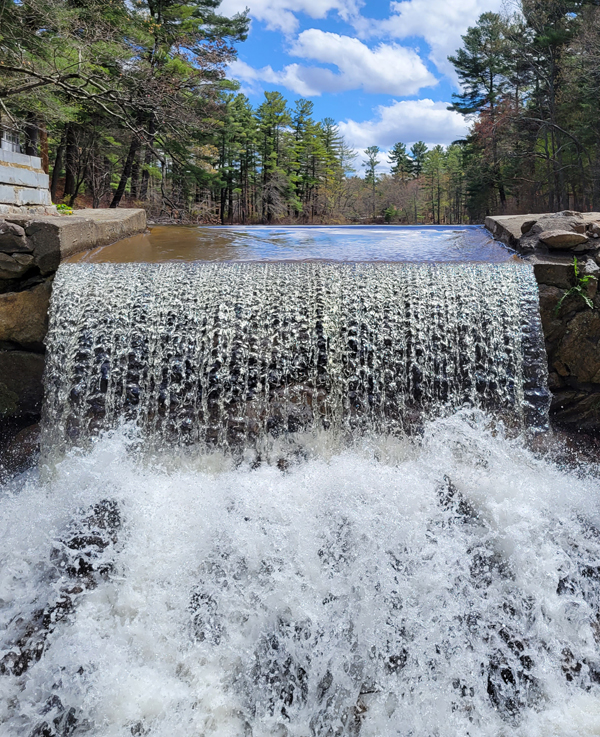
May 1: The refill of the Pond began April 1, starting a three- to four-week process of raising the water level after a winter drawdown. Four weeks later, on April 30, water was trickling over the spillway. And by the following day, the Dam's iconic waterfall was on full display.
A drier-than-normal April threatened to drag out the refill beyond the end of the month. But heavy rain fell over the final week-end, raising the water level pretty much to the point where it would have been even without a winter drawdown, and ending the 2022-23 drawdown.
Residents have drawn the Pond down since the days when Homer Foster owned the Dam, going back to the 1930s. The mechanisms for doing so have varied, and none was operable by the mid-1970s. The narrow sluiceway, with its three stoplogs, was restored in 2005, and winter drawdowns have been conducted every year since then.
Pond Begins to Refill, Right on Schedule
April 2023
Three stoplogs were inserted into the narrow sluiceway of the Foster's Pond Dam on April 1, marking the end of the annual winter drawdown and the start of the month-long process of bringing the Pond up to its usual early-summer level.
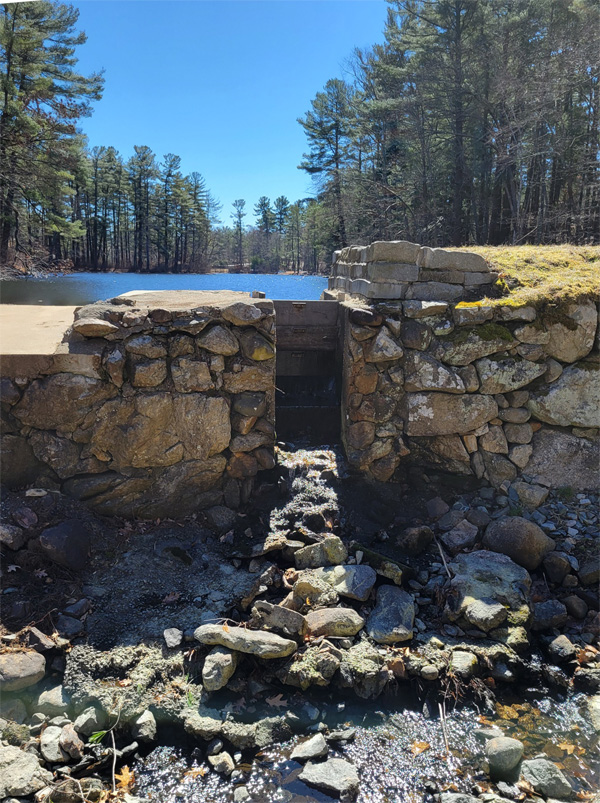
April 1: The three oak stoplogs which regulate the water level in Foster's Pond were inserted into the Dam's sluiceway. Water is expected to begin cascading over the adjacent spillway in three to four weeks, depending on rainfall.
Timing the start of the spring refill depends on several factors, including how much ice is left on the Pond, how much snow is left on the surrounding land, and how much work needs to be done on the Dam. This year, the answer to all three questions was simple: None. Accordingly, the stoplogs were put in place on what is normally the target date.
The primary purpose of the drawdown is to provide sufficient freeboard to accommodate snow melt and spring rains. In heavy snow years, the refill is delayed. The aim is to avoid a water level so high that the Dam overtops - a major cause of failure in an earthen dam. Even without melting snow, overtopping can occur. And if extraordinary rains are forecast later in the spring, when the Pond is full, a board or two can be removed to lessen the likelihood of overtopping.
Drawdown Starts, With an Assist from Drought
November 2022
A lingering drought had jump-started the Pond's annual winter drawdown in mid-summer - leaving the spillway of the Foster's Pond Dam high and dry since August and the water at a level usually achieved in mid-November only after the removal of two stop-logs.
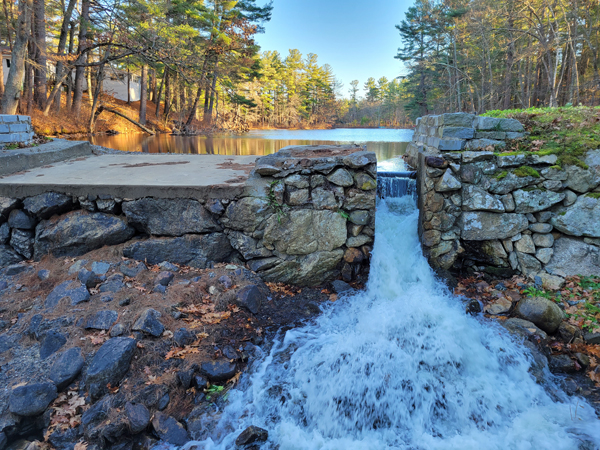
November 14: Water tumbles through the 2-foot-wide sluiceway after the removal of two stoplogs which control the water level of Foster's Pond. The 12-foot-wide spillway, on the left, normally a picturesque waterfall in early November, was bone-dry since August, due to a drought.
The normal schedule for the drawdown calls for the removal on November 1 of one of the three stop-logs that control the level of the Pond, removing the other two - one at a time - over the next three weeks or so. The aim is to bring the water down gradually, about two feet, before a hard freeze, giving submerged critters such as mussels time to shift to underwater locations that will not freeze solid during the winter.
But 2022 was not a "normal" summer. For the first time since 2017, drought conditions left the water level far below normal. The U.S. Drought Monitor as of mid-November showed Foster's Pond lying on a line between "moderate" and "severe" drought, and the results were evident at the Dam. The top-most stop-log, usually removed on November 1, was completely dry, with no water to hold back, and water came up only to the mid-point of the middle stop-log.
On November 14, with the Pond at a level normally seen when the first stop-long has been removed on November 1 and the second taken out on November 8, both were removed, putting the 2022-23 drawdown back on schedule. The third stop-log will be removed in another week, and the Pond will drop to its winter level by the end of the month.
If weather conditions return to "normal," the refill will start April 1.
Waterfall Returns, Marking Completion of Refill
April 2022
The picture-postcard waterfall over the Foster's Pond Dam made its spring debut on Earth Day, three weeks after stop logs were inserted to end the Pond's annual winter drawdown.
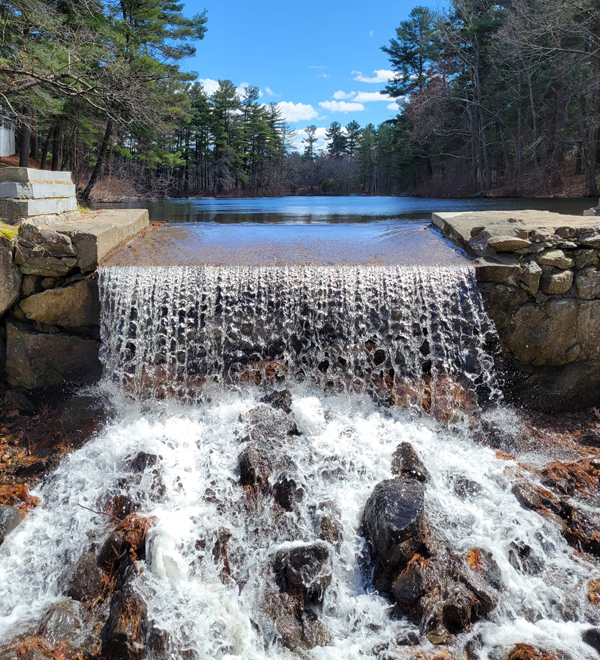
April 22: Water pours over the 12-foot-wide spillway, signalling the completion of the annual process of refilling the Pond after a winter drawdown.
The refill started on April 1, and the Pond rose an average of about one-half inch a day, starting to trickle over the spillway on April 19.
It took another couple of days to fully restore the photo-worthy cascade that distinguishes the 165-year-old Dam.
Barring extraordinary precipitation - like the rains which caused the 2006 Mother's Day flood - the waterfall will grace the Dam with a gentle flow for much of the summer, but may disappear in the dry days of August when the water level normally recedes.
Annual Spring Refill Starts
April 2022
The annual process of refilling the Pond after the winter drawdown began April 1.
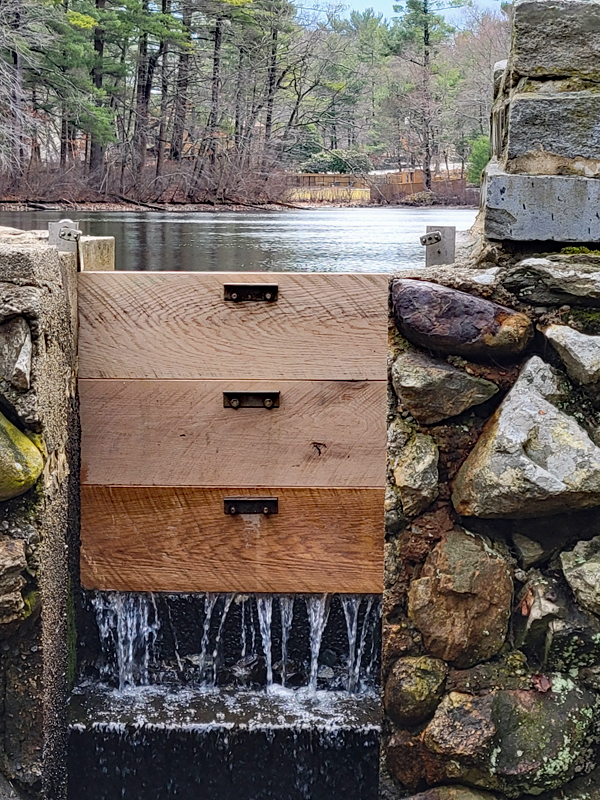
April 1: Three new stoplogs were placed in the Dam's sluiceway, starting the 2022 refill of the Pond.
The water level is controlled - to an extent - at the Dam's narrow sluiceway by three "stoplogs" which can be inserted or removed as needed. The mechanics are not exactly sophisticated, but they fit with a 160-year-old structure engineered before the Civil War. With the stoplogs removed, the water level drops about two feet from what would otherwise be the "normal" level.
The three oak boards which have served the purpose for the last 15 years were beginning to rot and were replaced this year. The new stoplogs, fashioned from a single two-inch thick white oak plank, weigh in at about 19 pounds each.
Depending on precipitation, the Pond will rise about a half inch a day, with water likely to begin cascading over the spillway by the end of the month.
Dam Passes Its 5-Year Safety Inspection
December 2021
The Foster's Pond Dam, under the microscope for a routine State-mandated safety inspection, received a passing grade in December.
The Dam, lying so close to a public road, falls into a State classification for which owners are required to hire a qualified engineer to conduct a detailed inspection every five years.
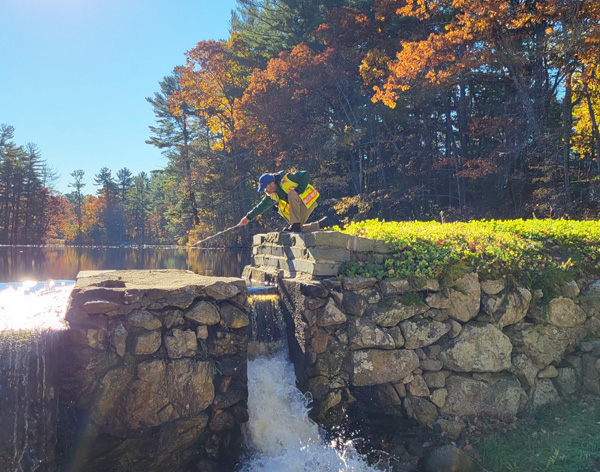
November 5: Lee Wooten, the FPC's consulting engineer, crouches down to take measurements during his inspection of the Foster's Pond Dam.
As with the Dam's previous inspection, undertaken in 2016, the Dam received a safety rating of "Satisfactory," the second highest mark that can be awarded and, as a practical matter, the highest attainable by an earthen dam engineered and built before the Civil War.
The inspection was conducted November 5, using a detailed protocol prescribed by the State. Since 2006, the FPC has retained GEI Consultants, Inc., a nationally recognized engineering firm headquartered in Woburn, to perform safety inspections and consult on dam maintenance.
GEI's 62-page report on the inspection was submitted to the FPC and the State's Office of Dam Safety on December 21.
The inspection report notes only two "minor deficiencies." One is the appearance of some clear water seeping from both sides of the 12-foot-wide spillway at the based of the Dam's heavy granite blocks. The seepage is a long-standing condition (it's even visible in a 1910 photo) that the FPC has worked hard to reduce and monitors closely. The second minor deficiency noted in the report is some bare patches on the grassy crest of the Dam.
The report recommends that the FPC continue to monitor the seepage, and reseed the bare patches, using biodegradable erosion control mats to protect new grass from geese and foot traffic.
Flowers Still Blooming, but Winter Drawdown Starts
November 2021
It was an unusually warm fall, with no frost through October, summer flowers still blooming, and abundant rain that kept the water level in the Pond above normal, but even if the weather wasn't wintry, it was time for the annual winter drawdown to begin.
The first stoplog in the narrow sluiceway of the Foster's Pond Dam was removed November 1, starting the slow process of lowering the Pond about 18 inches over the following three or four weeks.
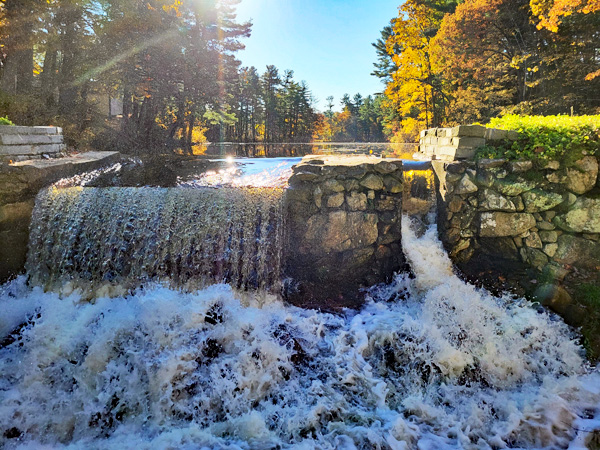
November 1: With one stoplog removed, water pours through the narrow sluiceway to the right of the Dam's 12-foot-wide spillway.
The remaining two stoplogs are usually removed, one at a time, at intervals of a week or ten days as the water level drops.
The target date for completing the drawdown each year is December 1, giving aquatic organisms like mussels ample time to reposition themselves before icy weather freezes them in place.
The primary aim of the drawdown is public safety. The lower water level increases the capacity of the Pond to accommodate snow accumulations and spring melt without overtopping - and potentially eroding - the Dam.
Depending on spring weather conditions, refilling the Pond will begin sometime between late March and early May - if the drawdown doesn't' need to be extended for unforeseen repairs to the Dam.
Wet Summer Keeps Water Flowing Over Dam
September 2021
In a normal summer, the relatively dry month of August drops the water level in Foster's Pond below the spillway of the Dam, exposing an expanse of concrete that can remain dry until the fall.
The summer of 2021 was different. Heavy rains drenched the region, and one result was that the picture-postcard waterfall at the Dam persisted throughout the summer.
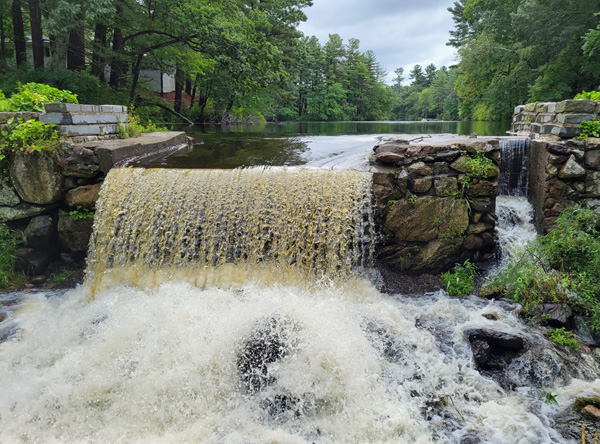
September 2: Heavy summer downpours dramatically increased the volume of water flowing over the Dam at a time when normal rainfall would have left the spillway high and dry. Note water also pouring over the stoplogs in the narrow sluiceway to the right..
After a particularly soggy week-end at the end of August, the Pond rose close to 7 inches over the course of two days, swelling the torrent cascading over the Dam's twelve-foot-wide spillway and even topping the stop-logs in the adjacent sluiceway.
Notwithstanding flash flood warnings in the area, the Pond never rose enough to cause concern, with the outflow staying within the low curbs that flank the spillway and far below the capacity of the culverts under Rattlesnake Hill Road.
As Pond Refills, Waterfall Returns
June 2021
The Dam's iconic waterfall made a sparkling return, after a couple of inches of June rain topped off the water level in Foster's Pond.
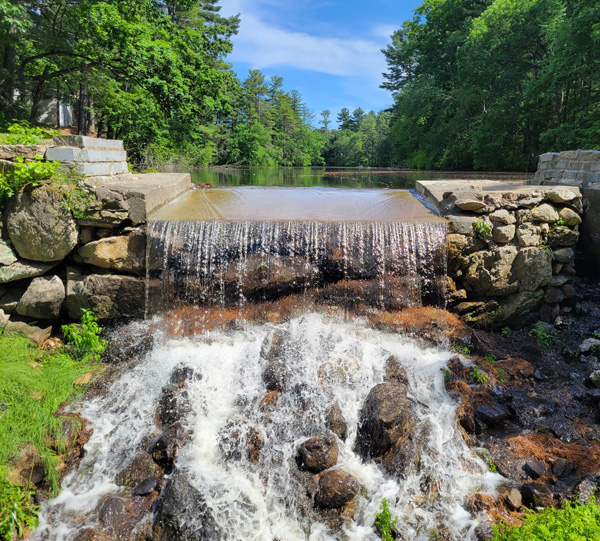
June 18: Water cascades over the Dam's brand-new spillway.
The annual winter drawdown had been extended for a couple of weeks while volunteers worked to replace the 12-foot-wide concrete spillway. After more than 100 years of service, it was crumbling and riddled with holes.
The maintenance project, which included placing tons of rock along the upstream slope of the Dam as an erosion-control measure, wound up at the end of May.
There is no set time for water to start flowing over the spillway. Depending on snow accumulation and spring rain, the waterfall may make its appearance any time from April to July. Maintenance on the Dam can also delay refilling the Pond.
The first tiny rivulets started trickling over the new spillway on June 9, but it took one more storm to lift the water level and yield a picture-postcard cascade.
Enjoy the sight while you can. By mid-August, the Pond may fall low enough that the waterfall will disappear until fall rains arrive.
And for the Finishing Touch: 11 More Tons of Rock
May 2021
The final stage of this year's maintenance project on the Foster's Pond Dam concluded May 25, with the spreading of six and a half tons of stone on the emergency spillway of the 160-year-old structure. Three days earlier, volunteers had placed another five tons of rock along the upstream slope of the dam, adding to 10 tons laid down on May 8.
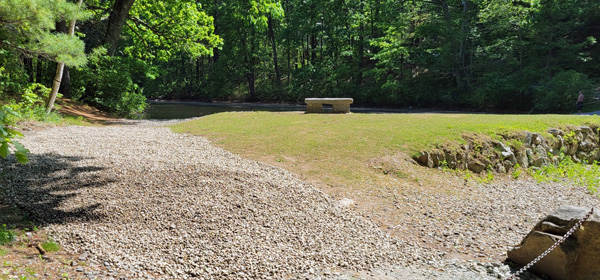
May 25: The emergency spillway - engineered to allow extremely high water to escape the Pond without overtopping the Dam - was fortified with 6.5 tons of stone. The emergency spillway doubles as a pathway for launching canoes, kayaks, and bass boats (only electric motors are allowed).
The maintenance project reinforced the erosion control system along the Dam's entire 150-foot length and replaced the concrete deck of the 12-foot-wide spillway.
Dam Gets a New Spillway, and Spring Refill Begins
May 2021
For the first time in over a hundred years, the Foster's Pond Dam has a new concrete deck to carry water over its 12-foot-wide spillway.
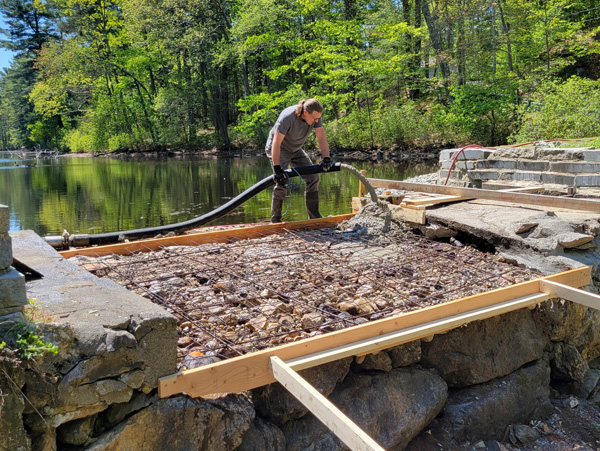
May 17: Local resident and master mason Scott Fumicello aims concrete at one of the larger voids in the Dam's spillway. In all, 3.5 cubic yards of high-strength concrete went into replacing the crumbling deck.
The original concrete deck replaced a wooden spillway sometime between 1914 and 1916. The concrete had been patched from time to time, but a century later it was cracked, crumbling, and full of holes. In addition, rocks which had formed a foundation for the concrete deck had settled, leaving gaps and voids a foot deep, and in some places deeper.
It took 3.5 cubic yards of concrete to fill the voids and replace the deck. Unlike the old slab, the new deck is steel-reinforced - and far stronger.
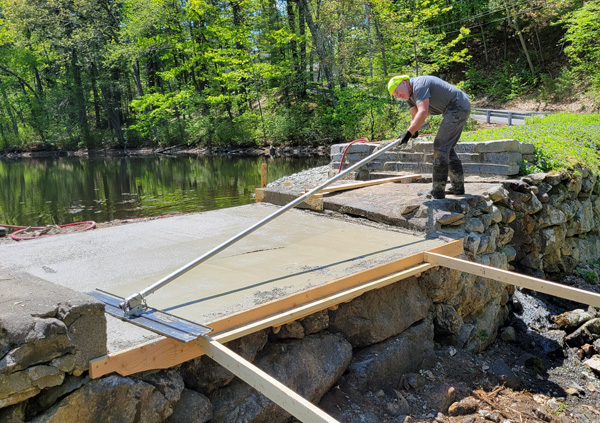
May 17: Fumicello spent hours - mostly on his knees using smaller implements - smoothing the concrete to a nearly polished finish.
Almost single-handedly, local resident and master mason Scott Fumicello formed, placed, and smoothed the concrete, which was poured by means of a pump positioned on the Dam's access-way. The entire operation took a full workday.
Meanwhile, the Dam's three stoplogs were inserted in the narrow sluiceway adjacent to the spillway, starting the process of ending the winter drawdown and raising the water level of Foster's Pond. The drawdown, which normally would have ended in time to refill the Pond by the end of May, was extended in order to keep the work area dry.
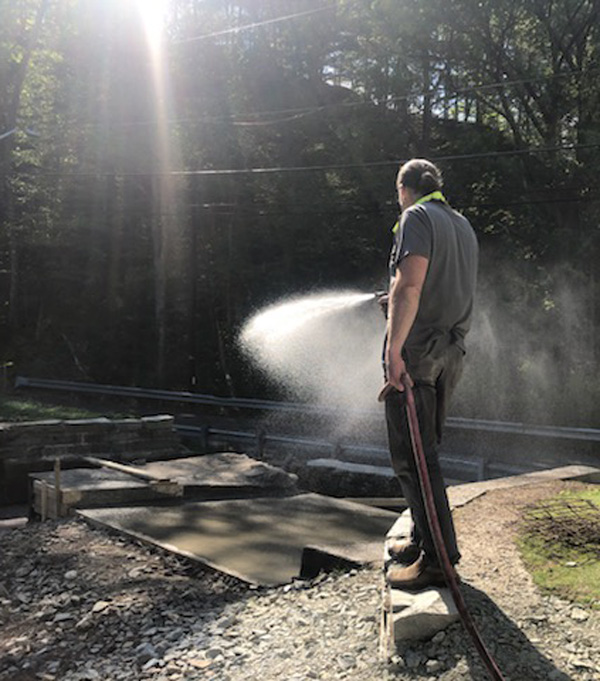
May 17: As the sun starts to go down, Scott Fumicello mists the freshly-poured concrete to cool it down during the initial curing stage. Photo by David Adilman.
Depending on rainfall, water could begin cascading over the new spillway in three to four weeks.
Volunteers Move a Mountain to Restore Dam
May 2021
Fifteen volunteers descended on the Dam on a pleasant spring morning as part of a major push to restore erosion controls and replace crumbling concrete on the Civil War-era structure.
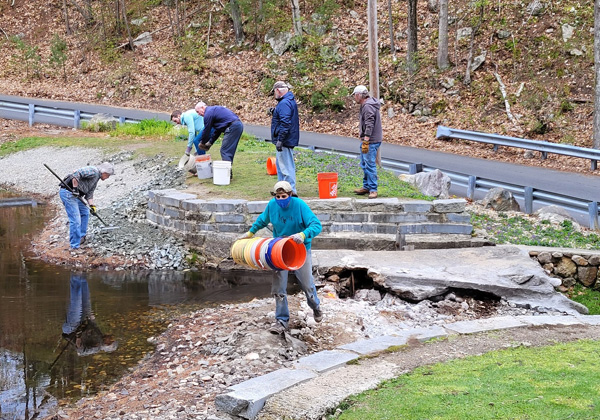
May 8: Volunteers lugged 10 tons of rocks in 5-gallon buckets to reinforce the layer of stone which prevents erosion on the upstream slope of the 160-year-old structure.
The volunteers - for the most part using just shovels and their gloved hands - dug into a five-foot high mountain of rocks which were purchased to buttress the upstream slope of the earthen Dam. The rocks form the outer surface of an erosion control system that includes a layer of geosynthetic cloth, which itself must be protected from sunlight. Area residents Will Weightman and Dave Workman contributed a Bobcat and a lawn tractor to the effort, but heavy equipment can only be used sparingly on the fragile crest without digging up its grass cover. Most of the stones went into 5-gallon buckets and were spread by hand.
In addition to distributing the rocks, the volunteers removed about two tons of deteriorating concrete from the Dam's 12-foot-wide spillway. The old concrete dated from around 1915, when the original wooden spillway - built in 1857 - was replaced. The concrete was showing cracks and voids revealed by the winter drawdown. The previous evening, resident Scott Fumicello - a master mason who has contributed countless hours to the restoration of the Dam - jackhammered the crumbling deck of the spillway into manageable pieces.
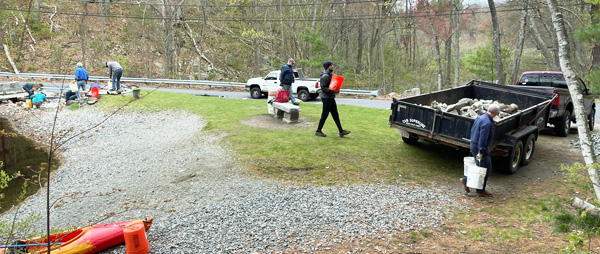
May 8: Volunteers scour the spillway for pieces of the old concrete deck, carrying the chunks to a waiting trailer. Photo by Michele Scavongelli.
The volunteers hefted the larger pieces, one by one, across the crest to a waiting trailer, while smaller chips were loaded into buckets.
A new concrete deck will be poured, and the voids filled, after which the water level in the Pond can be raised, ending the winter drawdown.
Winter Drawdown Gets Underway
October 2020
The annual winter drawdown of Foster's Pond began with the removal of two stoplogs from the Dam's narrow sluiceway just ahead of a record-breaking snowstorm and a hard freeze.
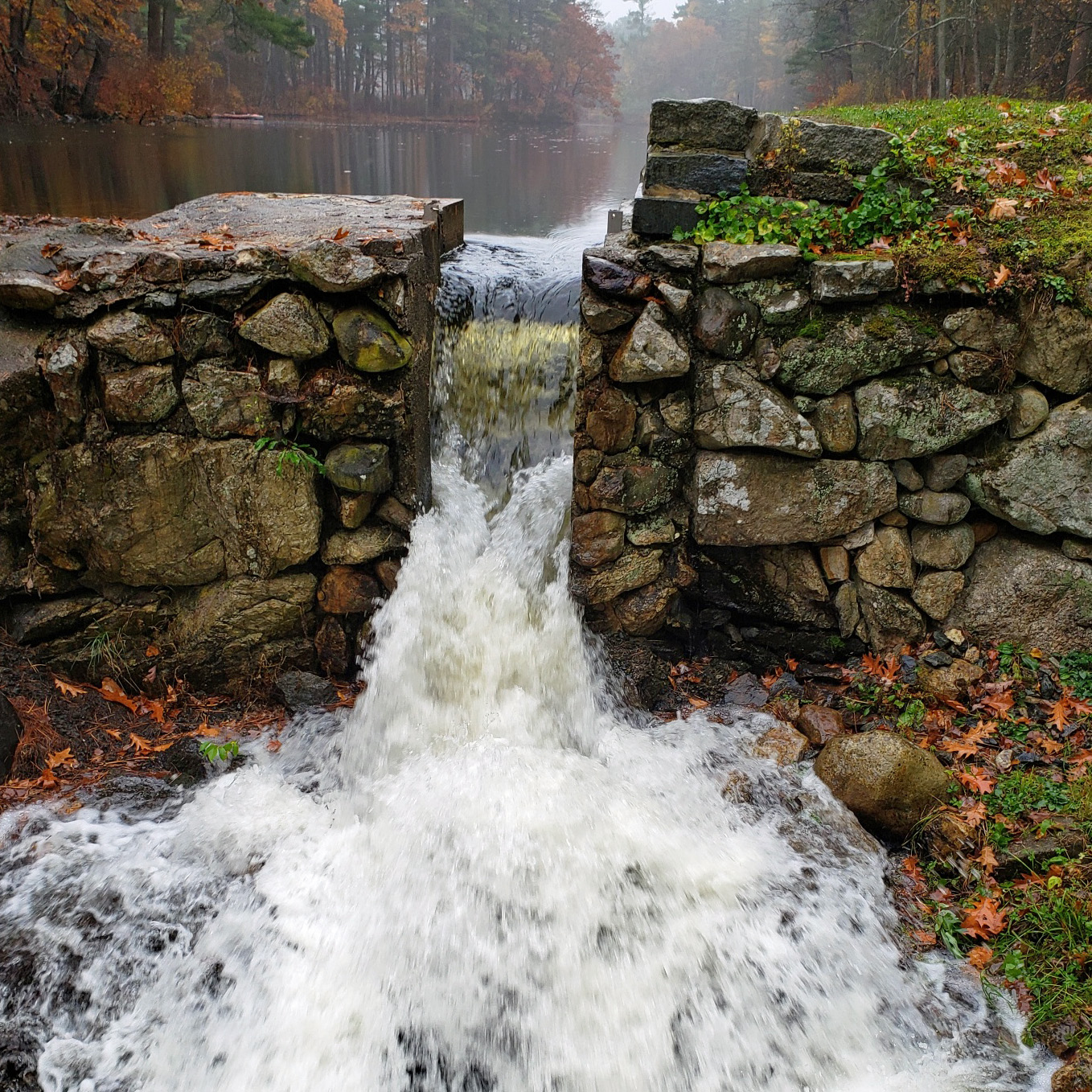
October 28: Water pours through the sluiceway of the Foster's Pond Dam following the removal of two stoplogs to start the annual winter drawdown.
The drawdown lets the Pond absorb ice, snow, and the run-off when it all melts, without imperilling the 160-year-old earthen dam in the event of heavy spring rains. The combination of melting snow and torrential rain can overtop a dam, with potentially catastrophic consequences.
The stoplogs were removed a couple of days ahead of the usual schedule. Impending snow and icy weather would have rendered the operation too hazardous.
The dam's third stoplog will be removed in mid-November.
Refilling the Pond: After Three Weeks, It's Done
April 2020
The picture-postcard waterfall was restored to the Foster's Pond Dam at the end of March, marking the conclusion of the 2019-2020 winter drawdown. The refill, which began March 9, took just three weeks, pretty much the norm for the annual process.
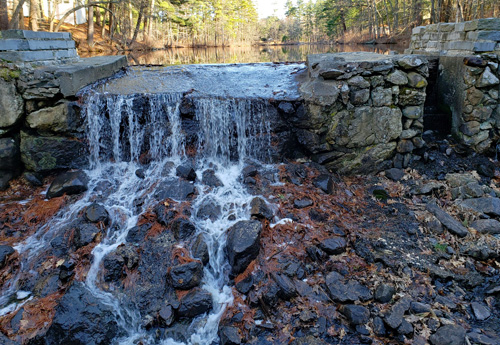
March 31: Water flows over the dam's 12-foot-wide spillway, three weeks after the refill began. Regulating the water level relies on a pretty basic technology - the insertion of "stop-logs" in the narrow sluiceway to the right of the waterfall.
The Pond rose about 17 inches as of March 31, enough to start the flow over the dam's 12-foot-wide spillway. The water level increased by another three inches after the first week of April brought heavy downpours.
The water level will go up and down throughout the spring and summer, depending on precipitation. Indeed, if abnormally heavy rains threaten flooding conditions, it may become necessary to remove a stoplog temporarily to protect the dam. More typically, dry conditions in mid-summer will eventually lower the water level to the point where water stops flowing over the dam.
It's the beginning of the end for the 2019-2020 winter drawdown. The first two stop-logs were inserted into the narrow sluiceway of the Foster's Pond Dam on March 9, starting the process of raising the water level. The third stop-log will be added in a couple of weeks.

March 9: After a warm winter with below-average snow, the annual winter drawdown switches into reverse. The refill starts with the insertion of two of the dam's three stop-logs, and usually takes about three to four weeks.
The Pond is expected to rise about a half inch to an inch a day, reaching its "normal" spring level in three to four weeks. That's about 18 to 20 inches higher than the winter level.
Of course, the water level is always variable, depending on precipitation. One factor which won't add to the volume: ice melt. The main reason for the annual drawdown is to accommodate spring runoff, which in heavy snow years can threaten the earthen dam with potentially catastrophic overtopping. With a historically mild winter and below-average snowfall, that's not a threat this year. Unless it rains - a lot.
Right on Schedule: Pond Ebbs to Winter Level
December 2019
The 2019-2020 annual winter drawdown brought the Pond down to its target level right on schedule, lowering the water to about 18 inches below the spillway of the dam by early December.
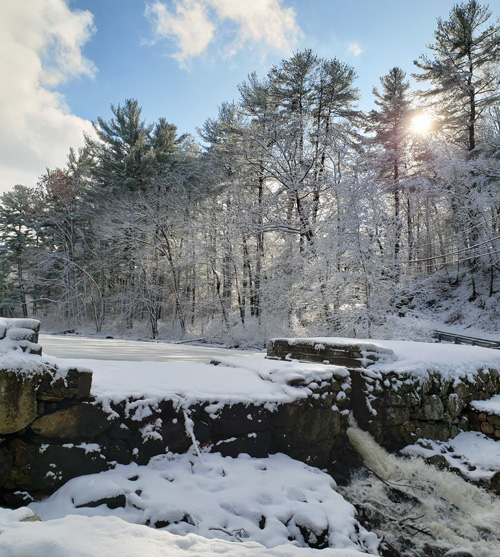
December 11: Well before the Pond froze, it had settled down to its winter level. With all three stoplogs removed, water will escape through the dam's narrow sluiceway throughout the winter.
The schedule - which calls for the drawdown to begin November 1 and lower the Pond by December 1 - is based on State guidelines and is designed to allow wildlife to move to deeper water or relocate food caches before the Pond freezes.
Mother Nature, however, doesn't always cooperate. Last year, for example, heavy November rains kept the Pond level up for nearly an extra month.
This year the drawdown went like clockwork. The first of the dam's three stoplogs was removed from the dam's narrow sluiceway on November 3 to start the process. The second stoplog came out on November 11, and the final one was withdrawn on November 23.
By December 1, the water level was just where it was supposed to be.
The primary aim of the annual ritual is public safety, giving the Pond more room to hold snow, ice, and run-off when it all melts in the spring. Without the extra capacity, the spring melt could put debilitating pressure on the dam.
There's no prescribed schedule for refilling the Pond, though the first stoplog is usually inserted in late March or early April. But the refill may be delayed if the dam requires some extra maintenance or a heavy snow load needs extra time to melt.
Annual Winter Drawdown Starts
November 2019
The annual winter drawdown of Foster's Pond got underway November 3 with the removal of the first stoplog from the narrow sluiceway of the Foster's Pond Dam.
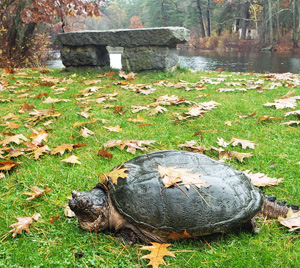 |
| October 31: A snapping turtle had the dam to itself on Halloween. The slow pace of the drawdown aims to safeguard turtles and other critters. |
Two more stoplogs will be taken out over the next month or so, dropping the water level by a bit less than two feet for the winter.
The object of the yearly exercise is primarily public safety. The Pond will have more room to handle winter's snow and ice, and the usual run-off when it all melts in the spring. The extra capacity lessens the likelihood that the 160-year-old structure will be overtopped - a dangerous condition that can devastate an earthen dam.
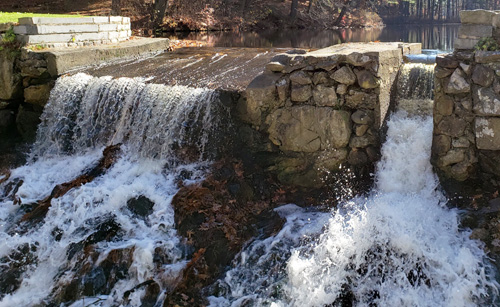
November 3: After the first stoplog was removed to start the winter drawdown, water gushes through the sluiceway to the right of the Dam's 12-foot-wide spillway.
An added benefit, if the weather turns sufficiently cold, is that nuisance vegetation in shallow coves exposed to wintry air may be killed.
The water level is reduced slowly in order to allow resident wildlife to adjust before everything freezes.
Come spring, the stoplogs will be reinserted, bringing the Pond up to its "normal" level by mid-May.
In Case of Emergency . . .
September 2019
It's the middle of the night. Storms have been raging for days. The ground is saturated. Rivers are rising, and Frye's Brook (the main water source for Foster's Pond) is a raging torrent. The "stilling basin" between Rattlesnake Hill Road and the Foster's Pond Dam is now a witch's cauldron, completely filling the two 48-inch culverts under the road. The Dam is close to overtopping, saved only by the emergency spillway which channels the rising water onto the roadway. A crack emerges across the top of the Dam. Then, the unthinkable.
The Dam gives way.

August 31: On a sunny Labor Day week-end, there doesn't seem much prospect that the iconic 160-year-old Foster's Pond Dam might ever succumb.
For 160 years, that nightmare has never come true. But what if it did happen? While the likelihood of a catastrophic failure of the Foster's Pond Dam is extremely low, such failures do occur, and Massachusetts regulators have imposed new requirements for dam owners to prepare Emergency Action Plans for responding to a dam breach.
The Foster's Pond Corporation commissioned its long-time engineering consultant, GEI, to draft an EAP for the Foster's Pond Dam. The plan is updated annually, in consultation with local emergency officials. Click here to download the Emergency Action Plan.
GEI and the FPC worked closely over the spring and summer to draft a plan that would ensure that emergency responders know what to expect, that downstream residents would be provided targeted information through the CodeRed alert system, and that key Town officials would be notified immediately.
A key element of the EAP is an inundation map portraying the extent, in a worst-case situation, of the area that would be affected by a sudden dam breach.
If the Foster's Pond Dam (located in the lower right of this map) suddenly gave way, our engineering consultant estimates that downstream wetlands would be flooded all the way to the Shawsheen River (the dark area in the upper left). The full extent of the inundation is depicted in blue. Rattlesnake Hill Road could be under 3 feet of water, while two stretches of Woburn Street and one stretch of River Street would be under 2 feet or less. No homes would be inundated. Click on the image to open an enlarged version.
As the map indicates, no houses would be inundated, but some stretches of road downstream from the Dam would likely be flooded. Immediately downstream from the Dam, Rattlesnake Hill Road could be under two to three feet of water, and portions might be washed away.
Two parts of Woburn Street (which have flooded in previous high-water events even though the Dam held) could also be under a couple of feet of water: between 131 and 146 Woburn Street and between 116 and 121 Woburn Street. If both stretches were covered by that much water, residents of Parthenon Circle and Powers Road would be unable to get in or out until the water subsided.
Lastly, a stretch of River Street between Taylor Cove Drive and Lowell Junction Road could be under two feet of water, temporarily blocking access to Laconia Drive, Sparta Way, Messina Drive, and Odyssey Way.
Emergency? Call 911 The Foster's Pond Dam has neither electronic sensors nor security personnel monitoring it 24/7. Especially at night, on week-ends, or during holidays, the first sign of real trouble - water flowing over Rattlesnake Hill Road or Woburn Street, or gushing through a crack in the dam - is likely to be seen first by a passerby. So what do you do if you're out walking your dog, biking, or driving downstream from the Dam and see water flowing over the road with no traffic cones or detour signs? First and foremost, STOP! You should NEVER walk, bike or drive through flowing water. Then call 911 and report the situation. That will trigger the response procedures in the EAP. |
|---|
The EAP calls for the Town to notify residents, using the CodeRed alert system, that these specific areas of roadway have been or may be flooded in the event of a potential or actual dam failure.
As part of the EAP, the FPC has made arrangements for calling in an experienced contractor and purchasing sand and gravel, but as a practical matter, it would be nearly impossible to maneuver people and heavy equipment into a safe position on Rattlesnake Hill Road during a breach event until the Pond had largely drained.
Andover's Emergency Management Director - the official in charge of implementing the emergency response to a failure of the Dam - is Police Chief Patrick Keefe.
Keefe and other key Town officials - including Fire Chief Mike Mansfield, Town Manager Andrew Flanagan, and Public Works Director Christopher Cronin - were provided draft copies of the the EAP to review before it was submitted in final form to the Massachusetts Emergency Management Agency and the Department of Conservation & Recreation's Office of Dam Safety. ODS approved the EAP on September 6.
The Foster's Pond Dam undergoes a state-mandated safety inspection every five years. In each of the last two inspections, the Dam has been found to be in "satisfactory" condition. The next inspection is slated for December, 2021.
That's Water Over the Dam
April 2019
The Pond's iconic waterfall was fully restored as of April 23, marking the end of the 2018-19 winter drawdown. A 2.5-inch rainfall increased the flow over the Dam's 12-foot-wide spillway from a trickle, which had begun on April 17, to a cascade.

April 23: Water cascades over the Dam's 12-foot wide spillway, as the Pond refills to end the 2018-19 winter drawdown.
The refill began on March 29, with the insertion of two stoplogs in the Dam's narrow sluiceway. By April 10, the Pond had risen about 10 inches, necessitating the insertion of the third stoplog. A week later, as the Pond came up another six or so inches, water started dribbling over the spillway.
Mother Nature will determine whether the Pond rises much higher. As history shows, if she gets carried away it may become necessary to remove a stoplog to prevent a recurrence of the overtopping which nearly took out the Dam in the 2006 Mother's Day flood.
2019 Refill Gets Underway
March 2019
Two stoplogs were inserted in the dam's narrow sluiceway March 29, marking the start of the 2019 refill of Foster's Pond. A third stoplog will be added in a week or two.
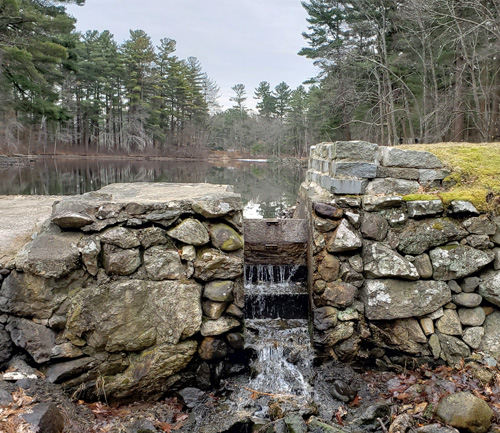
March 29: Two stop-logs are inserted in the sluiceway to begin the 2019 refill of Foster's Pond, reversing the winter drawdown. A third log will be inserted in a week or two.
The refill, which is expected to take about three weeks, reverses the annual winter drawdown, bringing the water level up for the next seven months. Depending on the amount of rainfall, the Pond normally rises about an inch day until flow is restored over the spillway.
Drawdown? Not So Fast
December 2018
One month into the 2018-19 winter drawdown, the Pond level barely dropped. An unusually wet November left the Pond as high as it was when the first stop-log was removed November 1.
Nearly 9 inches of rain fell in November - compared with just 2 inches during November 2017. In effect, the drawdown as of early December had fallen a month behind schedule.
The second stop-log was removed from the dam's narrow sluiceway December 5 to accelerate the drawdown, and the water level finally started to drop, falling about an inch a day during the ensuing days of dry weather. The final stop-log was removed on December 15.
Drawdown Starts on Schedule
November 2018
The 2018-19 winter drawdown began on schedule November 1 for the first time in six years with the removal of the first stop-log from the Foster's Pond Dam.
Under guidelines set by the State, that's the normal target date for beginning an annual drawdown. The timing is aimed at lowering the water level slowly over the course of a month, allowing wildlife to move to deeper water, locate alternate lodge sites, or relocate food caches before the Pond freezes.
But conditions have not been normal in recent years. For the last five years, Mother Nature has intervened, starting the Foster's Pond drawdowns way ahead of schedule, with droughts lowering the water level prematurely. The last time a winter drawdown got underway on the prescribed timeline was in 2012, just before Hurricane Sandy hit.
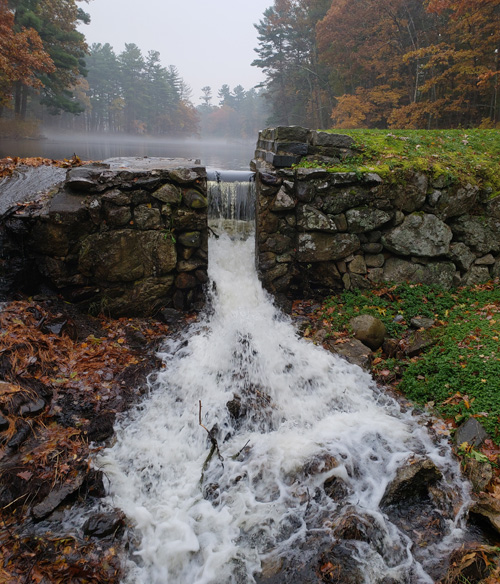
November 1: With frequent rainfalls maintaining the Pond at "normal" levels for the first time in several years, the 2018-19 winter drawdown started on schedule. One of three stop-logs was removed from the dam's narrow sluiceway to begin the process.
Over the next month, two more stop-logs will be removed from the sluiceway, with the Pond dropping between a half inch and an inch a day. The water level will stabilize at about 18 inches below the lip of the dam's 12-foot-wide spillway. Refilling the Pond will begin in late March or early April.
April Monsoon Refills Pond
April 2018
A two-inch spring downpour sent water rushing over the spillway of the Foster's Pond Dam, ending the 2017-18 winter drawdown.
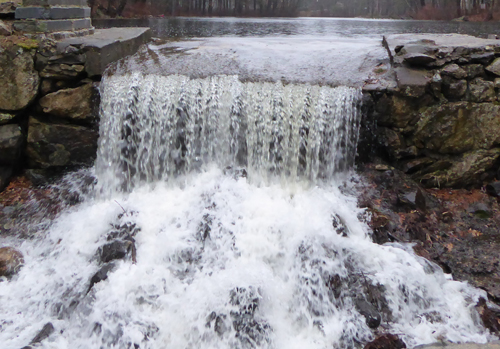
April 16: After more than two inches of rain inundated the area in just six hours, water pours over the spillway of the foster's Pond Dam.
The Pond had been slowly rising since March 30, when two stop-logs were inserted in the narrow sluiceway which regulates the water level. The third stop-log was added on April 5. Just before the big downpour, water had barely reached the lip of the spillway. The April 16 storm raised the Pond another three inches, restoring the dam's iconic waterfall.
Refill Begins as Snowpack Dwindles
March 2018
Foster's Pond is on the rise, as the winter drawdown comes to an end and the process of refilling the Pond begins.
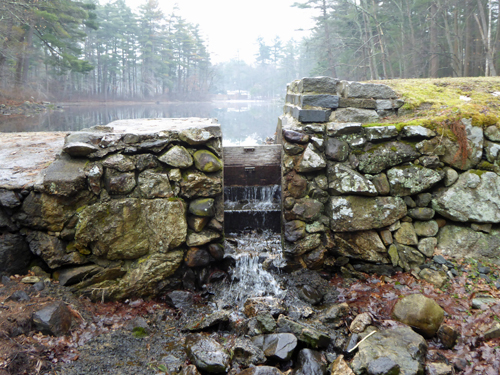
March 30: The first two stop-logs are inserted in the sluiceway, starting the refill of Foster's Pond after the winter drawdown. A third log will be inserted as the Pond nears to the top of the second one.
On March 30, two stop-logs were inserted in the narrow sluiceway which regulates the water level. As the water comes up, a third stop-log will be added. Depending on the weather, the Pond will rise between a half-inch and an inch a day until water begins pouring over the 12-foot-wide spillway.
The last of the snow that blanketed the spillway disappeared on March 28. That allowed local mason Scott Fumicello - who has devoted countless hours to restoring the dam in recent years - to swoop in the following day and apply concrete to a few cracks before the refill began.
The Pond is drawn down each winter as a public safety measure, creating some extra capacity for the Pond to absorb snow melt and spring rains without putting undue stress on the dam. Now that most of the snow has gone, that purpose has been served, and the refill can safely begin.
Pond Ebbs to Winter Level, But Beavers Stage Nightly Protests
December 2017
Foster's Pond has been drawn down for the winter, its water level about 18 inches below the lip of the dam's twelve-foot-wide spillway. The last stoplog was removed from the adjacent sluiceway on November 25.
 |
| December 4: (Above) Branches and mud, deposited by beavers, nearly block the dam's narrow sluiceway. (Below) With the beaver's work undone by volunteers, water again flows through the sluiceway. |
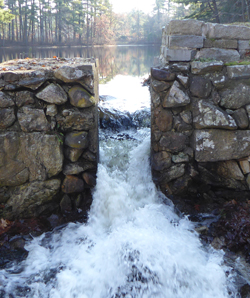 |
Water will continue to flow through the sluiceway throughout the winter. Next spring, the three stoplogs will be reinserted in the sluiceway to bring the water level up for the summer.
The Pond's beaver community, however, doesn't think much of the annual drawdown, which protects the dam by making room for accumulated snow and ice to melt without overtopping the 160-year-old earthen structure.
The beavers are relentless. Almost every night, beavers denning near the dam cram branches and mud into the sluiceway, seeking to stop the outflow. And every morning, their work must be undone in order to maintain the winter water level.
There are an estimated four or five beaver dens around the Pond, including a couple of large lodges in the Main Pond and less-visible burrows elsewhere. Beavers occupying a burrow on Rock Island are likely responsible for the nightly deposits in the sluiceway. Once skim ice blocks their way, they will give up for the winter.
The dam is more fragile than it looks. In past years, it has been seriously damaged by spring storms, and Corporation volunteers have spent countless hours on repairs and maintenance. Last month, Scott Fumicello - a local resident, mason, and landscaper who has been a mainstay of efforts to preserve the dam - added nearly three tons of crushed stone to the shoreline of the dam to enhance erosion control.
Winter Drawdown Starts, As Dry Conditions Hang On
November 2017
Mother Nature jump-started the 2017-18 winter drawdown, as dry weather left the water level in the Pond below normal going in the fall. According to the U.S. Drought Monitor, Essex County and much of Middlesex County were "abnormally dry," though the rest of Massachusetts was experiencing normal conditions in mid-November.
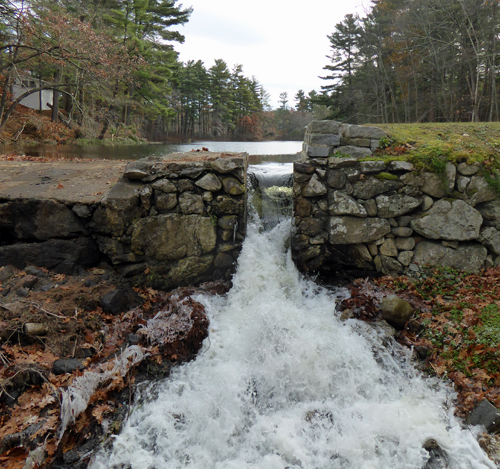
November 17: With two of the Dam's three stoplogs removed, water cascades through the sluiceway, gradually lowering the Pond for the winter. The stoplogs will be put back next spring.
The first stop-log was pulled from the Foster's Pond Dam in late October, but that had no effect on the Pond, as the water level was already below the top of the next log. Water began rushing through the dam's narrow sluiceway on November 17, when the second stoplog was pulled.
The water level will drop between an inch and two inches a day over the next couple of weeks, with the aim of bringing the Pond down to its winter level before it freezes. The annual drawdown is conducted in accordance with an Order of Conditions approved by the Andover Conservation Commission.
A major reason for the winter drawdown is to protect the 160-year-old earthen dam from spring flooding, which damaged the iconic structure in 2004 and 2006, and tested it severely in 2007, 2008 and 2010.
Drought Ends and Pond Fills
April 2017
The drought which plagued much of the State for months officially came to an end, but despite a spate of welcome rainfalls, and even a flood warning for the Merrimack Valley, the region remained "abnormally dry," according to the U.S. Drought Monitor.
Even without inserting the third stoplog into the sluiceway of the Foster's Pond Dam, water started cascading over the 12-foot-wide spillway on March 30.
But shortly after that last stoplog was put in place on April 4, forecasters warned of possible flooding, and out it came. The stoplog went back in on April 9, and the Pond refilled to one of the highest levels in several years.
The water level and the weather bear close watching. If heavy spring rains are predicted, a log or two will be temporarily removed to avoid stressing the dam, as occurred in the Mother's Day Flood of 2006.
Water Level Raised Early, As Drought Hangs On
March 2017
With abnormally dry weather persisting in much of Massachusetts, the annual winter drawdown of Foster's Pond is being brought to an early conclusion.
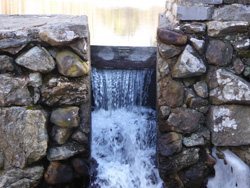 |
| March 8: The second of the dam's three stoplogs is inserted in the sluiceway. |
In fact, this year's refill of the Pond is a week ahead of last year's, and that was the earliest in the decade since the dam was restored to allow winter drawdowns.
The second of three stoplogs was inserted in the dam's narrow sluiceway on March 8. The first log - actually, a ten-inch high board - was left in for the entire winter, due to the on-going drought.
The third and final log will go in within a week or two, unless very heavy precipitation is in the forecast.
When the 2016-17 winter drawdown began last November, this area was in the midst of an "extreme drought", according to the U.S. Drought Monitor. The extremely dry conditions lasted through the end of the year, easing somewhat with winter's snow. As of March, the area was still experiencing a "moderate drought."
Dam Earns "Satisfactory" Safety Rating
March 2017
The Foster's Pond Dam has passed a State-mandated safety inspection.
The dam received a "Satisfactory" rating, the second highest mark that can be assigned to a Massachusetts dam, and, as a practical matter, the highest that can be attained by an earthen dam engineered and built before the Civil War.
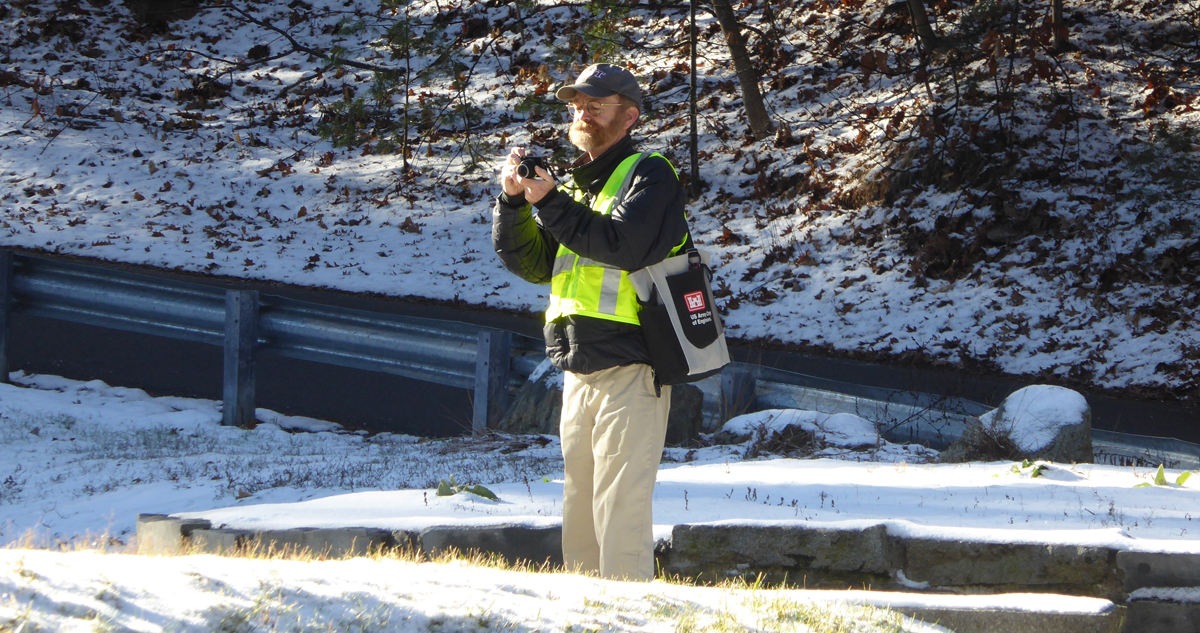
December 6: Lee Wooten, the FPC's consulting engineer, starts his inspection of the Foster's Pond Dam.
The inspection was conducted December 6 by GEI Consultants, Inc., a nationally-recognized engineering firm headquartered in Woburn. Dam owners are required to hire qualified engineers to conduct safety inspections every five years, and the FPC has relied on GEI in the past.
GEI's 65-page report was submitted to the State's Office of Dam Safety on March 2.
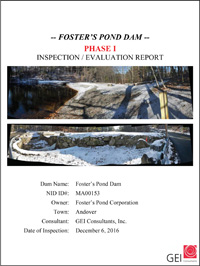 |
| March 2: The engineer's safety inspection report was submitted to the State. Click on the image to read it. |
The report found only one "minor deficiency," an ongoing problem of seepage and the development of occasional sinkholes on the westerly embankment. The report recommends that the FPC "continue to monitor" for seepage and file sinkholes with clay if they develop.
The report's Executive Summary concludes simply, "We recommend that the FPC continue its conscientious monitoring and maintenance of [the] Foster's Pond Dam."
The "Satisfactory" safety rating is the same as the dam received after its last inspection, in 2011. Five years earlier, following the Mother's Day Flood of 2006, and years of prior neglect, the dam received a rating of "Poor."
Since then, as the report notes, the FPC has performed major upgrades on the dam.
Drawdown Quandary: Should We Expect Continued Drought - Or Another Flood?
December 2016
The 2016-17 winter drawdown has brought the level of Foster's Pond down to what - it is hoped - is the Goldilocks point: not too high, and not too low.
The quandary is that the dam is not equipped with a crystal ball, and there's no a reliable way to predict whether spring will bring flood waters or more drought.
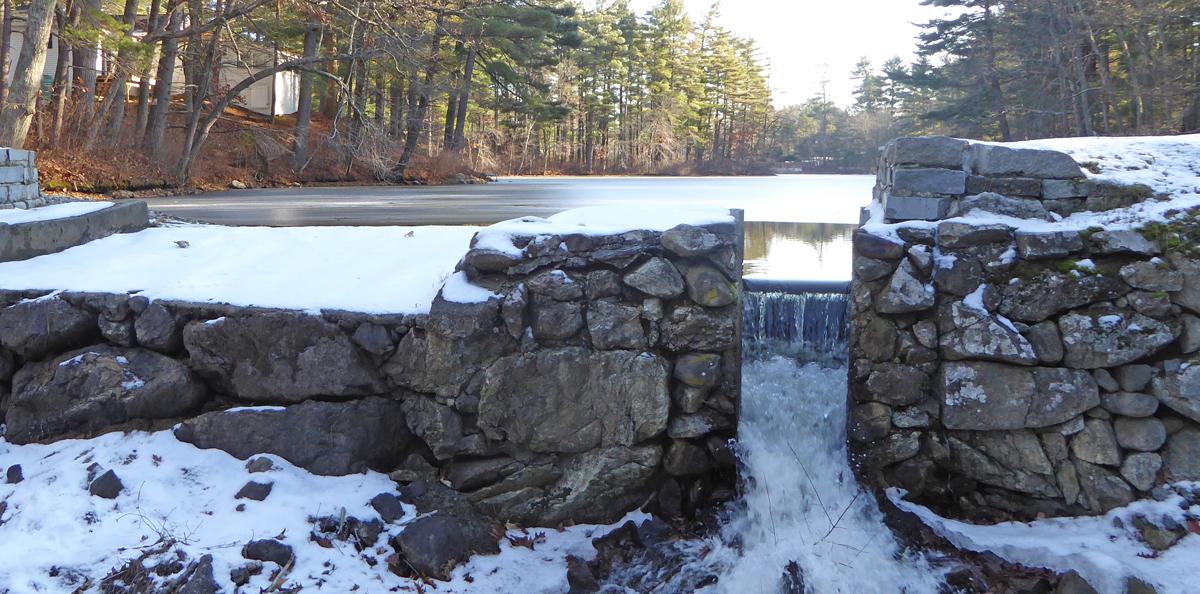
December 14: The 2016-17 drawdown won't bring the water level down as low as recent winters. One stop-log has been left in place, priming the Pond for a quicker return to normal levels even if the drought persists.
For the first few years after the Corporation in 2005 restored the dam's capacity to lower the Pond for the winter, the Pond responded to a fairly reliable weather pattern which brought rains and snow melt in the spring, followed by drier but not too-dry weather in the summer.
A major reason for the winter drawdown is to protect the earthen dam from the ravages of spring flooding, which seriously damaged the iconic structure in 2004 and 2006, and tested the dam severely in 2007, 2008 and 2010. If the Pond is low enough when spring rains hit, a deluge safely refills the Pond with no harm to the dam.
But more recently, the Pond has faced a different threat: drought. Despite the occasional gully-washer, cumulative rainfall has been low. The Boston Globe reported in August that, according to the US Drought Monitor, "the persistent lack of rainfall has left the Merrimack Valley area in 'extreme drought,' the most severe designation in Massachusetts since the group began mapping drought conditions in 1999." In the last few years, the Pond's winter drawdowns have not been followed by massive snow melts or torrential spring rains. Instead, relentlessly dry weather has meant that the Pond has barely returned to normal during recent summers, with the picture post-card waterfall over the 12-foot-wide spillway reduced to a mid-summer trickle - if there is any flow at all.
That's not just a disappointment to photographers. Without a significant flow of water in and out of the Pond, the conditions are ripe for blooms of blue-green algae, and the exposure of shallow-bottomed coves can allow dry-land plants to take root. Last fall, much of the Pond was too shallow to allow the effective operation of a hydro-rake, a longtime tool of shoreline owners to remove accumulations of muck and weeds. It was the first time since hydro-raking began in 1992 that hydro-raking was postponed on account of no rain.
So what to do? This year, only two of the dam's three stop-logs have been removed from the narrow sluiceway in the dam, allowing the water level to drop about 10 inches for the winter, but not a full 20 inches as in past years. The hope is that the modified drawdown will be enough to accommodate snowmelt and rains next spring, but that if dry conditions prevail, the Pond can be refilled to a healthy level.
Now, if only Mother Nature gets the memo.
Winter Drawdown Ends, But Not Winter
April 2016
The 2015-16 winter drawdown came to an end, but Old Man Winter apparently didn't get the memo.
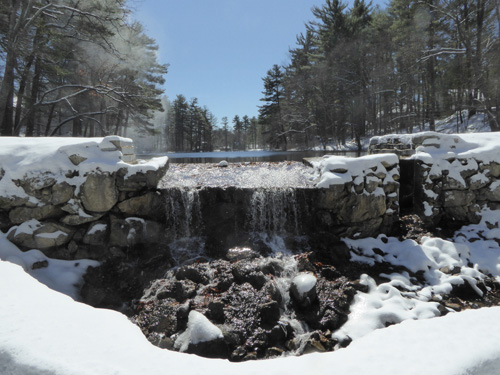
April 5: An early end to the annual drawdown and a later-than-normal snowfall led to the unusual sight of water flowing over a snow-covered Foster's Pond Dam. That's snow blowing off the trees in the background.
With water starting to flow over the dam's spillway - heralding a full Pond primed for warmer weather - a pair of wintry storms in early April dumped about 4 inches of snow in the area. And that yielded the unusual, but picturesque, sight of water cascading over a snow-covered Foster's Pond Dam.
It's something rarely seen in the ten years since the Corporation has been lowering the water level for the winter. One of the chief reasons for the drawdown is to keep the Pond low until the danger of spring rains and snow melt has passed, so as to reduce the risk of overtopping the 160-year-old earthen dam.
Normally, the Pond is refilled well into April, when the possibility of snow is nil. This year, however, after a winter with little snow, the refill got off to an early start. The first of the dam's three stoplogs - the ten-inch tall removable boards in the narrow sluiceway adjacent to the spillway - was inserted on March 9. As the water rose, the second board went in March 16, and the last one a week later. The first trickle of water crossed the spillway March 30, marking an 18-inch rise in the level of the Pond..
And then it snowed. Not to worry, however. The fluffy stuff had little effect on the water level, which will continue to rise a bit, assuming normal spring precipitation. The water level will fluctuate throughout the summer and gradually fall if there's a dry spell. The stoplogs will be taken out again in the fall for the next drawdown.
2016 Refill Gets Early Start
March 2016
The 2015-16 annual winter drawdown began its reversal with the insertion of the first stoplog in the Foster's Pond Dam.
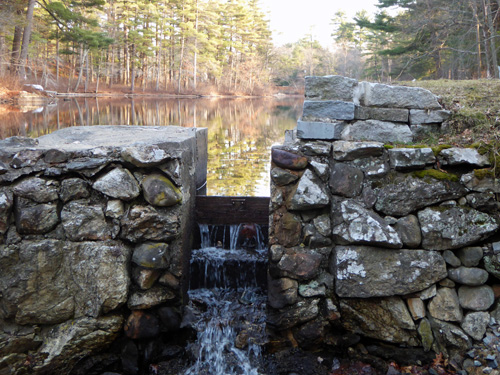
March 9: With the insertion of a stoplog in the sluiceway of the Foster's Pond Dam, outflow was cut to a trickle. As the Pond slowly rises, two more logs will be inserted until the refill is complete.
The March 9 commencement of the refill process was the earliest since the Foster's Pond Corporation resumed winter drawdowns a decade ago. But with below-average precipitation, above-average temperatures, and no snow cover, the danger of spring flooding has been much reduced.
One cautionary note: A small sinkhole appeared on the crest of the dam, in the same area that has been plagued by recurrent sinkholes over the last several years. The Corporation will keep a watchful eye on the spot to determine the extent of repair work that will be needed.
2015-16 Winter Drawdown Is Under Way
November 2015
The 2015-16 annual winter drawdown formally began November 17 with the removal of two stoplogs from the Foster's Pond Dam.
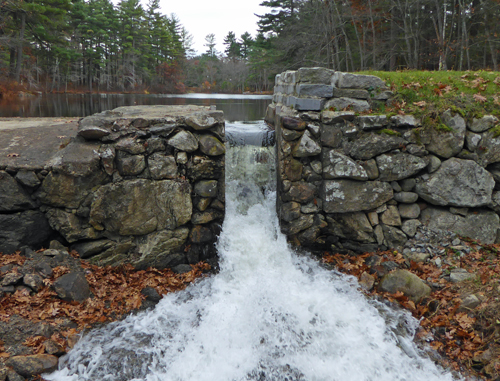
November 7: With two stoplogs removed, water pours through the sluiceway of the Foster's Pond Dam. The third stoplog will be removed later in the month, with the Pond reaching its winter drawdown level around December 1.
Under normal conditions, the drawdown would have commenced around November 1. The idea is to drop the water level slowly by approximately two feet over the course of a month before there's a hard freeze.
But dry conditions in the last couple of years have started the process ahead of schedule without any human intervention, and 2015 continued the trend. The Pond was already a few inches lower than usual for late Fall, at the level it would have reached had a stoplog been removed November 1.
The dam's third stoplog will come out later in the month, with the Pond expected to reach its winter level by about December 1. The refill will begin in May.
The task of removing the stoplogs was eased this year by the installation last Spring of new stainless steel hardware, including channels for the stoplogs that were tailor-made for the Foster's Pond Dam. The new system allows the stoplogs to be safely removed in emergency conditions - for example, if a rapid rise in the level of the Pond requires a release of water to reduce pressure on the dam.
The primary reason for the winter drawdown is public safety. With the water level down, the Pond has added capacity to absorb winter snow and spring rains which - before the restoration of the dam - had caused overtopping. The overtopping of an earthen dam can result in catastrophic failure.
Maintenance Effort Takes Tons of Material
May 2015
After a winter that brought record snow totals to the area, the Foster's Pond Dam received a heavy dose of restorative treatment in May. The focus was an area of small
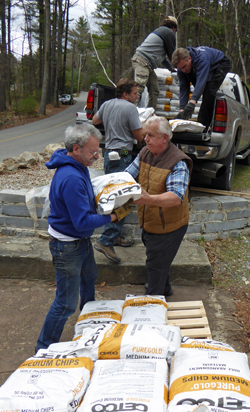 |
| April 30: Unloading 50-pound bags of clay |
Long-planned maintenance efforts - delayed by cold weather which blew in last Fall just after the Pond was drawn down - kicked off April 30 with the delivery of two tons of specialty clay which expands when wet to form an impermeable barrier. Volunteers joined the supplier to stack a hundred 50-pound bags of the stuff on the spillway, which served as a staging area for the work.
Meanwhile, Willard Circle resident Scott Fumicello ferried several tons of rock and sand to the dam. Fumicello, a master mason and landscaper, has volunteered countless hours and the use of his equipment to restore and maintain the dam.
The next step came May 3, as Fumicello and a half dozen other volunteers excavated the leak-prone area on the westerly crest of the dam. Slinging the bags hand-to-hand across the sluiceway, they plugged the eight-foot-deep excavation with clay, backfilling the hole with a mixture of loam and clay.
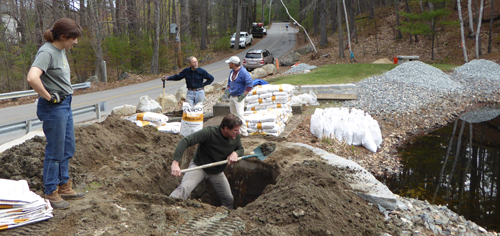
May 3: Volunteers complete the excavation in the leak-prone area on the westerly crest.
Fumicello spread several tons of crushed stone along much of the dam. The stone protects a synthetic cloth which holds clay in place along the entire upstream face of the dam. Volunteers used rakes to finish the work.
The volunteers also filled about 50 sandbags, stacking them at the entrance to the sluiceway to form a coffer dam, providing a safe work area for the installation of new stainless steel hardware for the dam's three stoplogs. Those are the boards which are key to the dam's primitive mechanism for raising and lowering the water level. They are removed, one at a time, in the Fall to draw the Pond down for the winter, then re-inserted in the Spring, when the danger of flooding has passed.
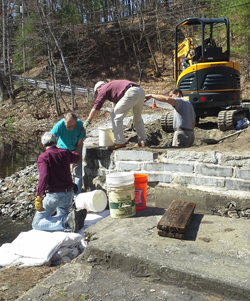 |
| May 3: Volunteers hoist buckets to hydrate clay in the excavation. (Photo by Bob Pincus) |
New U-shaped channels to hold the stoplogs were fashioned for the dam by Custom Iron Craft in Wilmington, replacing rusty brackets that were in danger of failing. New stainless steel attachments to the stoplogs, along with grappling hooks to grab the boards even in high water, were also custom-manufactured to allow safer removal of the stoplogs in an emergency.
With work in the sluiceway complete, volunteers returned May 9 for the final push and removed the sandbags. The now-unneeded sand was used to make a narrow "landing strip" for visitors to rest a canoe or bass boat with less risk of scraping the bottom on crushed rocks where the Corporation allows the launching of non-motorized or electric-powered craft.
The finishing touches on this year's work came May 11, when Organic Soil Solutions loamed and seeded the areas disturbed by the excavator. OSS has donated lawn care services to the Corporation for several years.
Pond Refills After Heavy Rains
July 2014
Two big storms in July refilled Foster's Pond, restoring the iconic waterfall at the dam.
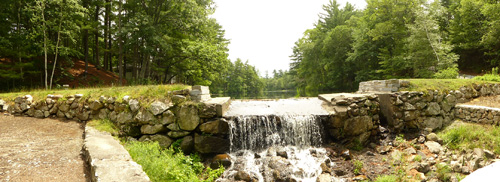
July 17: Water cascades over the spillway of the Foster's Pond Dam, after two July storms topped off the Pond with 5 inches of rain.
The water level had been creeping up since early May, when stop logs were inserted in the dam's sluiceway to end the 2013-14 Winter drawdown.
A powerful storm over the July 4 weekend, followed by another gully-washer July 15-16, dumped a total of more than 5 inches of rain on the Pond, raising the water level the last couple of inches needed to start the flow over the dam's 12-foot-wide spillway.
The drawdown had been extended a couple of weeks to permit volunteers to repair a sinkhole which had appeared in the dam last April. The repairs seemed to have worked, but as the water rose, a small put persistent leak, which had caused the sinkhole, reappeared at the base of the dam. Such leaks, which are not unusual in earthen dams, can result from burrowing animals or the rotting roots from long-gone trees that once grew on the crest.
Next November, when the Pond is once again drawn down, another effort will be made to trace and plug the leak.
Drawdown Ends As Repairs Proceed
May 2014
The 2013-14 Winter drawdown came to an end as stop logs were inserted into the dam's sluiceway on May 6, cutting the outflow from Foster's Pond to a trickle so that the Pond can refill.
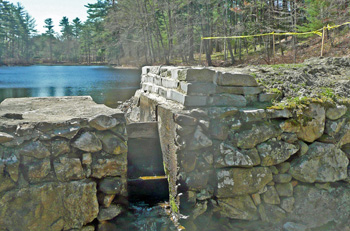 |
| May 6: Withe the insertion of the first two stoplogs, the Pond will start the gradual process of refilling for the Summer. The caution tape to the right indicates the area where repairs are continuing. |
Raising the water level about two feet is expected to take the rest of the month, but the pace is entirely dependent on the weather. The Mother's Day flood of 2006 is an historic reminder that heavy Spring rains can raise local streams - and the Pond - a foot or more in a matter of hours.
In the meantime, volunteers continued their work to repair a sinkhole which appeared in April.
A three-man crew, spearheaded by resident mason and landscaper Scott Fumicello, used an excavator to get to the bottom of the problem, a small rivulet coursing through the dam. Fumicello has donated hundreds of hours of his time, and equipment, to the restoration and maintenance of the historic structure.
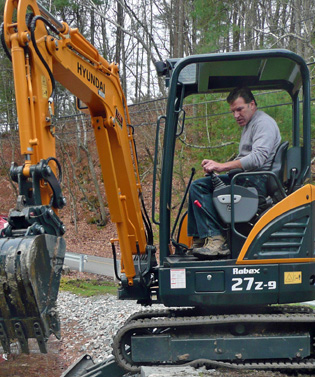 |
| May 3: Scott Fumicello eases an excavator into position to dig out a sinkhole in the dam. |
After digging out the sinkhole, Fumicello and his volunteer assistants (White Oak Drive resident John Lugus and FPC president Steve Cotton) returned a day later to mix and pour a couple of hundred pounds of concrete to plug the channel.
Once the concrete set, two of the dam's three stoplogs were inserted, starting the gradual process of raising the Pond.
The next steps in the repair job will be to backfill the hole with clay, then rake it smooth and replant grass, which prevents erosion of the crest. A larger crew of neighborhood volunteers will be needed for that work.
The annual drawdown is a public safety measure, aimed at protecting the dam from "overtopping" when Spring storms combine with melting snow and saturated soil. The drawdown provides leeway for the Pond to absorb a deluge without imperilling the 150-year-old earthen dam.
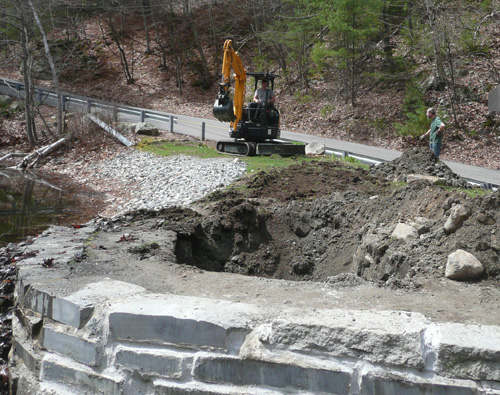
May 3: Fumicello and John Lugus (right) prepare the site for bringing in the concrete.
The only way to control the water level in the Pond is insertion or removal of three stoplogs - 10-inch boards which fit into the two-foot wide sluiceway adjacent to the dam's concrete spillway.
When the dam was first constructed in the 1850s, its 12-foot-wide spillway was made of wood, and gates underneath the dam's picturesque waterfall could be opened, allowing the Pond to be largely drained. The wooden spillway and the gates rotted out by the early 1900s, and the area was filled with concrete in 1916.
The narrow sluiceway, with its wooden stoplogs, was created in 1937. Two years later, residents filled in the narrow opening, leaving themselves no way to control the water level. Some years later, they installed a valve which allowed them to lower the Pond, but rust took its toll, collapsing the iron outlet pipe and freezing the control mechanism. By the early 1970s, the outlet was filled with concrete. With no way to allow flood waters to escape, the dam was overtopped in the Spring of 2004, sustaining heavy damage. The Corporation restored the sluiceway to its present condition in 2005, and has been drawing down the Pond each Winter ever since.
Volunteers Start Repairs on Sinkhole
April 2014
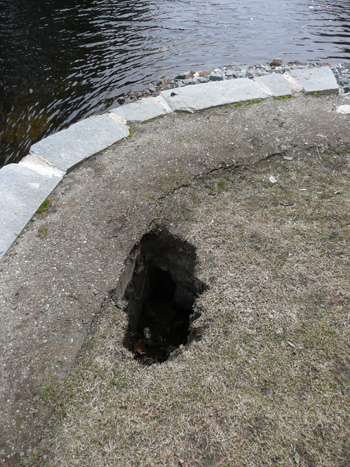 |
| April 7: This sinkhole opened on dam, as frozen soil melted and collapsed into a channel created by a leak in the dam. Volunteers began the repair effort a few days later. |
Ten volunteers pitched in on April 13 to start Spring maintenance on the dam, which was battered by a particularly harsh winter.
A few days earlier, a sinkhole had opened up on the crest of the dam, as thawing earth collapsed into a tunnel carved by a small but persistent leak.
The work crew dug around the face of the dam, applying water-borne dye to pinpoint the source of the leak. They also excavated the sinkhole to expose the subterranean channel.
In addition, the volunteers lugged about a ton of crushed rock, bucket by bucket, to the face of the dam as part of ongoing erosion-control efforts.
In order to plug the leak and fill in the underground channel, more equipment and materials will be brought to the site.
The repairs must be completed before the water level can be raised for the Summer.
Mother Nature Jumps the Gun on Winter Drawdown
November 2013
The 2013-14 winter drawdown officially began on November 16, but after an abnormally dry October, it seemed as if Mother Nature had decided to lower the Pond a month earlier than usual.
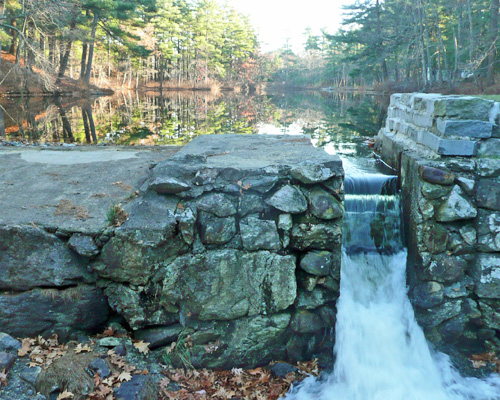
November 16: With the water level several inches below normal, this year's winter drawdown started with the removal of two of the three 10-inch stop-logs in the dam's sluiceway.
The water level of Foster's Pond is brought down this time each year by removing three stop-logs, one after the other over a two or three week period. The stop-logs are 10-inch boards that are slotted into the the narrow sluiceway in the Civil War-era dam. The idea is to lower the Pond a couple of inches a day just before it freezes over, allowing wildlife to adjust to the shrinking Pond before winter settles in.
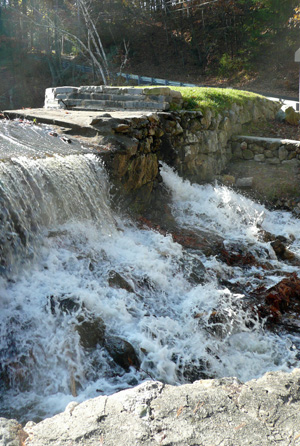 |
| November 9, 2011: Here's what the removal of the first stop-log looks like in a normal year. Water would be cascading over the spillway, to the left of the narrow sluiceway. This year, the spillway was bone dry, and the water level did not reach to the top stop-log. |
In a normal year, water would be cascading over the dam's 12-foot wide spillway in November, and after removal of the first stop-log, it would take a week or so for the water level to fall below the lip of the spillway. But this has not been a normal year.
According to the nearest weather station, barely an inch of rain fell in October, compared to 6 inches in October of 2012 and more than 8 inches in 2011. The result: no water was coming over the spillway this November. In fact, no water had been coming over the spillway since mid-summer. In effect, Mother Nature had already pulled the plug, and the water level was down to where it would have been with the first stop-log out. That and the next one were both removed on November 16.
The water will reach its winter level in early December. The purpose of lowering the Pond is two-fold, increasing the basin's capacity to accommodate winter snows and spring run-off without overtopping the dam, and letting winter frost kill some shoreline weeds. The lower water level also allows the Corporation to make repairs to the dam in the spring. Assuming next year's repairs can be made on schedule, the stop-logs will be re-inserted in May.
Tropical Storm Andrea Fills Pond
June 2013
The remnants of Tropical Storm Andrea dropped more than 3 inches of rain on Andover, topping off the Pond and re-starting the flow of water over the Foster's Pond Dam.
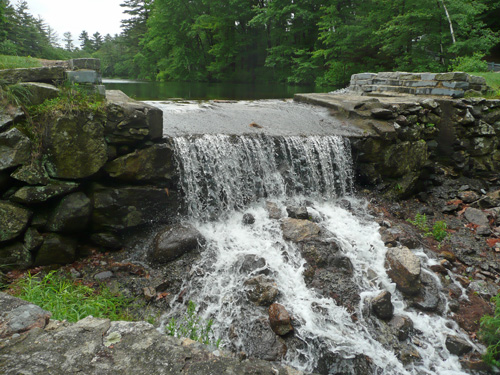
June 8: After a little more than 3 inches of rain fell overnight, the Pond rose the last few inches needed to begin the flow over the Foster's Pond Dam.
Refilling the Pond this year was delayed by the need to make some repairs on the dam. As a result, the refill was completed a bit later than last year, when water started washing over the dam's spillway in mid-May. But the 2013 refill finished a couple of weeks earlier than in 2011, when repair work also delayed the start of the process. In 2011, water began flowing over the dam on June 23.
Drawdown Ends After Volunteers Rock the Dam
April 2013
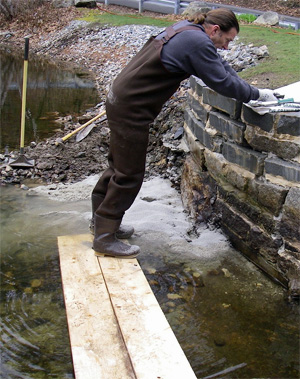 |
| April 23: After digging out around the source of the leak, Scott Fumicello begins the task of laying down 2400 pounds of clay. (Photo: Jack Brady) |
On April 29, after the heavy lifting was finished, the first stop log was inserted into the dam's sluiceway, beginning the process of refilling the Pond after this year's winter drawdown. The water level is expected to rise about an inch a day over the next two or three weeks, at which point water will begin cascading over the 12-foot-wide spillway.
About 15 volunteers participated in the late-April repair effort,
 |
| Pond resident John Lugus navigates the sluiceway as Scott Fumicello positions the first layer of stone on top of a black fabric holding the clay in place. |
Before the stone went down, however, the volunteers had to dig out around the leak and put down alternating layers of clay (to plug the leak) and a special cloth (to keep the clay in place). Twenty-four hundred pounds of clay were used.
Resident landscaper and mason Scott Fumicello led the effort. He has devoted hundreds of unpaid hours, and donated the use of his equipment, to restore and maintain the dam over the last several years.
 |
| Shawsheen River Watershed Assn. President Jack Brady digs in to a truckful of crushed stone. |
The pace of the refill will, of course, depend on the weather. The idea is to restore the water level in May - but to allow room for heavy spring rains. Late-May storms, such as the deluge which caused the 2006 Mother's Day flood, can raise the Pond a foot or more overnight. If the Pond is already at a "normal" level when such a drenching rain begins, the water can rapidly rise high enough to stress the dam.
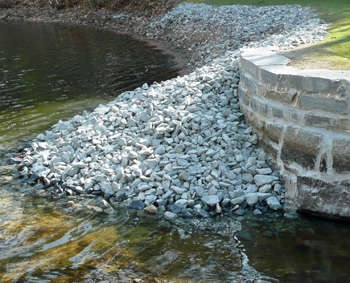 | April 27, 2013: The completed repair. Nearly 12 tons of rock and more than a ton of clay were used. |
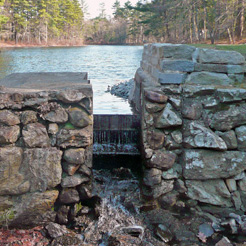 |
| April 29, 2013: The 2012-13 winter drawdown ends, as the first stop-log is inserted in the sluiceway. |
Two more stop-logs will be inserted as the water rises. Some water will be allowed to escape, however, in order to maintain a small flow into the downstream wetlands.
With Superstorm Near, 2012-13 Winter Drawdown Begins
October 2012
With Superstorm Sandy looming just to the south of New England, the Corporation started this year's winter drawdown a few days earlier than usual, giving the Pond some extra capacity to absorb what turned out to be three inches of rainfall dumped by the monster storm.
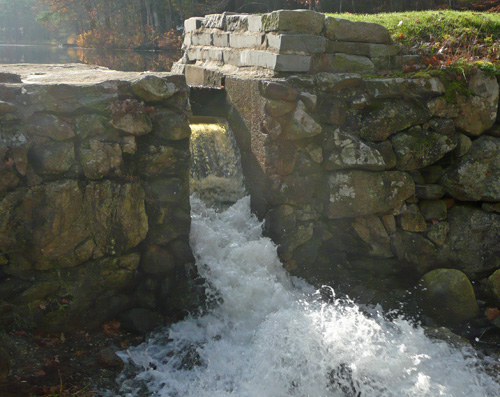
October 27: As Hurricane Sandy moved up the East Coast, the first stop log was removed from the sluiceway, marking an early start to the 2012-13 winter drawdown.
The first stop log was removed on October 27, and a second stop log came out the following day. Normally, the drawdown begins a week or two later, with the aim of bringing the water level down a little less than two feet before the Pond freezes.
The early start is a safety measure to protect the dam from the hazard of overtopping, in the event that Sandy packed evem more than the predicted precipitation. Lowering the Pond a bit early was also aimed at allowing the Corporation to undertake some repairs on parts of the dam which are now under water. The Corporation is hoping to perform the repair work - with the help of neighborhood volunteers - in late November.
Pond Refills Despite Drought
May 2012
Foster's Pond refilled right on schedule in early May, following a drier-than-normal Spring that meteorologists had labeled a moderate drought.
Because of the dry weather, stop-logs had been inserted into the dam's narrow sluiceway a couple of weeks earlier than usual to end the 2011-12 Winter drawdown. The first stop-log went in on March 18, and the third was inserted on April 22.
By May 7, water had begun trickling over the dam's 12-foot-wide spillway. And three days later, after an overnight storm dumped an inch of rain on Andover, the dam's waterfall was restored to picture-postcard perfection.
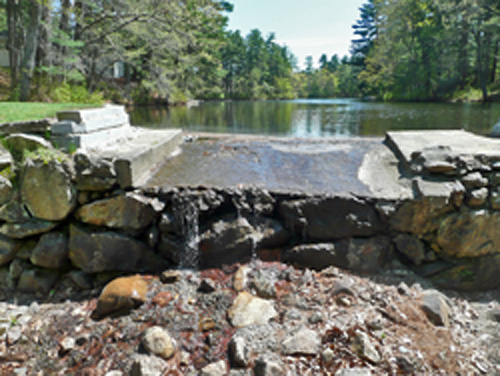 | May 7: Even without much rain, water began trickling over the dam, ending the 2011-12 Winter drawdown.. |
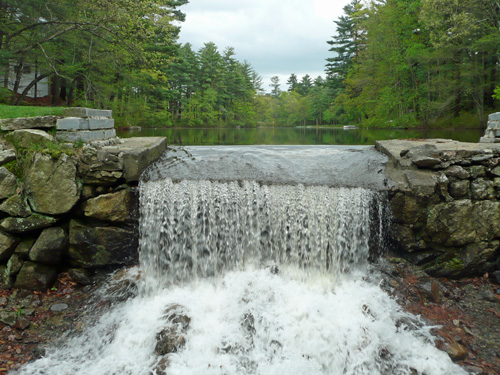 |
| May 10: Following a one-inch rainfall, the dam's picturesque waterfall was once again cascading through the spillway. |
The one-inch rainfall May 9-10 produced a three-inch rise in the water level of the Pond.
The Pond's water level rises higher than the rainfall measured at a near-by weather station. That's because the watershed extends far beyond the shoreline of the Pond. Although the Pond covers 120 acres (less than .2 square miles), the Pond's drainage area totals nearly 1.6 square miles - eight times the size of the Pond itself. And while a lot of rainwater can be absorbed by unpaved portions of that drainage area, heavy rains produce a surge of water into the Pond. That's why Winter drawdowns are maintained into May - so that there is room to accommodate Spring storms without overtopping the dam.
Bucket Brigade Strengthens Dam
March 2012
Volunteers ignored predictions of snow and rain to pass the bucket and patch the dam, putting it in shape to end the 2011-12 winter drawdown and begin refilling the Pond.
Fifteen area residents spread a new layer of crushed stone along the face of the dam. The stone protects a cloth membrane which in turn prevents erosion of the clay core of the dam. Without the stone, the cloth can disintegrate under the sun's ultraviolet rays, or tear as visitors walk on it.
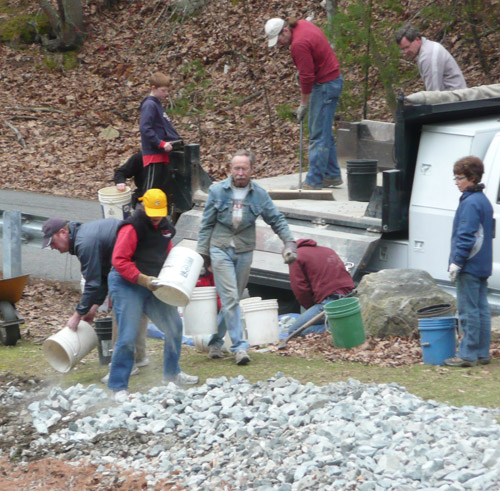
March 31: Volunteers empty the last truckload of crushed stone on the face of the dam. The stone protects a cloth membrane which prevents erosion.
It took the work crew less than two hours to spread seven tons of stone. The next task will be distribution of about a ton of loam to fill depressions in the crest of the dam, where grass provides the erosion control.
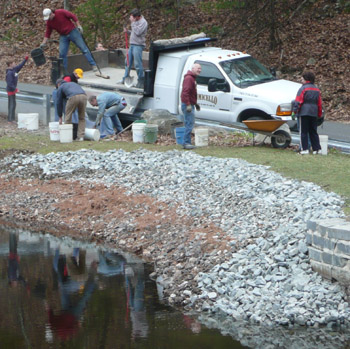 |
| Neighborhood residents pitched in to spread 7 tons of crushed stone on the face of the dam. About half of it went onto the westerly crest (above). |
The first stop log was inserted into the dam's narrow sluiceway on March 28, and the water level was beginning to creep upward. With the face of the dam now protected by the new stone, the refill can continue without interruption - assuming Mother Nature provides some rain.
Under normal conditions, the first stop log would be inserted in mid to late April, so that spring rains don't create a risk of overtopping the dam. With this year's dry conditions, however, it appeared safe to start the refill earlier.
Safety Inspection Rates Dam "Satisfactory"
December 2011
A State-mandated safety inspection has found that the Foster's Pond Dam is in "satisfactory" condition, just one notch below the top rating for Massachusetts dams.
The inspection was conducted on November 18 by GEI Consultants, Inc., a nationally recognized engineering firm based in Woburn. The firm's 67-page report was filed with the State's Office of Dam Safety on December 20.
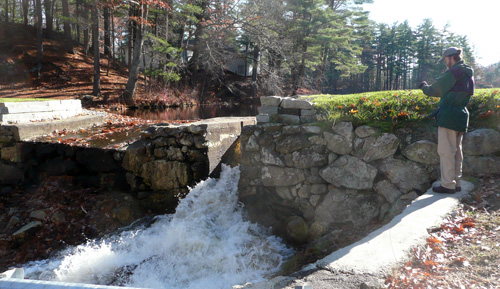
November 18: GEI Engineer Lee Wooten photographs flow through the sluiceway for a state-mandated safety inspection. His report, filed with state regulators on December 20, found the dam in "satisfactory" condition.
The State requires that dams located where failure could cause loss of life or property damage must be inspected, at the owner's expense, every five years. Because the collapse of the Foster's Pond Dam could damage Rattlesnake Hill Road, the dam is subject to this requirement.
The last full-blown inspection of the Foster's Pond Dam, in 2006, rated its condition as "poor", requiring significant remedial work. The dam had suffered considerable damage that year from the Mother's Day flood, which overtopped the dam, eroded the earthen crest, and left sinkholes in its wake.
A 16-month repair effort by FPC volunteers buttressed the walls on both sides of the spillway, removed trees, filled sinkholes, reinforced and grassed the earthen crest, and rehabilitated an emergency spillway designed to relieve pressure on the dam in flood conditions. The dam now serves as a "pocket park", and the emergency spillway doubles as a boat launch for visitors.
The massive restoration work led to a follow-up safety inspection in 2008 which upgraded the dam's condition to "satisfactory." But the dam took another hit in a pair of spring storms in 2010 which opened new sinkholes and a small leak. GEI a few days after the storms reviewed the damage and recommended a series of fixes. The FPC lowered the Pond, and volunteers once again swung into action, digging out the damaged area, pouring concrete, and stopping the leaks.
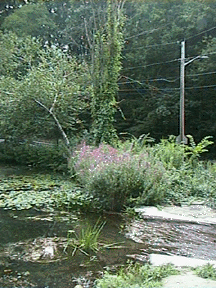 |
| Fall, 2004: Before the Corporation undertook to rehabilitate the dam, this is what the westerly crest looked like. Its condition went from bad to worse in the 2006 Mother's Day flood. |
This month's safety report affirms the success of the FPC's repair efforts, itemizing how the FPC has corrected each problem noted in 2006 and after the 2010 storms.
GEI found only two "minor deficiencies" this time around. First, GEI recommended that the FPC expand a section of the dam's written Operations & Maintenance manual outlining emergency procedures in the event the dam develops a leak or is in danger of overtopping. Second, GEI noted small areas in which grass and loam on the crest had been worn away by foot traffic, exposing a layer of fabric which prevents erosion of the underlying clay; GEI recommended restoring the grass cover in these areas.
The next regular safety inspection of the dam will now be due in 2016.
2011-12 Winter Drawdown Begins
November 2011
The first stop log was removed from the dam on November 9,
 |
| November 9: With one of the dam's three stop logs removed, water begins cascading from the narrow sluiceway to the right of the dam's main spillway. |
The remaining two boards will be taken out of the dam's narrow sluiceway over the next two or three weeks, gradually lowering the water level by about 18" for the winter. The aim is to bring the Pond down to its winter level before the surface freezes solid.
The annual procedure, which is standard practice for the management of many ponds in New England, is a safety measure which allows for a build-up of snow and ice over the winter, and a surge of spring run-offs, without stressing the 150-year-old earthen dam.
The boards will be re-inserted in late April to bring the water level up for the summer.
Welcome Sight: Water Over the Dam
June 2011
For the first time in nearly two years, water has begun flowing over the Foster's Pond Dam.
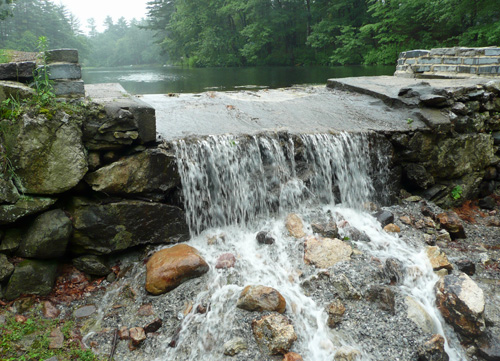
June 23: Water begins cascading over the dam's picture-postcard waterfall for the first time in nearly two years.
Mid-summer dry weather normally drops the water level below the lip of the dam's 12-foot-wide spillway, after which the annual Winter drawdown keeps the flow within the narrow sluiceway until the Pond is refilled each Spring.
But last year, devastating Spring storms required the drawdown to be maintained well into the Summer, and an ensuing drought kept the Pond from filling up throughout 2010.
This year's refill got off to a slower-than-usual start, with the need to repair a small leak before the Pond could be raised. It wasn't until June 23, following more than 2 inches of rain in a 24-hour period, that water began cascading over the dam's picturesque waterfall.
For residents and visitors, the higher water level means easier access to the water, and opens shallower coves to canoes, kayaks, and anglers. And residents with shallow wells have one less worry.
With Leak Repaired, Refill Begins
May 2011
After volunteers patched a small leak in the dam's narrow sluiceway, the process of gradually refilling the Pond for the summer got underway.
 |
| May 7: The first board is inserted in the sluiceway, the beginning of the end of the 2010-11 Winter drawdown. |
The first board was inserted into the sluiceway on May 7, marking the end of the winter drawdown. Two more boards will be inserted, one at a time, as the water level gradually rises over the next two or three weeks.
Some water is allowed to escape during the refill process, as State regulations require that at least some outflow be maintained to downstream wetlands.
Water should begin pouring over the 12-foot-wide spillway by early June. Of course, how fast the water comes up all depends on how much rain falls. A big storm can raise the Pond a foot or two overnight.
 |
| Ground crew: Geese keep the crest of the dam neatly trimmed. This family was working on Mother's Day. |
The grass cover on the crest of the dam - which prevents erosion of the clay fill - has still not fully recovered from last year's major repairs. Much of the surface was stripped off during the project. The crest was re-seeded this Spring, and tender shoots are just beginning to show.
The "grounds crew" has already started manicuring the new growth. Mowing at the dam is performed exclusively by volunteers. Feathered volunteers. Geese keep the grass neatly trimmed, saving the Corporation the cost of commercial mowing. This year, at least two families have been observed cropping the lawn to a near-ideal height.
Pond Refill to Start Soon
April 2011
Spring is in the air, and - soon, very soon - more water will be in the Pond. Refilling after each Winter's drawdown is always a balancing act, in which several factors must be considered.
First, there's the safety of the dam. The Mother's Day Flood of 2006 illustrates the hazard of refilling the Pond too soon. Just after the Pond had been brought up to its "normal" level, heavy Spring rains deluged the Merrimack Valley, and with no "freeboard" to accommodate the massive run-off, the dam overtopped and suffered serious damage.
Second, there's the need to complete maintenance work which can only be performed in good weather when the water is low. This year, a minor leak in the sluiceway must be patched before the water level can be raised.
But, on the other hand, everyone who uses the Pond wants the water level up as soon as reasonably possible, and no one wants a repeat of last Summer - when major dam repairs and drought conditions conspired to keep the water level distressingly low for the entire season.
So look for the first board to be placed in the spillway within the next week or two, and a gradual rise in the water level over the ensuing month. And, of course, if we get a late-May deluge, the water could rise much faster.
Winter Drawdown Barely Shows After Summer Drought
December 2010
As Mother Nature's icy grip froze the surface of the Pond, this year's annual drawdown left the water level just the same as it has been for the last five winters - 18" below the lip of the dam's spillway, with a reassuring stream tumbling through the sluiceway and providing a reminder of the Pond's endless capacity for self-renewal.
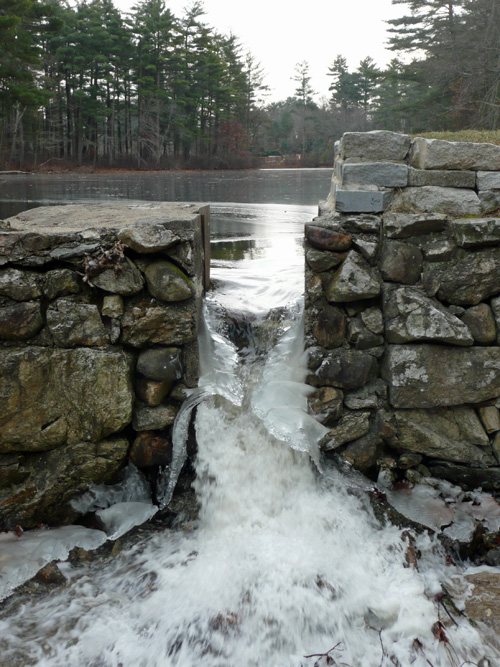 |
| December 19: Ice frames the sluiceway as the 2010 Winter drawdown levels off. |
The difference this year is that the 2009 winter drawdown never really ended. Storms which clobbered the dam last March made it necessary to extend the drawdown until repairs could be completed in June. By the time the Pond could be refilled, rain had vanished from the forecasts. As a drought set in, the water continued to drop throughout the Summer to the lowest level in memory, worrying owners of shallow wells and leaving some normally navigable channels impassable.
It wasn't until late Fall that heavy rains started to raise the water level, ever so slowly. By mid-November, the Pond was up about a foot, but it had started from such a low point that the water rose just a few inches above the level of a winter drawdown. And by then, it was time to begin this year's drawdown, which - under State guidelines - must stabilize at the Winter water level before the Pond freezes.
Barring another calamity - and assuming normal weather patterns - the Pond will be refilled in late May.
Volunteers Pitch In to Repair Damage from Spring Storms
June 2010
 |
| April 20: It took two tons of concrete to fill this cavern under the spillway. |
For weeks, residents and visitors have glumly observed the declining water level in the Pond, kept low ever since punishing March storms punched sinkholes in the Foster's Pond Dam and exposed a large hollow space beneath the dam's concrete spillway. The Corporation's engineering consultant warned that the dam could fail unless the 2009-2010 winter drawdown was extended, allowing repairs to be made with as little water as possible lapping at the dam.
In April, volunteers were able to repair the spillway - first sledgehammering through the concrete cover to expose the full extent of the cavern below, probably the result of decades of settling of the rocks that form the core of the 150-year-old dam. Two tons of concrete were mixed by hand and poured into the void.
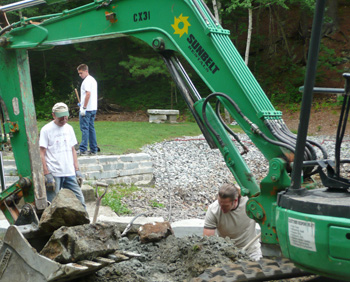
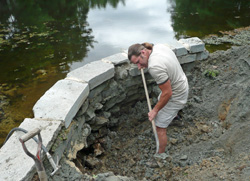
But repairing the sinkholes, and the channels through the dam that had caused them, had to await low water and dry weather. To residents depending on shallow wells for the household water, the wait seemed like an eternity.
Finally, in mid-June, the work began. Volunteers - led by landscaper and master mason Scott Fumicello - excavated the area on the southerly crest of the dam where the sinkholes had developed. Using a mini-excavator, they were able to get down to the water line, exposing the source of the damaging leaks.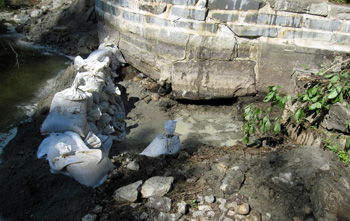

Much of the work was done on June 19. A coffer dam exposed erosion under the walls on the southerly side of the dam. Area residents Dave Adilmanand Bob Pincus spread concrete to plug leaks which caused sinkholes.
To plug the leaks securely, a coffer dam - consisting of about 30 handpacked sandbags - was constructed in front of the dam's sluiceway, creating a dry area into which concrete could be poured to fill eroded spaces under and around the massive granite blocks on the face of the sluiceway walls.
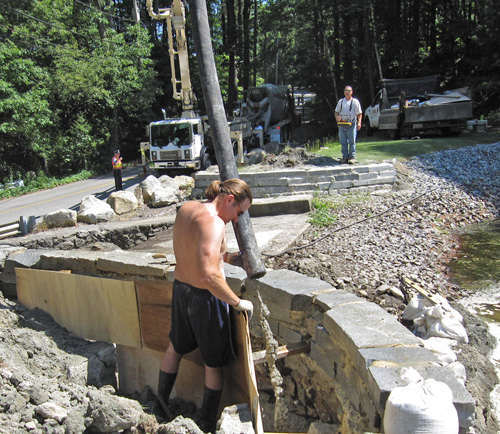
June 19: Seven cubic yards of concrete, pumped from equipment on Rattlesnake Hill Road, fortified the dam's most vulnerable flanks. Photos by John Lugus.
More concrete was poured behind the granite blocks on the "wing walls" on both sides of the spillway. This concrete will stabilize the walls, and prevent heaving from winter frosts, which can create channels into which water can flow.
A concrete truck and a pump truck had to be brought in to pour the seven cubic yards of concrete needed to complete the work.
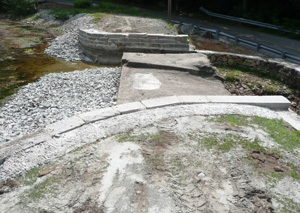
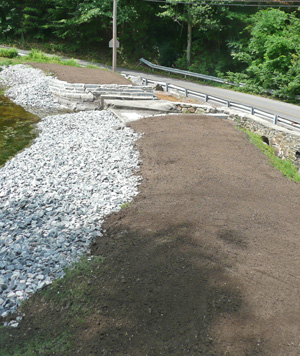
Concrete set in place on June 24 now fortifies more of the dam. Note the patch in the middle of the spillway, which alone took two tons of concrete. The finishing touches included several tons of crushed rock added to both embankments, and a new layer of loam on the crest, which has also been re-seeded. A stop log was inserted in the sluiceway, but how fast the Pond rises will depend on rainfall.
Several tons of crushed rock were added to both sides of the dam's embankments, providing additional protection against erosion.
Then, the crest of the dam was re-loamed and re-seeded, to restore the dam's grass cover. Grass is an essential component of erosion control on an earthen dam.
Finally, the first stop-log was inserted in the dam's narrow sluiceway on June 20, beginning the process of refilling the Pond. But with little water flowing into the Pond, raising the water level will depend on Mother Nature sending some heavy rains.
2nd March Storm More Damaging Than 1st
April 2010
Just as it seemed that the Foster's Pond Dam had dodged a bullet from torrential rains in mid-March, a second storm swept through at the end of the month, causing serious damage to the 150-year-old structure.
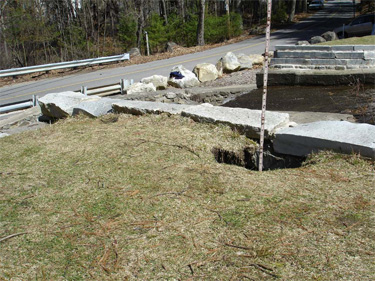 |
| April 2: This sinkhole, which appeared during the mid-March storm as a small depression, collapsed in the late-March rain. This photo is from the GEI report. |
As several more inches of rain fell on March 29-30, on top of the deluge that hit two weeks earlier, a small sinkhole that had appeared in the first storm collapsed, succumbing to a current estimated at several gallons a minute boring through the dam adjacent to the two-foot wide sluiceway.
With dry weather and a falling water level, more damage emerged on April 5, when the flow over the dam's 12-foot-wide spillway ended, revealing two holes in the spillway's concrete liner and one- to two-foot-deep empty chambers underneath. Those will have to be filled with concrete before the Pond can be allowed to retrun to its normal level.
On March 30, the Corporation's engineer, Lee Wooten from GEI Consultants, Inc., inspected the damage. His verdict: Some "emergency" surgery must be undertaken as quickly as possible, and permanent repairs will be required before the Pond can safely be refilled.
| April 5: As the Pond returned to its Winter drawdown level, holes were revealed in the dam's spillway. They must be filled with concrete before the Pond is refilled. |
Prior to the first storm, the Pond had been drawn down 18 inches. The annual "winter drawdown" aims at accommodating just the sort of Spring gully-washer that March brought to the Pond.
Foster's Pond rose more than two feet during the first storm, sending water levels to the highest they've been since the Mother's Day Flood of 2006. The water level was on the way back down when Storm No. 2 struck. Even though the second storm packed less rain, and the water level remained a couple of inches below the height of the earlier storm, the additional stress on the dam resulted in substantially more damage.
In a letter e-mailed to Foster's Pond Corporation President Steve Cotton dated April 6, GEI's Wooten recommended "keeping the sluiceway open" until repairs are complete.
"Do not raise the pond as is your usual practice for the summer months" until then, Wooten wrote.
Wooten recommended plugging the leak temporarily. He specified measures for a permanent fix which will involve excavating portions of the affected area, putting in new materials, and pouring concrete.
Cotton immediately forwarded copies of Wooten's 9-page report to Town and State safety and conservation officials.
And FPC volunteers began planning the next phase of their labors to preserve the Pond's most critical asset.
Deluge Hits Andover, But Dam Takes It in Stride
March 2010
Mother Nature dropped six to eight inches of rain on Andover in the 48 hours before St. Patrick's Day, shutting roads and flooding low-lying areas. But the Foster's Pond Dam - restored in 2007 to handle just such a challenge - withstood a two-foot rise in the Pond's water level and sustained only minor damage.
March 15: As torrential rains raise the Pond by two feet, water surging into the stilling basin below the Foster's Pond Dam completely fills the two thirty-six inch culverts running under Rattlesnake Hill Road.
If anyone was wondering why the Corporation lowers the Pond each Fall, the unnamed March storm of 2010 provided a dramatic lesson. Before the rains came, the Pond was down about 18 inches below the lip of the dam's spillway, leaving room to accommodate heavy Spring rains and melting snow without putting excess pressure on the dam. As the rains pelted down, Foster's Pond rose a couple of feet in just 24 hours, even with all three "stop logs" removed from the dam's narrow sluiceway.
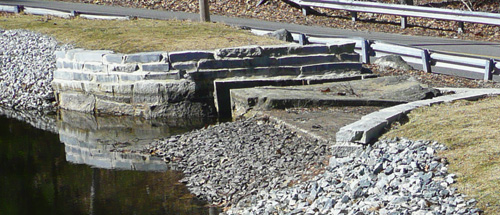
March 9: Before the storm, the Pond had been drawn down 18 inches below the lip of the spillway. Note how much of the granite wall on the left side of the dam is exposed.
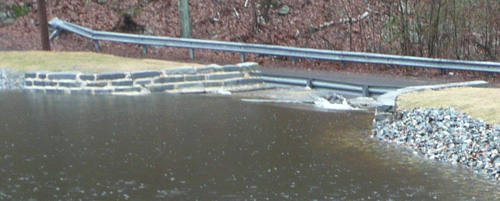
March 15: The dramatic rise in the water level - about two feet in 24 hours - now covers the spillway and the platform just to the left of the spillway. Only the top three courses of granite blocks are visible on the wall, and one is partially under water.
Water surging over the dam's 12-foot-wide spillway turned the "stilling basin" at the foot of the dam into a devil's cauldron of frothing water. As the flow peaked, the tops of the twin 36-inch culverts under Rattlesnake Hill Road were barely visible.
Water from Foster's Pond flows under the road to a huge expanse of wetlands. They filled to capacity, taking on the appearance of lakes and flooding Woburn Street in two places.
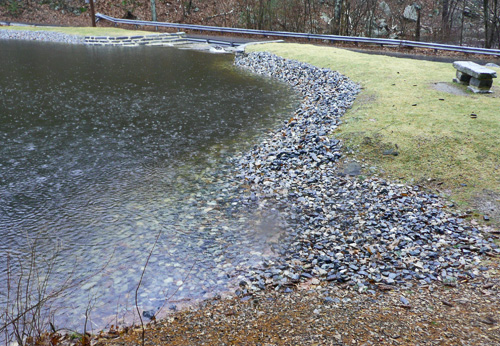 |
| March 15: At its peak, the water level was just a few inches short of emptying through the emergency spillway (foreground). That's the safety valve which ensures the Pond won't get high enough to overtop the dam. |
The dam has a primitive mechanism for lowering the water level of the Pond. Three ten-inch tall boards are removed, one after the other, from the sluiceway just to the right of the dam's spillway. Operating under an Order of Conditions approved by the Andover Conservation Commission, the Corporation is permitted to begin the drawdown process in November, completing the adjustment by early December, before the Pond freezes. The idea is to allow for just what happened earlier this week: a huge influx of water in the Spring without overwhelming the 150-year-old dam. The water level is kept low - about a foot-and-a-half below the lip of the spillway - until mid-May, when the snow has melted and the ground has thawed, diminishing the danger of flooding.
This week's deluge was reminiscent of the Mother's Day flood of 2006. Foster's Pond had just been refilled when the rains came that May. The dam overtopped, causing severe damage. After a State-mandated safety inspection found the need for significant work, volunteers put in hundreds of hours restoring the dam and increasing its safety.
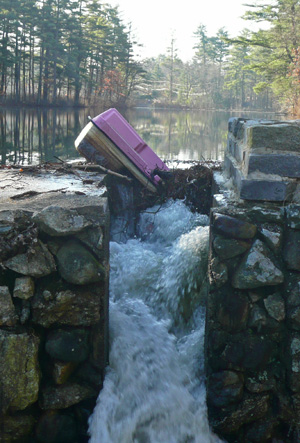 |
| March 17: High waters and strong currents carried a child's paddleboat to the sluicway. Volunteers managed to free the waterlogged craft. |
One notable improvement to the dam after the '06 flood was the restoration of the emergency spillway. That sloping pathway to the left of the dam, which neighbors and visitors use to launch canoes and boats into the Pond, is actually engineered to handle extreme water levels. Before the Pond rises high enough to overtop the dam again, water will flow over the emergency spillway, which is lined with a geosynthetic cloth to prevent erosion.
After this week's storm, water lapped just a few inches below the crest of the emergency spillway but never rose high enough to begin flowing down the grassy slope.
As well as the dam performed, it did not escape unscathed. A couple of long-standing seepage areas were enlarged, and a one-foot diameter sinkhole developed near the sluiceway. The Corporation's engineering consultant will inspect the dam at the end of the month, and volunteers will then go to work patching up the damaged spots.
2009-10 Drawdown Beats the Freeze
May 2009
The 2009-10 winter drawdown, begun in mid-November, brought the Pond's water level to its winter target just as Mother Nature dropped the temperature and covered the surface with a layer of skim ice.
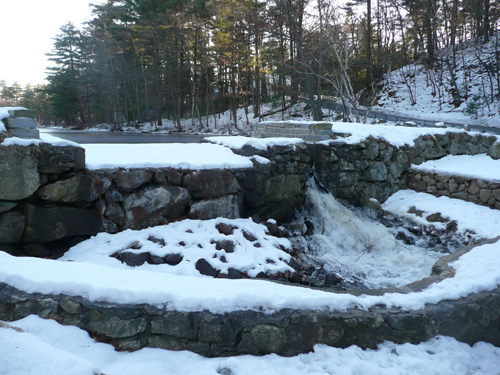 |
| December12: Water dances through the spillway, with Pond at its target level for the winter. |
That's exactly the way the process is supposed to work, letting aquatic beasties adjust to the Pond's shrinking acreage before the ground freezes around them.
Annual drawdowns kill nuisance vegetation along the shoreline, but the primary purpose for them is to give the Pond added capacity to handle Spring runoff and snow melt without overtopping the dam. The maximum the Pond can be lowered is 18 inches below the lip of the dam's 12-foot wide spillway.
The winter drawdowns are conducted by the Foster's Pond Corporation pursuant to an Order of Conditions approved by the Andover Conservation Commission. On December 1, the Commission voted unanimously to extend the Order - which also covers the FPC's weed management program - for three years, through 2012.
As usual, the Pond's beavers were not happy about the drawdown, stuffing the dam's sluiceway with logs and brush every night until the skim ice got in their way. This year, they introduced a new building material in their quest, somehow jamming a muck-encrusted fiberglass ski into the sluiceway's narrow opening.
Volunteers - led by landscaper Scott Fumicello - this Fall reinforced the embankment on the dam with two layers of crushed stone. The stone holds in place a layer of industrial fabric which prevents erosion of the dam's clay fill. Fumicello has been instrumental in restoring the dam.
Spring Showers Gently Refill Pond
May 2009
April showers brought not only May flowers but also a mid-May refill of Foster's Pond, raising the water level just enough to start the picture-postcard cascade over the spillway of the Foster's Pond Dam. This year's gradual refill was right on schedule, gently restoring the 18-inch drop achieved by the 2008-9 annual winter drawdown.
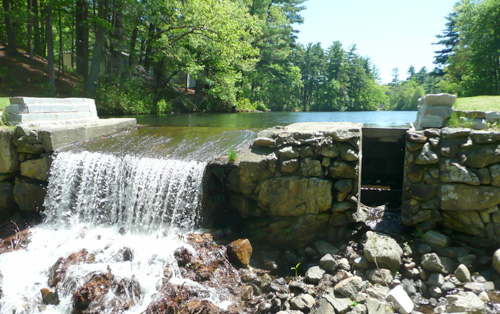 |
| May 18: With all three stoplogs in place in the narrow sluiceway (right) of the Foster's Pond Dam, water cascades over the spillway after the Pond returns to its "normal" level. |
The refill began on April 17, when the first of three "stop logs" was inserted in the dam's narrow sluiceway. It took just under a month, as the remaining stop logs were put in place, for the refill to restore the water level to "normal" for this time of year. It also took 5.75 inches of rain, most of which splashed down in late April.
This is the fourth year in a row, since the sluiceway was restored, that the Pond has been drawn down for the winter and refilled in the spring, and the process is becoming routine. The aim is to prevent "overtopping" of the dam if heavy spring rains combine with snow melt and saturated soil to produce flooding conditions - as happened in 2006.
Refill Begins, Ending Drawdown
April 2009
As the last traces of winter snow vanished from around the Pond, the 2008-9 winter drawdown shifted into reverse. On April 17, the first of three "stop logs" was inserted in the narrow sluiceway of the Foster's Pond Dam, beginning the process of refilling the Pond for the summer.
The water level will be brought up gradually over the next month, until flow is restored over the twelve-foot-wide spillway, the picturesque waterfall of the 150-year-old dam. Lowering the water over the winter is a safety measure, aimed at providing additional capacity for the Pond to accommodate melting snow and spring rains without "overtopping" the dam - as last happened during the Mother's Day flood of 2006.
In the meantime, the Pond's beavers have been eager to see an end to the drawdown, stuffing branches into the sluiceway of the dam without waiting for humans to raise the water level. That mound of branches to the left of the accessway is all material that beavers have brought to the dam. It must periodically be removed from the sluiceway and stored in a safe place, then carted away.
2008-9 Winter Drawdown Gets Underway
November 2008
With icy weather suddenly in the forecast, the annual Winter drawdown of Foster's Pond began November 16. It is expected to take about two weeks to lower the water level about 18 inches below the lip of the dam's spillway.
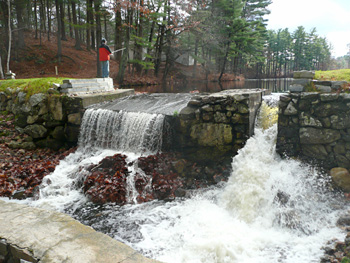 |
| November 16: Water gushes through the Foster's Pond Dam's narrow sluiceway (right), after the removal of two of the "stop logs" which control the water level. The 18" drawdown will take about two weeks. |
This is the fourth year in a row that the Foster's Pond Corporation has drawn down the Pond. The dam's narrow sluiceway - adjacent to the wider spillway over which water cascades during most of the year - was restored in 2005 to allow some control over the water level in the Pond. Decades ago, a pipe and valve system made it possible to draw the Pond down several feet, but the pipe collapsed in the 1970's and has since been covered in concrete.
The drawdown is largely a safety measure, allowing the Pond to absorb melting ice and seasonal run-offs in the Spring without "overtopping" the 150-year-old dam. Overtopping, which last occurred during the Mother's Day flood of 2006 - can wreak havoc on an earthen dam.
Drawdowns also contribute to weed control, allowing Mother Nature to kill such nuisance weeds as fanwort growing close to shore in sediments exposed to freezing during the winter.
The water level is controlled by removing "stop logs" in the sluiceway. Two of the 10-inch tall boards have been removed to start the drawdown. The third board will be removed in about a week. The boards will be re-inserted in the sluiceway next April, bringing the water level back to normal.
Rebuilt Wall Erases Last Sign of '06 Flood
October 2008
The Mother's Day Flood of 2006 inflicted severe wounds on the Foster's Pond Dam, when the rain-swollen Pond overtopped the dam's earthen crest. Until recently, the Corporation has focused on the safety-related repairs that have turned the 150-year-old structure into a grassy community park while earning it the State's second-highest safety rating.
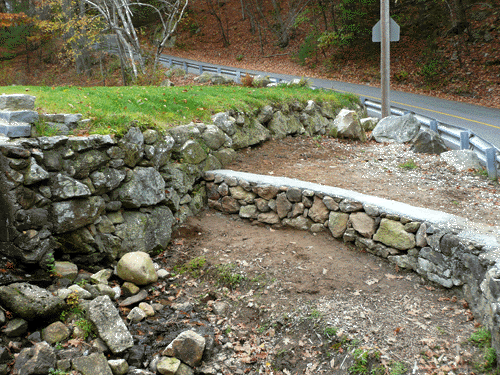
The retaining wall around the "stilling basin" at the foot of the dam underwent repairs in October.
But over the last couple of months, local resident Scott Fumicello - the master mason and landscaper who has volunteered countless hours to restore the dam - has been able to focus on parts of the dam that had been hard-hit by the storm but weren't deemed quite as critical by inspectors.
This month, Scott rebuilt portions of a retaining wall that surrounds the "stilling basin" at the foot of the dam. Nearly a third of the stone wall had been washed out when the dam overtopped. When very large volumes of water are running over the dam's 12-foot-wide spillway, the retaining wall channels the flow into the 36-inch culverts which run under Rattlesnake Hill Road.
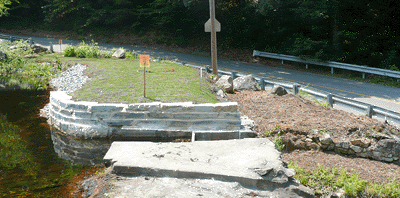 |
| Retaining wall (right) as it appeared last year, before it was repaired. |
One precaution against overtopping is the annual Winter drawdown of Foster's Pond. The drawdown gives the Pond added capacity to accommodate build-ups of snow and ice over the Winter, so that the Spring thaw does not result in more water than the dam can handle.
This year's drawdown is slated to begin on November 14. It will take about two weeks to lower the Pond 18 inches below the lip of the spillway, the maximum that can be achieved with the current configuration of the dam.
The Corporation, as required by the Order of Conditions which regulates the drawdown, has sent notices to a dozen homeowners with shallow wells, letting them know who to call if their wells run dry during the drawdown. No well-owner has had a problem with drawdowns over the last three years, when the annual practice resumed following a lapse of some 30 years. Before that, drawdowns of more than 3 feet were regular features of Pond life, and - though there were many more shallow wells in those days - well-owners reported no problems.
State Finds Dam In Compliance
August 2008
The agency charged with overseeing the safety of Massachusetts dams has given its stamp of approval to the work done by the Foster's Pond Corporation to recondition the 150-year-old Foster's Pond Dam.
The Office of Dam Safety has issued a "Compliance Review" accepting the findings of engineers who inspected the dam last May and determined that it is in "satisfactory" condition.
The one-page notice from ODS, dated August 26, brings to an official end an ordeal that began with the Mother's Day flood of 2006, when record rains sent a torrent of water over the dam, overtopping the earthen crest and causing significant erosion. A subsequent State-ordered inspection found the dam in "poor" condition and in need of extensive work.
That led to a massive effort by volunteers to restore the structure, making it not only safer but far more beautiful. It has also been adapted as a "pocket park," open to neighbors and the general public.
A follow-up inspection in May, 2008, found the dam to be in "satisfactory" shape, a two-grade jump in the State's safety rating system. But it was still up to the Office of Dam Safety to decide whether to accept the results or the latest inspection, or whether to order further inspections or more work.
The positive ODS "Compliance Review" means that no further work on the dam is required, and that the next routine safety inspection won't be due until 2011.
Heavy July Rains Are No Problem for Rejuvenated Dam
August 2008
Unusually heavy July rains raised the level of the Pond by several inches, but the newly-restored Foster's Pond Dam had no trouble handling the high water.
The Foster's Pond weather station recorded nearly 7.8 inches of rain for the month, more than double the normal rainfall for this area. That volume of water could have caused trouble for the dam in past years. But not now. The new grass cover blanketing the crest of the dam just turned greener.
As a precaution, one stop-log was removed from the dam's sluiceway for a 24-hour period beginning July 24, when flooding conditions were predicted for parts of New England. But the flow coursing over the dam's reconditioned spillway was easily contained within its well-armored walls, providing passers-by with a picture-postcard waterfall to enjoy viewing on a hot summer's afternoon.
New Safety Inspection Gives Dam a Passing Grade
May 2008
In 2006, the Foster's Pond Dam - suffering from decades of on-and-off maintenance and the ravages of a Mother's Day flood which gouged sinkholes in its earthen crest - underwent a State-mandated safety inspection. The once-proud 150-year-old structure suffered the indignity of receiving a failing grade.
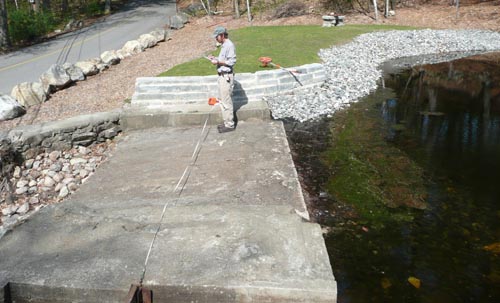 |
| May 8: GEI engineer Lee Wooten gathers data during his re-inspection of the Foster's Pond Dam. His report gave the dam a "satisfactory" rating, a huge improvement from the "poor" mark given in November, 2006. |
This month, in the wake of hundreds of hours of work by Foster's Pond Corporation volunteers, the dam was re-inspected. And this time, it passed with flying colors.
Both inspections were conducting by the same engineering firm, GEI Consultants, Inc., a nationally-recognized company based in Woburn, MA.
The 2006 inspection had rated the dam in "poor" condition, defined by State regulators as meaning that a dam has "significant structural, operation and maintenance deficiencies."
But that lousy mark is, as they say, water over the dam.
Based on its May, 2008, follow-up inspection, GEI rated the dam as "satisfactory", meaning that there are no structural deficiencies and that any operational or maintenance deficiences are only "minor". The new rating represents a two-grade jump in the State's rating system, the equivalent of a solid B - not too shabby for a 150-year-old.
"The deficiencies at Foster's Pond Dam have been corrected by a major maintenance effort that the Foster's Pond Corporation performed since the Phase I inspection" in 2006, wrote GEI vice-president R. Lee Wooten in his May 29 cover letter summarizing the re-inspection. Wooten is the engineer who conducted both inspections.
 |
| May 8: Snakes on a dam. While Wooten inspected, three northern water snakes sunned themselves on the newly-placed rocks below the spillway. |
Wooten's letter summarizes extensive maintenance work undertaken by the FPC, including masonry work on the crest which has increased the "safe flow capacity of the primary spillway."
That work, combined with the restoration of the emergency spillway - a trough that doubles as a boat ramp for visitors to the dam - means that the dam now has the capacity to handle the anticipated volume of a so-called 100-year-flood.
Wooten observed only one minor "deficiency" in the latest inspection, some seepage at the based of the dam below the main spillway. He recommended that the FPC monitor the seepage and watch for the development of any sinkholes.
The State's Office of Dam Safety, which regulates public and private dams in Massachusetts, ordered the inspection of all dams in 2006 after a major dam failure in Taunton. Dams receiving a rating of "poor" were required to be re-inspected at intervals until deficiences are corrected.
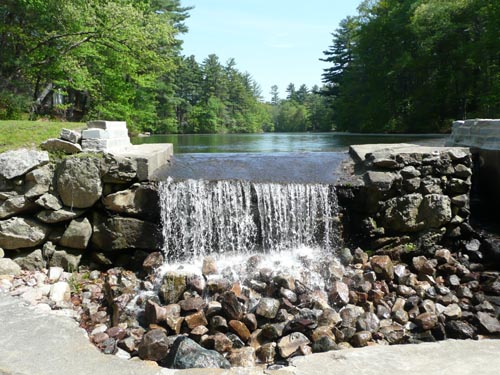
May 26: With the refill of the Pond now complete after the 2007-8 winter drawdown, water coming over the main spillway splashes onto the rocks below. If extremely heavy rains are forecast, water can be released though the sluiceway (right) to avoid "overtopping" the dam. Otherwise, water will not be released through the sluiceway until the next drawdown starts in November.
In an order issued in February, the ODS also required the FPC to conduct a "Phase II" inspection - a much more extensive and expensive engineering study entailing detailed repair plans for deficient dams.
The GEI report recommended that, in light of the dam's improved condition, ODS modify its order so that the FPC would not need to perform a Phase II study. GEI's 36-page report was issued May 29.
Late-April Showers Raise the Pond as Drawdown Ends
April 2008
As the region basked in day after day of unseasonably warm, dry weather, the Spring refill of Foster's Pond began - but slowly. Then came a two-day stretch of torrential rains, and water levels climbed.
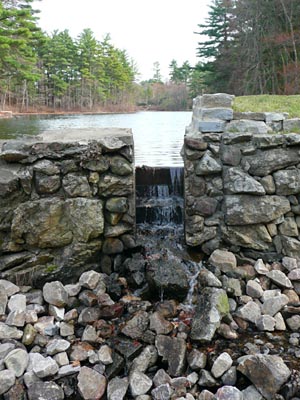 |
| April 22: The first stoplog was inserted in the dam's sluiceway on April 19. Three days later, when this picture was taken, rising water was beginning to splash over the top. The second stoplog went in the following day. |
The first of three stoplogs - the 10-inch-high boards which are used to control water levels in the Pond - was inserted in the narrow sluiceway of the dam on April 19.
The refill marks the end of the annual 18-inch Winter drawdown, a safety measure which gives the Pond additional capacity to absorb Spring's snowmelts and the run-off occasioned by heavy rains falling on saturated soil in the watershed.
The pace of the refill depends on the weather. With little rain, springs and streams feeding the Pond will still raise the water level, but not very fast. And gaps are purposely left between the stoplogs during the refill, so that water is always flowing into the downstream wetlands.
Within three days of insertion of the first stoplog, the Pond had risen a couple of inches, enough for water to start trickling over the top of the board.
The second stoplog was inserted on April 23. But with lower-than-normal rainfall, and dry air causing evaporation, the pace of the refill was much slower than the inch or so a day normally expected at this time of year.
Not to worry, however. A heavy rain can cause the Pond to rise several inches in one night. And by month's end, that's just what happened. In a 30-hour period April 28-29, 2.1 inches of rain - as measured at the Foster's Pond weather station - poured down, and even before the last storm had blown through, the Pond had risen another six inches.
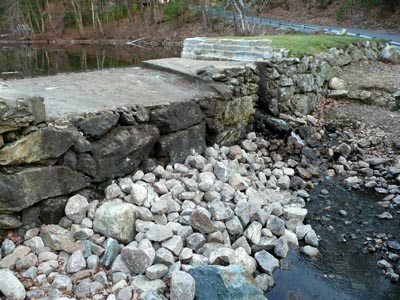
April 23: Six tons of boulders have been placed at the foot of the dam, in the stilling basin. The aim is to break the force of water pouring over the spillway and prevent scouring, which could weaken the foundation of the dam.
Too much rain is more of a hazard to the dam than too little. The Mother's Day flood of 2006, which came just after that year's refill, caused significant damage to the dam - though the work that has been done over the last year significantly reduces the likelihood that the dam will again be overtopped.
The balmy weather and the new "pocket park" at the dam have proved a winning combination for area residents. Whether for a young couple sitting hand in hand on the bench, or dads bringing youngsters to angle for sunfish, the dam is proving to be a tranquil and convenient spot for enjoying the Pond.
The newly-planted grass on the dam is getting some professional help this year. The Corporation has lined up Organic Soil Solutions, an organic lawn care company based in Woburn, to tend the grass in an environmentally sound way. The company is donating its services. (For more information on landscaping your own Pond-side property, read Lawns and Landscapes in Your Watershed, a publication of the State Department of Environmental Protection.) The grass has already received a dose of corn gluten (a natural weed suppressant and fertilizer) and an overseeding on bare spots.
Volunteers have done some additional maintenance work on the dam this Spring. As recommended by the Corporation's consulting engineers, the volunteers placed stones in the stilling basin at the foot of the dam. The aim is to dissipate the force of the water coming over dam and prevent scouring, which eventually could undermine the structure. About six tons of stones have been heaved by hand, one at a time, in the effort.
Engineers will conduct a second inspection of the dam in early May. Their first inspection, in November, 2006, rated the dam as being in "poor" condition and led to a year of extensive volunteer labor to correct deficiencies.
Pond and Temperatures Drop as Winter Sets In
December 2007
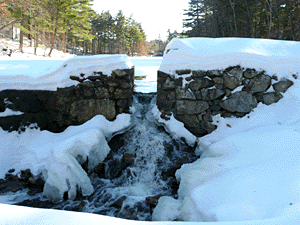 |
| December 18: The winter drawdown has lowered the Pond about 18 inches below the dam's spillway. |
The Pond tamely followed the script for the annual winter drawdown, falling by early December to the target level of about 18 inches below the spillway of the dam. Just in time. Someone gave an early cue to Old Man Winter.
Frigid temperatures and serial snowstorms blanketed the area with mixtures of snow and ice. A new weather station on Foster's Pond recorded low temperatures of 20 degrees or below on 17 of the first 19 days of December. And only one of those days - December 12 - yielded an average temperature above freezing for the day.
State wildlife officials like to see a winter drawdown attain the low water mark before freezing weather sets in. That gives water-dependent animals a chance to adjust their burrows, move to deeper water, or do whatever else they do to prepare for winter before everything ices up. So the timing of this year's drawdown was by the book.
Meanwhile, the snow just kept on coming. And coming. Around two feet fell before the first day of winter, turning the Pond into a picture postcard. Indeed, one mother posed her family on the dam's new bench for their annual holiday picture.
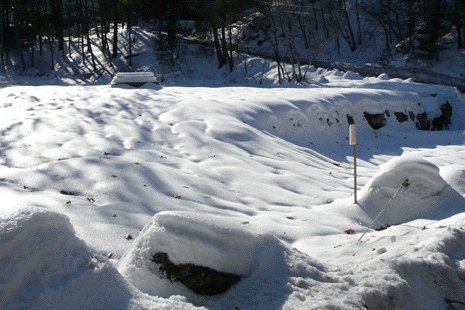
December 18: Foster's Pond Dam blanket by the early snows.
The drawdown was made for just such weather. Freezing temperatures will kill fanwort growing along shorelines that have been exposed by lowering the Pond. And, with the drawdown, the Pond has greater capacity to handle snow melt and spring rains without the danger of overtopping the dam.
With Restoration Complete, Drawdown Begins
November 2007
The 2007-2008 winter drawdown of Foster's Pond began November 4, with water cascading through the narrow sluiceway of the 150-year-old dam. With the Pond already several inches below its normal level for this time of year, the drawdown will bring the water down another foot or so over the next three weeks.
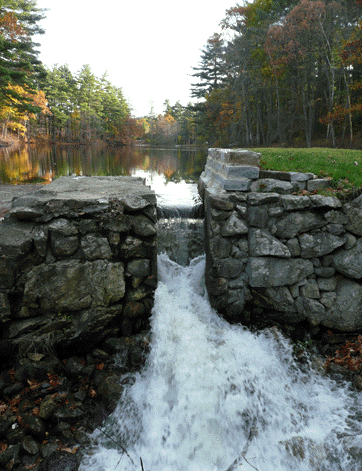 |
| November 4: The 2007-8 winter drawdown begins. Two "stop logs' have been removed from the sluiceway. The third will come out later. |
The annual drawdown increases the Pond's capacity to hold winter snows and spring run-off, and is aimed at averting a repeat of "overtopping" - when so much water comes over the dam that the flow cannot be contained within the concrete-lined spillway. Overtopping can seriously erode an earthen dam, and is the leading cause of catastrophic failures in such structures.
This is the third winter drawdown in as many years, part of a new regimen of lake management undertaken by the Foster's Pond Corporation, which owns the historic dam. The drawdowns, authorized by a comprehensive Order of Conditions approved by the Andover Conservation Commission, dovetail with other efforts by the Corporation to control nuisance vegetation and safeguard the ecology of the Pond.
This year's drawdown marks a major milestone in the protection of the dam, which impounds the 120-acre Pond. A year-long project to restore the dam - and turn it from a weed-entangled near-ruin into a community icon - has ended, with residents marveling at the transformation.
The dam is now far safer, with both sides of its 12-foot-wide spillway - the picturesque waterfall that carries the flow when the Pond is at its normal level - now buttressed on both sides with granite-block walls. The crest has been restored to a uniform height, with the addition of tons of clay to fill sinkholes that had developed over the years. And a new blanket of grass now covers the entire crest, replacing both the trees that sank leak-inducing tap roots into the crest and the poison ivy which discouraged maintenance.
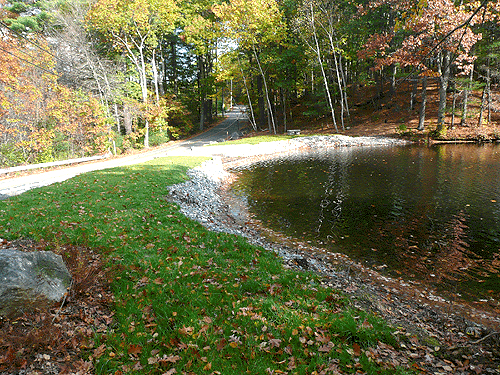
October 31: The crest of the Foster's Pond Dam, now safely buffered by granite walls and crushed stone, offers a serene "pocket park" for residents and visitors.
At the behest of engineers who inspected the dam last year, the Corporation has also restored an emergency spillway, which will allow flood waters to flow harmlessly to the side of the dam instead of over the top. The spillway will see action only in the highest of flood conditions - it will carry water only if the Pond comes up to within a foot or so of the top of the crest - but provides what could be a dam-saving relief valve in a full-blown hurricane.
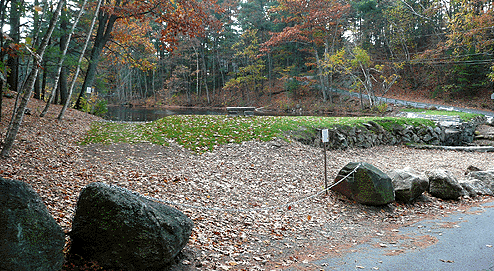 |
| Visitors can now walk easily to the crest of the dam. The emergency spillway (left of the bench) doubles as a launch ramp for canoes, kayaks, and boats powered by electric motors. Gasoline-powered engines are prohibited. |
The restored dam now serves a dual purpose. With the safety improvements, which include an accessway allowing construction equipment to reach the crest when needed for maintenance or in an emergency, the dam is now easily accessible, and visitors from near and far have come to launch boats (gasoline powered motors are not allowed, but canoes, kayaks, and boats with electric motors are welcome), fish from the shoreline, or just sit and enjoy the view. The Corporation has installed a granite bench for the enjoyment of visitors to the new "pocket park."
Most of the work over the past year has been performed by volunteers, most notably Scott Fumicello, a resident mason and landscaper, assisted by FPC president Steve Cotton. The scope of the work was defined by the Corporation's engineers, GEI Consultants, Inc., of Winchester. The site plan was drawn by designer Dave Brown, a Glenwood Road resident. Many other volunteers contributed time and effort, including Dam Committee Chairman Paul Ross, Foster's Pond Road resident Will Weightman, and Rattlesnake Hill Road resident Steve Zappala.
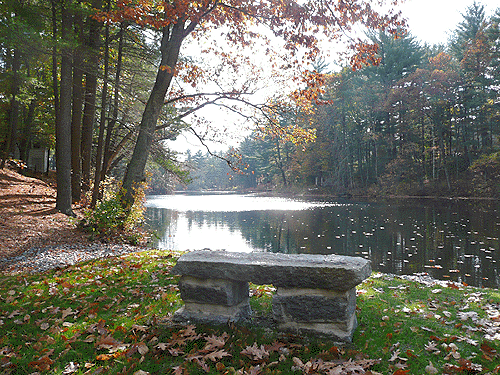 |
| On the crest of the dam, the new granite bench affords a serene vista of Foster's Pond. Rock Island, the only Town-owned island in Andover, is barely visible under the sloping tree to the left of the bench. |
Significant funding for the effort came from the Boston Foundation, which administers the Bessie Goldsmith bequest and owns the Goldsmith Woodlands, the largest property abutting the Pond. Recognizing that the magnificent shoreline views from the Goldsmith reservation depend on a healthy Pond, the Boston Foundation has been a major supporter of the Foster's Pond Corporation's efforts to protect and manage Foster's Pond.
Local companies, including Deloury Industries and Ferris Tree Service, also donated materials to the dam project.
Some finishing touches remain to be done. Additional boulders will be added to the stilling basin below the spillway, breaking the force of the waterfall to minimize erosion under Rattlesnake Hill Road.
And the Corporation is trying to raise money to erect a permanent sign at the site, replacing the temporary signs now posted on wooden stakes. The new sign will present information on the history and ecology of the Pond, as well rules for a safe visit.
Bench Added to New 'Pocket Park'
September 2007
A granite bench now adorns the new "pocket park" which is emerging on the crest of the Foster's Pond Dam.
Topped by an old slab bearing marks from the days before quarries had saws, the bench affords visitors a surprisingly comfortable spot from which to gaze at the tranquil vista of the Channel and Rock Island.
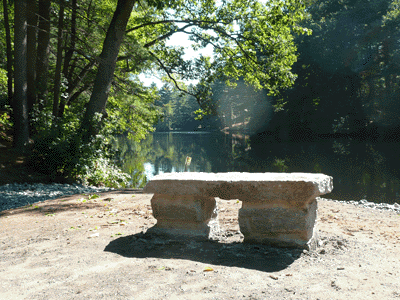 |
| September, 2007: The new bench affords a tranquil view down the Channel. |
The bench, with its graceful proportions, exhibits the artistic flair of its creator, Scott Fumicello, the Willard Circle mason and landscaper who has donated countless hours to the restoration of the 150-year-old dam. Fumicello was honored for his work at the Foster's Pond Corporation's summer meeting in August.
Granite for the bench was donated by Foster's Pond Road residents Dave Adilman and Lisa Walters.
Almost all of the work on the dam has been purely functional, the result of recommendations from the Corporation's engineer last year to prevent further overtopping. That's the term for high water exceeding the capacity of the dam's spillway and cascading over its earthen crest. The result is erosion which can threaten the catastrophic failure of an earthen dam.
With the crest on both sides of the spillway now restored, and armored by granite blocks, geotechnical fabric, and crushed stone, overtopping and erosion are much less likely. The treeless grass expanses on the crest are also designed to minimize erosion that can result from water penetrating around the woody roots of trees and bushes. And the large swale sweeping around the easterly crest of the dam is also a safety feature - an emergency spillway that will allow flood water to escape without overtopping the dam in the highest water conditions.
Many of these safety features contribute to the park-like appearance of the newly restored dam. The Corporation has opened the inviting new "pocket park" to visitors from near and far, allowing the crest to be used for fishing and the emergency spillway to double as a launching ramp for canoes, kayaks, and boats with electric trolling motors.
Litter has actually decreased at the dam since it has been opened to the public, and Foster's Pond is burnishing its reputation as a destination for serious anglers in search of feisty - and weighty - large-mouths. The anglers come from as far away as Fitchburg and New Hampshire, as well as from residences down the street. Parking is not allowed at the dam, but visitors have found on-street parking near-by. Visitors are asked to be particularly careful to stay off lawns and leave no litter behind.
Dam's East Side Nears Completion
August 2007
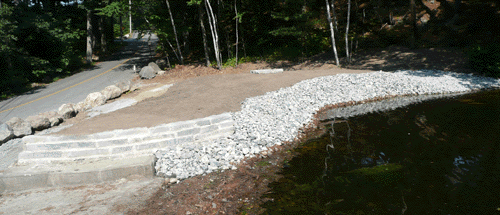
August 31 : The easterly crest of the dam reveals its finished contours. The crushed stone embankment and new granite wall protect the dam from erosion. The granite slabs just visible at the top of the photo will be used for a bench.
The easterly crest of the Foster's Pond Dam is showing its finished contours, as the Corporation's year-long project to restore the historic structure edges toward completion.
The majestic easterly arc of the earthen dam has been restored to a height that will withstand overtopping, the major threat to dams of this type. Clay has been added to the Pond-facing slope, covered with a geotechnical fabric to keep it from washing away, and further protected from erosion by a layer of crushed stone. The top has been loamed, and will be seeded with grass, the best protective cover for earthen dams.
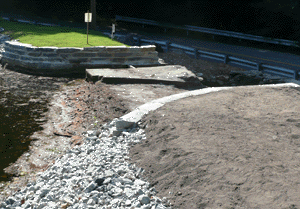
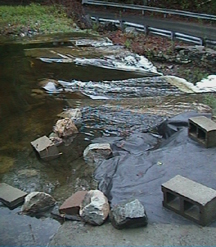 |
| The restoration work will prevent a repeat of the May, 2006, overtopping (above), when volunteers spread a makeshift barrier to slow erosion of a sinkhole on the easterly crest. |
And an important safety valve has been restored. At the direction of the Corporation's engineers, the original emergency spillway - a gully at the eastern edge of the dam - has been cleared out. The gully looks to most visitors like a boat ramp, and, indeed, boaters are invited to use it; it has been rebuilt with a lot of stone at its mouth, to minimize erosion from the launching of canoes, kayaks, and bass boats. But the real purpose of the contour is to allow flood waters to escape, without eroding the dam, in the rare storm which causes the Pond to rise to within a foot of the dam's crest.
There is still some heavy work to be done. The stilling basin, just below the dam's picturesque waterfall, has been scoured out over the decades. When water flows heavily over the dam, the basin turns into a frothing cauldron, and the turbulent water erodes the stonework under Rattlesnake Hill Road. The engineer's recommended solution: add boulders to the stilling basin and against the face of the dam, so that water pouring over the dam breaks on the rocks instead of roiling in a pool. That work is now underway.
Then there are the finishing touches - construction of a bench to provide visitors a place to sit and contemplate the view, seeding the crest with a grass cover, and finishing the slopes and the area in front of the dam with wood chips.
Volunteers are also working on a plan for a sign to provide visitors with information on the history and ecology Foster's Pond.
West Side of Dam Is Almost Finished
July 2007
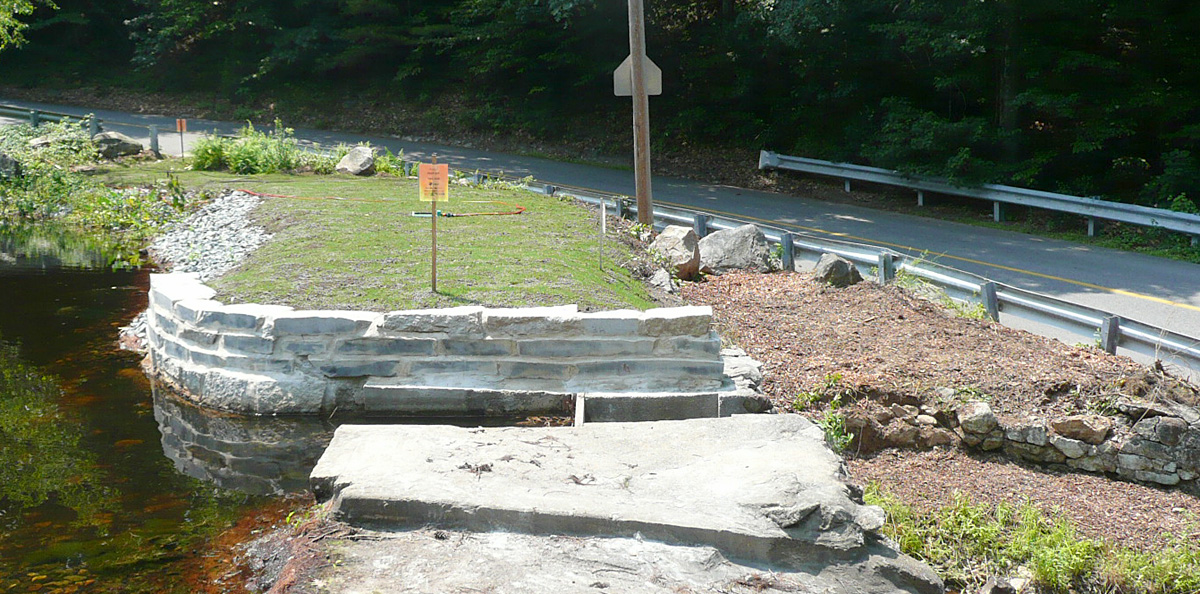
July 25: The westerly crest of the dam, with a new grass cover atop tons of clay added to the cap. The new granite wall and crushed stone facing the Pond, are expected to prevent erosion and overtopping which periodically threatened the dam.
 |
| Fall, 2004: Before the Corporation undertook to rehabilitate the dam, this is what the westerly crest looked like. Raking and weed treatments have also cleared aquatic vegetation. |
The westerly crest of the Foster's Pond Dam - for decades its most vulnerable spot - is now almost fully rehabilitated. It's lowest portion, frequently overtopped with torrents which threatened to erode the 150-year old earthen structure, has been raised nearly three feet and armored with granite blocks. Tons of new clay along the 75-foot westerly crest are protected by a facing of crushed stone, and the crest itself - once a tangle of trees, brush and poison ivy - now sports a cover of just-sprouted drought-resistant grass.
Volunteers will now focus on the easterly crest, which will mirror the new look.
Work Progressing On Dam
July 2007
Major progress has been made at the dam, with the westerly side nearing completion. On July 15, loam was spread on half the dam, showing the final contours of the portion that had in past years proved most vulnerable to overtopping.
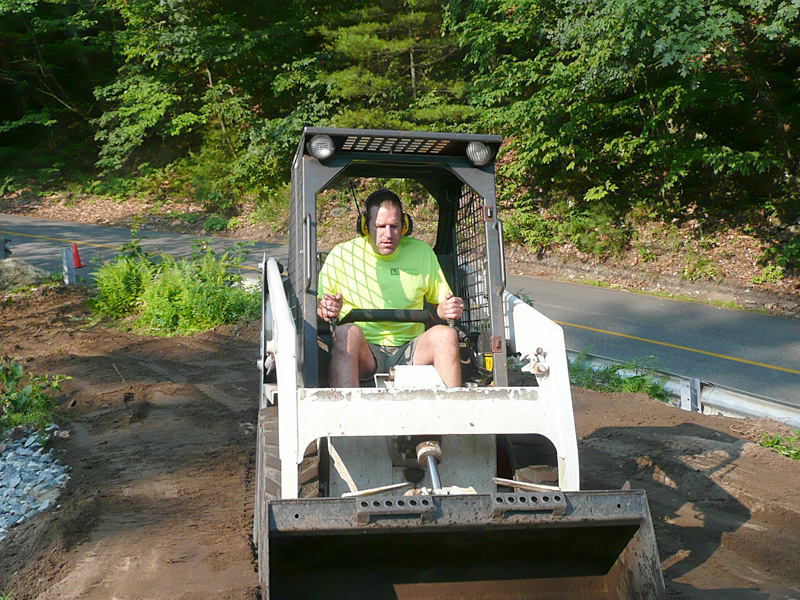 |
| July 15: Scott Fumicello uses his Bobcat to smooth new layer of loam on the westerly crest of the dam. |
The stone work has now been completed, with new granite-faced walls guarding each side of the spillway. For decades, State dam inspectors had complained that the dam's shallow, concrete-lined spillway was inadequate to handle the flow of water during occasions of normally heavy flow. With the new work, that problem has been solved.
Most of the recent work on the dam has been spearheaded by Willard Circle resident Scott Fumicello, an expert mason and landscaper who has donated time and equipment to the massive effort.
Foster's Pond Road resident Will Weightman, who maintained the dam almost single-handedly for many years, contributed a nifty solution for keeping unauthorized vehicles off the dam: he drilled a pair of anchors into the large boulders flanking the new pathway to the crest of the dam, allowing a chain to be strung across the access-way.
Grass seed was spread on the westerly crest July 17, and will be watered through 375 feet of newly-acquired hose running from the Rattlesnake Hill Road home of Dam Committee Chairman Paul Ross. Using Pond water for irrigation isn't possible this year because it contains the low concentrations of herbicide being used to treat fanwort.
The focus will turn now to the easterly side of the dam. Work is well underway to backfill the new wall with clay, bringing the easterly crest up to the same height as the western side. The easterly crest, too, will be faced with crushed stone and topped with loam. Final plans call for a granite bench and an informational sign to be added to the "pocket park."
But even unfinished, the dam is proving a popular draw. On July 15, a young visitor from Haverhill caught his very first fish there - a two-and-a-half-pound largemouth bass. After posing with his captor for a picture, the bass was allowed to return to the Pond.
2006-7 Winter Drawdown Ends Quietly
May 2007
The winter drawdown of 2006-2007 came to an end on May 22, as the third stop log was inserted into the dam. With the Pond at its "normal" level for this time of year, water flowed briskly over the dam's spillway, presenting the picture-postcard scene that has drawn visitors for 150 years.
Drawdown Inches Towards a Gentle End
May 2007
Mindful of last year's destructive May flood, managers of the Foster's Pond Dam are bringing this year's Winter drawdown to a slower end. They are keeping the water level a few inches below the lip of the dam's 12-foot wide spillway, giving the Pond some extra capacity to absorb a large storm like the one which last year sent water surging over the crest of the dam.
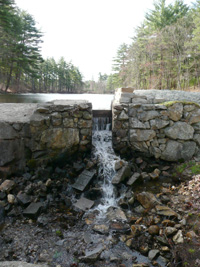 |
| May 1: Water trickles through the sluiceway after a second "stop log" slows the outflow from Foster's Pond. The water level is expected to climb slowly - unless there's a major storm. |
Three boards called "stop logs" - inserted in the narrow sluiceway adjacent to the dam's main spillway - control the water level. When all are removed to draw the water level down for the winter, the Pond level can be dropped about 18 inches below the lower lip of the spillway. The first stop log was reinserted on April 22. The second went in on May 1. How fast the water level rises depends on the weather. In April, with the ground saturated from earlier rains, a three-inch storm raised the water level by one foot overnight.
The dam is in much better shape to withstand flood conditions than it was last year. The sinkholes caused by last year's flood have now been repaired, and both sides of the spillway have been significantly raised. The westerly side of the dam is nearly finished, awaiting only a coating of loam and seeding with drought-resistant grass. The easterly side is slated for considerably more work.
Torrential Rains Test Drawdown and New Wall
April 2007
With weather reports warning of torrential rains from an impending nor'easter, volunteers ignored blustery winds during a two-day pre-storm push to strengthen the most flood-prone section of the Foster's Pond Dam.
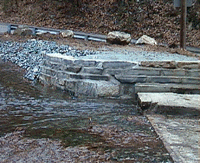 |
| April 16: The new wall fortifies what had been the lowest point in the dam. Note the water level, near the lip of the spillway. Two days earlier, the water was a foot lower. |
On April 13 and 14, a dedicated work crew wrestled granite slabs into place, completing a gracefully curving wall along the westerly side of the sluiceway and raising a vulnerable low area some 20 inches. They backfilled the wall with 20 tons of clay, eliminating a large sinkhole created during last May's flooding. Their efforts leveled the crest of the dam, which had dipped markedly in the area near the sluiceway. The dam is now much less likely to be overtopped when the Pond rises.
A similar wall will be constructed on the easterly side of the dam. When the work is completed, loam will be spread along the crest, which will be seeded with a grass cover. The upstream slope of the crest will be lined with a layer of clay, covered by a protective fabric weighted with crush rock. The sloping face of the crest south of the sluiceway received some of this treatment during the two-day effort, which was led by Willard Circle resident Scott Fumicello, a professional mason. He was joined by Rattlesnake Hill Road resident Steve Zappala, Dam Committee Chairman Paul Ross, and Steve Cotton.
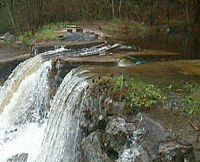 |
May 16, 2006: The dam was overtopped last May. The waterfall in the rear is flowing over the concrete-lined spillway. But the waterfall in the foreground is eroding the crest of the dam. The new work raises this portion of the dam, and protects it from overflow conditions. |
This crucial phase of the work was completed just in time. On April 15, Mother Nature delivered torrential rains on the predicted schedule, dumping some 3 inches in less than two days. By 4 p.m. on April 16, the Pond had risen about a foot, and was a fraction of an inch below the lip of the dam's main spillway. That was an astonishingly fast rise. Normally, it takes about a month to refill the Pond after the Winter drawdown. This mid-April storm refilled the 120-acre water body overnight. And that occurred with all of the "stop logs" out of the sluiceway, allowing maximum drainage the entire time.
Last year, the Pond had been refilled by May 1, leaving no room for the deluge which flooded New England two weeks later. This year, the Corporation postponed the refill, allowing workers to repair the dam during early April - and maintaining the Pond's capacity to absorb Spring floods. That strategy worked.
Work Resumes on Dam
April 2007
A small crew of volunteers took advantage of a sunny early-Spring week-end to fortify the lowest section of the dam against overtopping, which eroded parts of the dam last year.
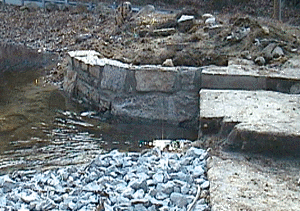 |
| This new wall will protect a part of the dam that was eroded in the May 2006 flooding. The finished wall will be about one foot higher. |
Guided by Willard Circle resident Scott Fumicello, a professional mason who has played a major role in the dam repair project, the volunteers excavated sink holes, lugged granite slabs, and poured concrete, building a wall which will raise the height of the crest and armor it in the event of high water.
The granite for this phase of the work was salvaged from the dam itself. The slabs had been buried in soil along the crest decades ago, but subsequent layering of clay and sand had left them serving no function.
The work over the March 31-April 1 week-end is part of a remedial plan developed by engineers hired by the Corporation to inspect the dam last year. When the project is completed, granite-faced walls will keep floodwaters within the area of the concrete-lined spillway, instead of flowing over the erosion-prone earthen crest. In extreme flooding conditions, an auxiliary spillway will carry excess waters to Rattlesnake Hill Road, preventing any threat to the stability of the dam.
Inspection Report: Dam Needs Some Work
December 2006
Concluding that the Foster's Pond Dam is in "poor" condition, engineers hired by the Foster's Pond Corporation to inspect the 150-year-old structure have laid out a to-do list to remedy "deficiencies " and "improve the overall condition of the dam."
The findings and recommendations are contained in a 58-page report submitted to the FPC on December 13 by GEI Consultants, Inc., of Winchester. Copies of the report have been filed with the State's Office of Dam Safety, which earlier this year had ordered more that 1,000 dam-owners in Massachusetts to hire engineers and complete similar inspections by December 15. Two GEI engineers conducted the inspection - the first in more than five years, and the most thorough in nearly 100 - on November 10.
The GEI recommendations, which the report characterized as a combination of "maintenance" and "minor repairs", include:
- Filling sinkholes and restoring the crest of the dam to a consistent elevation, armoring the upstream embankments
for 25 feet on either side of the spillway and sluiceway, and planting a grass cover on the crest to prevent erosion;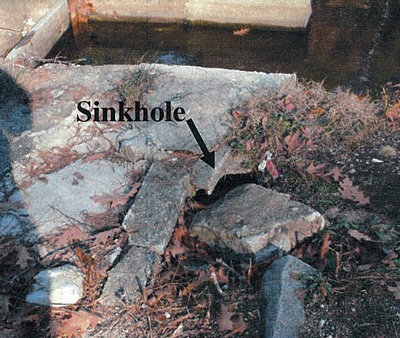
This sinkhole near the sluiceway is one of the areas in need of repair. - Removing stumps and root systems where possible from the crest of the dam;
- Restoring the auxiliary spillway, which was originally intended to relieve the dam during flood conditions but has for years been barely visible as a shallow gully about 75' east of the dam; and
- Adding rocks to the stilling basin - the pool between the dam and Rattlesnake Hill Road - to buttress the foot of the dam and dissipate the force of water plunging over the dam's picturesque waterfall.
GEI's report estimated the cost of the work it recommended at between $21,000 and $42,500, but FPC President Steve Cotton, after conferring with the engineers, called those numbers "an unimaginably worst-case scenario," and said an estimate of $5,000 to $7,500 was "a lot more likely." He said his estimate was based on the FPC's ability to recruit volunteers to do most of the work.
Some of the work recommended by GEI has already started, based on the preliminary recommendations made by the engineers at the time they conducted their inspection in November. Volunteers have felled trees and brush the length of the dam, and the largest sinkhole on the crest has been partially repaired. The Corporation is trying to procure granite slabs to armor the crest and prevent the kind of erosion which hit the dam during last May's flooding.
To download the essentials of the GEI report (the text and a site sketch, 7 mb), click here.
To download the entire report (including pictures and charts, 20 mb), click here.
Balmy Weather Aids Dam Repairs
December 2006
Taking advantage of unseasonably warm November weather, volunteers have begun the repair work recommended by engineers who conducted a safety inspection the Foster's Pond Dam earlier in the month.

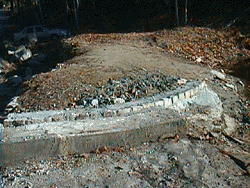 |
| May's overtopping scoured an area next to the spillway. A hastily-improvised fabric barrier slowed the damage. In November, repairs got underway (above). |
The maintenance work has already given a new look to the 150-year-old structure, creating visitor-friendly access to the shoreline and eliminating a tangle of brush and trees at the crest of the dam.
Volunteers felled several trees growing on the dam. The engineers had asked for the trees to go, since their roots can provide channels for water to leak through an earthen dam.
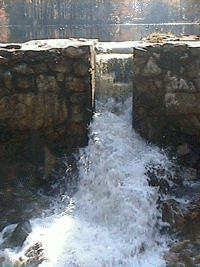 |
| On November 1, when the drawdown began, water came nearly to the top of the sluiceway. |
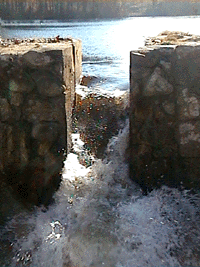 |
| By December 1, the water level had dropped about 15 inches, allowing work to begin on the dam. |
Then, on November 30, work began to repair damage caused by last May's flooding. Willard Circle resident Scott Fumicello, a skilled mason who has done extensive volunteer labor on the dam, set in place a foundation of granite cobblestones as part of a plan to build up an area adjacent to the main spillway that was overtopped and badly scoured last May.
The work was aided by balmy weather which held as the winter drawdown dropped the water level sufficiently to allow access to the damaged area. The drawdown, which began November 1, brought the Pond down more than a foot below the level of the spillway. One reason for lowering the Pond each winter is to allow repairs to be made at the dam.
Engineers Inspect Dam
November 2006
The Foster's Pond Dam got its first thorough check-up in five years, and after being probed, peered at, and photographed for several hours, the experts tentatively concluded that the patient was reasonably fit - for a 150-year-old.
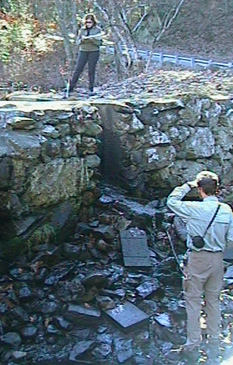 |
| Engineers Anastasia Papadopoulos (top) and Lee Wooten inspect the dam November 10. The winter drawdown was suspended for a couple of hours to allow a closer look at the sluiceway. |
Two engineers from GEI Consultants Inc., based in Winchester, MA, conducted the safety inspection as part of a State-mandated program to have more than 1,000 dams in Massachusetts reviewed before the end of this year.
When the dam was last inspected, in 2001, the work was done by State engineers. Under the new program, dam owners are required to hire - and pay for - private companies to do the work. The Foster's Pond Corporation selected GEI - a nationally known geotechnical engineering firm with 15 offices nationwide - from among four pre-qualified companies that responded to a Request for Proposals.
GEI Vice President Lee Wooten and Senior Project Manager Anastasia Papadopoulos met with three representatives of the FPC during the inspection: FPC president Steve Cotton; Treasurer Dave Brown, who drew the plan for the new access-way by the dam; and Willard Circle resident Scott Fumicello, a skilled mason who has generously volunteered his time and equipment to construct the access-way and undertake significant maintenance work on the dam.
GEI's formal inspection report must be filed with the State by December 15, and will include written recommendations for patching up some parts of the dam which have suffered from neglect over the years. But Wooten indicated that he had found no major defects requiring expensive repairs.
Wooten outlined to the FPC representatives his recommendations for fixing damage to the crest of the dam caused by last May's flooding. He recommended clearing additional trees from the crest, since their roots can provide channels for water to leak through the dam. He also recommended clearing brush and soil from an auxiliary spillway - a gully about 75 feet east of the dam which empties onto Rattlesnake Hill Road at the new access-way - which appears to have been designed to relieve pressure on the dam in the event of extreme flooding conditions.
Winter Drawdown Starts
November 2006
The 2006-7 winter drawdown got underway November 1, as the first "stop log" was removed from the Foster's Pond Dam. By the end of the month, when the drawdown process is complete, the water level in the Pond will drop about 16" below the bottom of the spillway - the main waterfall over the 150-year-old structure.
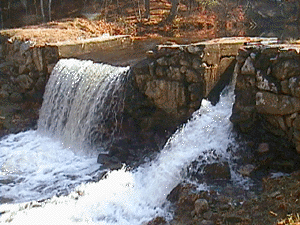 |
| The '06-07 winter drawdown began November 1. The removal of the first of three stop logs allowed water to start escaping through the narrow sluiceway to the right of the spillway. |
Depending on how much rain falls, the water level will drop less than an inch a day as the drawdown proceeds. The only means of affecting the pace is the primitive control - three boards nested in the narrow sluiceway next to the spillway - that was restored last year after decades of neglect. As each of the three boards is removed, the Pond level drops a little more. The concrete-lined bottom of the sluiceway is a foot and a half below the level of the spillway, setting the limit on how far the Pond can be lowered.
The main reason for lowering the Pond is to protect the dam. The drawdown creates reserve capacity for the winter's snow and ice, so that the spring melt is less likely to overwhelm the dam. That can result in "overtopping," a potentially dangerous condition for an earthen dam.
Last year's drawdown - the first in more than 30 years - worked perfectly, with no adverse effect on shallow wells and a perfectly-timed refill with no overtopping. But Mother Nature had a surprise waiting: shortly after the refill, torrential rains flooded much of the Northeast, and the Foster's Pond Dam overtopped. The Corporation is still in the process of repairing the scouring caused by the dramatic flooding conditions.
The drawdown also is aimed at killing shoreside aquatic weeds, which are vulnerable to freezing. And shoreline landowners have a chance, while the water is lower, to clean weeds and other debris, as well as repair docks.
The Corporation is authorized to undertake an annual winter drawdown under an Order of Conditions granted by the Andover Conservation Commission and upheld by the State Department of Environmental Protection. The five-year Order, which also allows herbicidal weed treatment of Foster's Pond, expires in January, 2010.
Thirteen owners of shallow wells near the Pond were notified of the impending drawdown in mid-October. Even though none of the wells lost water during last winter's drawdown, the notices are required by the Order of Conditions.
The Pond will be refilled next Spring, beginning in April.
Dam Spruces Up For Inspection
October 2006
The Foster's Pond Dam, primping for its first date in five years with a civil engineer, got the groundskeeping equivalent of a shave and a haircut October 25.
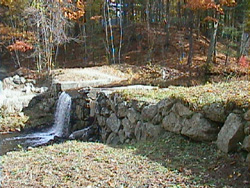 |
| The dam was shorn of its bushy overgrowth in preparation for its first inspection in 5 years. |
A two-man crew from Andover-based Forever Green Lawn & Landscape, hired by the Corporation to clear brush from the crest and foot of the dam, wielded weed-whackers and chainsaws for three hours, leaving the dam shorn of a tangle of weeds, ferns and poison ivy that had obscured the structure.
The dam is due to be inspected in the next couple of weeks under new State requirements which compel private dam-owners to hire engineers to undertake safety checks. The Foster's Pond Corporation has retained GEI Consultants, Inc., headquartered in Winchester, MA, to conduct the state-mandated inspection of our dam.
The dam was last inspected in 2001. At that time, State employees did the inspection, at no cost to the dam-owner.
The brush-clearing also cleaned up some of the remaining scrub in the new "pocket park" the Corporation has created next to the 150-year-old dam. Further work will be done this Fall to finish off the neighborhood-friendly accessway to the shore of the Pond and repair damage caused by last May's flooding.
Corporation Receives Grant
October 2006
The Foster's Pond Corporation has been awarded a $7,500 grant from the Boston Foundation to help with the costs of a state-mandated safety inspection of the dam.
The grant was made from the Bessie P. Goldsmith Fund, Bessie's bequest to preserve her beloved woodlands on the eastern shore of Foster's Pond. The Boston Foundation, as trustee of Bessie's estate, is the largest landowner on the Pond.
Under new State laws and regulations on dam safety, the FPC - along with 1,069 other dam-owners in the State - has been ordered by the State's Office of Dam Safety to hire a professional engineer and conduct an inspection of the dam. The Corporation issued a Request for Proposals last month to four prequalified engineering firms, and all four have submitted proposals to perform the inspection. The Corporation's Board of Directors will make a selection on October 11. The inspection is required to be completed by December 15.
New Pathway Takes Shape
September 2006
For the first time in living memory, you can stroll to the crest of the Foster's Pond Dam over a gently sloping path.
 |
| There's a new pathway to the top of the Foster's Pond Dam. As of September 20, the chips were down and a new "pocket park" was beginning to take shape. |
The Corporation's plan to improve the little "pocket park" next to the 150-year-old dam is beginning to take shape. The new access to the shoreline is still a work in progress, but the area is already a more appealing spot, with tangled bushes and decaying fences replaced by a mat of wood chips and a new vista of the Pond.
On a more functional note, the new path will allow mechanized equipment to get to the crest of the dam, vastly easing the job of maintaining the earth-and-masonry structure. And, in an emergency, equipment can now be brought in to avert a breach.
Most of the work so far has been undertaken by Willard Circles resident Scott Fumicello, an accomplished mason and landscaper who has generously donated hours of labor, and the use of his equipment, to preserve and improve the dam. Rattlesnake Hill Road resident Paul Ross, who chairs the Corporation's Dam Committee, has also played a crucial role in conceiving and executing the project.
It's all part of a plan, developed by the FPC and approved by the Andover Conservation Commission, that includes repairs to the damage from last May's flood. When the work is complete, large boulders will prevent parking at the base of the dam - and discourage boat-owners from scraping their craft along the clay crest, scouring small valleys that can erode in flood conditions.
A heavy chain, mounted on posts, will prevent unauthorized vehicles from entering the new access way. But neighbors - and anyone else parking elsewhere, away from the dam - will have easy access to the shore.
Meanwhile, the dam itself will be subjected to a higher level of scrutiny this Fall as a result of new State laws and regulations on dam safety. Under the new rules, the FPC - along with 1,069 other dam-owners in the State - has been ordered by the State's Office of Dam Safety to hire a professional engineer and conduct an inspection of the dam. The Corporation has issued a Request for Proposals to four qualified engineering firms, and will award a contract to get the inspection done by the December 15 deadline.
Conservation Commission Okays Dam Access Plan
August 2006
The Andover Conservation Commission has given the green light to a plan for a new six-foot-wide path to the crest of the Foster's Pond Dam.
The plan, which was submitted by the Foster's Pond Corporation in June, was unanimously approved by the Conservation Commission at a meeting on August 1.
 |
| Site plan for the new pathway at the dam (as revised 12/06). Click the image for a larger view. |
Under the plan, a line of large boulders will be positioned along Rattlesnake Hill Road, blocking vehicles from parking at the base of the dam. A new access-way will be created about 60 feet northeast of the dam, where a 10' by 20' staging area will be opened up. From there, a six-foot-wide path will lead to the top of the dam. The staging area and the path will be covered with wood chips. A chain will prevent unauthorized vehicles from parking in the staging area or using the path.
The new layout will, for the first time, allow equipment to carry materials routinely to the crest of the earthen dam. In past years, volunteers have frequently had to rely on bucket brigades to lug clay and stone to the dam, and to spread the materials around.
The plan got its start in May, after Dam Committee Chairman Paul Ross surveyed the damage caused by a foot of torrential rains. He suggested an access-way to allow equipment to ferry materials needed for that and future repair jobs. The new path will also allow materials to be safely dumped onto the dam if another flood threatens to breach the 150-year-old structure. Until now, that has been impossible, since equipment would have to fight raging waters to approach the dam from the downstream face instead of from the side.
The plan was drawn up by Dave Brown, in consultation with Scott Fumicello, and approved by the FPC Board of Directors. FPC President Steve Cotton and Brown addressed questions about the plan at the August 1 Conservation Commission meeting.
The Corporation hopes to complete work on the plan this year, in advance of the fall hurricane season.
Clean-Up Crew Tames Overgrowth on Dam
July 2006
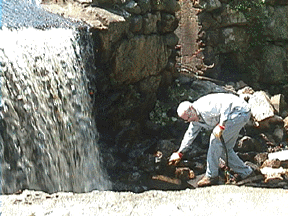 |
| Marty Rabinowitz plucks debris from the stilling basin. |
The Foster's Pond Dam received its most intensive beauty treatment in more than two years, as volunteers spent the first few hours of their holiday week-end clearing brush, pulling weeds and picking up litter around the historic structure.
Buoyed by sunny skies and a balmy breeze, 10 area residents wielded chain saws, lopping shears and pruners to tame the tangle of bushes and vines on the crest of the earthen dam and in its stilling basin at the foot of the picturesque waterfall. They also removed a decrepit, decades old snow fence, easing access to the Pond from Rattlesnake Hill Road.
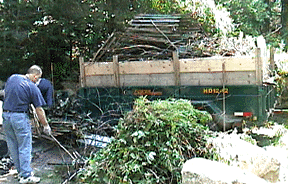 |
| Eric Lynn stacks brush for the next load. |
The dam and stretches of shoreline on either side of it are owned by the Foster's Pond Corporation. Clearing woody growth from the dam, in addition to making the area more attractive, is a safety measure. The roots from woody plants can give rise to leaks in an earthen dam, through an effect known as "tubing."
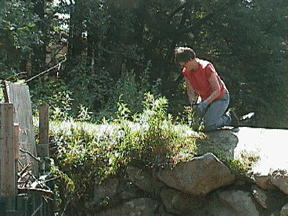 |
| Dot Tyler pulls weeds from the crest of the dam. |
Sprucing up the dam was part of a larger effort sponsored by the Corporation, a Pond-wide clean-up. Volunteers managed to pull a half-sunken paddleboat, a tire, a ramshackle raft, and assorted litter from the Pond.
The combined effort more than filled a trailer parked by the dam to handle the haul, leaving a bit more work for a later day.
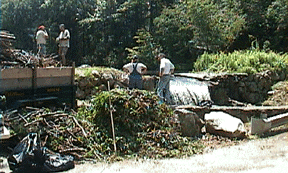 |
| (L. to r.) David Brown, Stephan Amesoeder, Trish Fleming and David Cardin survey a morning's work. |
The next major step for maintaining the dam will be repair of erosion caused by May's flooding.
The Corporation has mapped plans to construct a narrow access-way to the crest of the dam, allowing equipment to bring materials to an area near the spillway which was severely eroded when water overtopped the dam in May, washing away some of the clay which caps the structure.
Rain, Rain, Flow Away
June 2006
Even before June was over, meteorologists were declaring May and June, 2006, the rainiest consecutive two months locally since records have been kept. But after taking a beating in May, the Foster's Pond Dam suffered no additional damage in June.
As Mother Nature dumped more than 7.5 inches of rain on Andover in the first 10 days of June, volunteers carefully tended the flow over the dam, determined to prevent a repeat of May's overtopping.
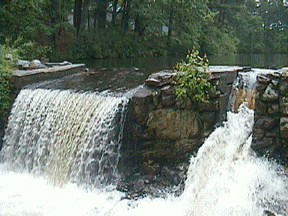 |
| June 10: Water flows over the spillway (left) and churns through the narrower sluiceway, from which two of three "stop logs" have been removed. Both stop logs were reinserted the following day, as rains finally ended. |
The June rains came with enough warning from forecasters that there was time to pull stop-logs from the narrow sluiceway in the 150-year-old dam, increasing the flow and maintaining a manageable water level in the Pond. Water churned into the normally placid stilling basin at the foot of the dam, creating large balls of foam. But the flow remained safely within the concrete-line confines of the sluiceway and the adjacent spillway, the dam's picturesque waterfall. The sluiceway, which had not been used for decades, was restored last year to enable annual winter drawdowns - and to prevent overtopping in periods of heavy rain.
When the rains finally gave way to sunshine on June 11, the stop-logs were reinserted in the sluiceway, diverting the entire flow back to the spillway. And when another round of downpours deluged the region later in the month (forcing postponement of a Pond-wide clean-up event on June 24), a stop-log was removed once again. There was no overtopping during the June rains - and no further erosion of the clay-capped dam.
The Corporation is currently working on plans to restore the eroded spots on the crest of the dam which were created in May's flooding.
Flood of '06 Leaves Its Mark on Foster's Pond Dam
May 2006
Just when it seemed that a successful winter drawdown had spared the dam from any danger of a spring overtopping, torrential rains hit southern New England, rapidly filling Foster's Pond to the highest level many residents could remember and overwhelming the 150-year-old dam's shallow spillway.
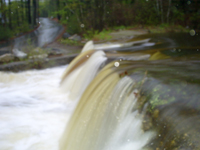 |
| Water roils over the dam at 7:45 p.m Sunday, May 14. For a dramatic 1-minute video by Foster's Pond Road resident Kemper Mazzarelli, click on the image above. |
Roiling waters flowed over the dam's earthen crest on both sides of the concrete-lined spillway, scouring a pit the diameter of a kitchen table in one section of the clay cap. The stilling basin - where the dam's picturesque waterfall gently spatters under normal conditions - became a churning cauldron of frothing whirlpools, filling nearly to their top the two 36" culverts which pass under Rattlesnake Hill Road.
The storms had come on too fast to permit lowering of the Pond in advance. Some of the pressure on the dam might have been alleviated by removal of the stop logs in the narrow sluiceway - the crude mechanism which had allowed this year's winter drawdown. But the water level came up so rapidly that it soon was too late to reach the stop logs, which are difficult to pull out even in calm conditions. With water flowing over the concrete abutments on both sides of the sluiceway, the task became impossible.
 |
| May 16: Overtopping continues at the west end of the dam (on right). Under normal conditions, the only flow should be over the concrete spillway (the waterfall on the left). |
The peak appeared to come on Sunday evening, May 14, when Foster's Pond Road resident Kemper Mazzarelli grabbed his video camera and recorded the maelstrom at the dam. (To download, click here.)
Once the water began to subside - revealing some of the damage to the dam - others came to the rescue. Dam Committee Chairman Paul Ross, joined by Glenwood Road residents Dave Brown and Trish Fleming, managed to lay down a waterproof membrane over the worst area of erosion, securing it with large rocks and protecting the spot from further scouring.
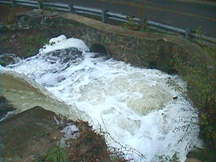 |
| May 16: The normally placid stilling basin remained a seething cauldron, nearly filling the culverts under Rattlesnake Hill Road. |
But still the waters came. By May 16, the water level had fallen several inches, reducing the overtopping on the east side of the dam to a trickle. Meanwhile, the west side of the dam, where the sluiceway is located, continued to experience overtopping, and the stilling basin continued to roil.
 |
| May 16: On the east side of the dam, a makeshift covering protects the clay cap from further erosion. |
The dam never appeared in danger of giving way, but serious overtopping is never a good thing for an earthen dam. The FPC owns the dam, and officials in the organization have already begun mapping out plans for repairs - and considering improvements which will allow equipment to get onto the dam in an emergency.
Although the dam suffered some damage, things could have been worse. A lot of maintenance paid off. Two good-sized trees were washed over the dam, but prior clearing of trees and brush from the dam's crest meant that the water-borne debris did no harm going over the top. Such debris crashing into trees on top of an earthen dam can uproot them, leaving large holes and the potential for a disaster.And diligent clearing of brush from the stilling basin left the culverts clear to handle the massive flows.
Winter Drawdown? Consider It Water Over the Dam
April 2006
The winter drawdown came to an end on April 25, as water began trickling over the spillway of the Foster's Pond Dam for the first time since last November.
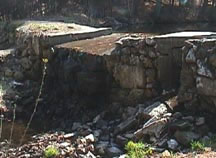 |
| Water flows over the spillway for the first time since November, 2005, marking the end of the 1st winter drawdown in more than 30 years. |
Despite six weeks of unusually dry weather, the Pond refilled on schedule. The process started on March 14, when the first "stop log" was replaced in the narrow sluiceway which regulates the water level. The Pond then began rising at the rate of about 1/2 inch a day. By April 24, the level had risen the full 16" of the peak winter drawdown, and water was lapping at the edge of the 12-foot wide spillway which channels the dam's picturesque waterfall. The following day, the third (and last) stop log went in, completing the drawdown cycle by shifting the entire outflow of the Pond to the spillway.
The main purpose of the drawdown was to prevent overtopping of the dam - a potentially dangerous event that can occur when spring rains and snowmelt add so much water to the Pond that the outflow overwhelms the spillway and surges over the earthen crest of the dam. And while Mother Nature served up little snow over the winter, the drawdown proved to be a reassuring exercise.
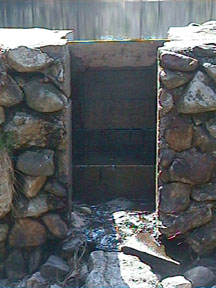 |
| Three "stop logs" block flow through the sluiceway, which was restored to operation last fall after decades of neglect. The stop logs will stay put until next November - unless heavy rains require the release of water to prevent overtopping the dam. |
The process worked flawlessly. No shallow well owner reported losing water. The water level fell in the Fall and rose in the Spring on the schedule recommended by experts. And the drawdown permitted the Corporation to undertake minor maintenance on the dam in places that are usually submerged. Still to be determined: Whether the drawdown had the often-observed effect of killing submerged shoreline weeds that were exposed to frost.
The Corporation is authorized to undertake an annual winter drawdown under an Order of Conditions granted by the Andover Conservation Commission, and upheld by the State Department of Environmental Protection, last year. The five-year Order, which also allows herbicidal weed treatment of Foster's Pond, expires in January, 2010.
Temperatures, and
Pond, Get Set to Rise
March 2006
As Spring nears, the Winter drawdown of Foster's Pond has been put in
reverse. On March 14, Dam Committee Chairman Paul Ross
re-inserted one of the three "stop logs" used to control the water
level of the Pond, beginning the process of slowly raising the water
level.
The stop-logs - 12" wide boards that span the narrow sluiceway in the
Foster's Pond dam - were removed last November to lower the water level
for the Winter. The drawdown allowed the Pond to absorb some
heavy snows, and extraordinary inflows that were observed this Winter
coming from Frye's Brook, without overtopping the earthen dam.
Freezing conditions are also expected to have killed some of the
aquatic weeds whose root systems were exposed.
State guidelines call for pond drawdowns to be reversed beginning in
March, with the aim of refilling the water bodies by early to
mid-April. The guidelines also call for some downstream flow to
be maintained throughout the refill process, so expect to see some
water coming over (or between) the stop logs as each is replaced, one
by one. Much more water is rushing into the Pond from Frye's
Brook, so the Pond will rise.
No sooner did the first stop log go in than the Corporation got some
unsought assistance in stopping the flow. Beavers have been
seeking to plug the sluiceway with branches, which have to be removed
almost daily.
Pond Drops to Target
Water Level (Almost)
December, 2005
The first Winter
drawdown of Foster's Pond in more than 30 years lowered the water level
about 16 inches, just shy of the 18-inch drop targeted by the
Corporation.
The 16-inch decline was measured during the final week of November,
just before heavy rains briefly raised the water level. By
December 3, the pond had receded once again to about 14 inches below
the bottom of the spillway of the Foster's Pond dam. While the
level will continue to fluctuate -as it does throughout the year - it
appears that the drawdown will stabilize at around the 16-inch mark.
The achievement was a welcome sight to Dam Committee Chairman Paul
Ross, who has rallied volunteers to maintain the 150-year-old
dam and keep the area clean. The drawdown is primarily a
safety measure, designed to allow Spring rains and snow melt to fill
the Pond without overtopping - and
eroding - the earthen dam.
The extent of the drawdown is limited by the size and depth of the
dam's sluiceway - the narrow channel next to the much wider spillway
over which the dam's picturesque waterfall flows for most of the
year. Flow through the two-foot wide sluiceway is regulated by
removable "stop logs." The stop logs have all been taken out, and
as the Pond level has fallen, the outflow has tapered off as the volume
approaches that of the inflow from Frye's Brook.
In the 1930's, the Pond was lowered by several feet after an 8-inch
iron pipe, with a valve, was installed. But that mechanism rusted
out more than 30 years ago and is now embalmed in concrete. The
16-inch drawdown achieved this year is apparently about the maximum
that can be attained without a major reconstruction of the dam.
An Order of
Conditions issued by the Andover Conservation Commission and later
approved by the State's Department of Environmental Protection had set
18 inches as the outside limit on the drawdown.
Drawdown: 12"
and Counting
November, 2005
Two weeks into the drawdown of Foster's Pond, the water level had fallen one foot, two-thirds of the way towards the target set by the Corporation.
As of November 14, the Pond was 12 inches below the bottom of the spillway of the Foster's Pond dam, with water continuing to flow steadily out of the two-foot wide sluiceway that can be used to regulate the level of the Pond. When the level drops to 18 inches below the bottom of the spillway, a wooden stop-log will be re-inserted in the sluiceway to maintain the lower water level for the remainder of the winter.
The drawdown began November 1, with the water level dropping - as planned - by about an inch a day.
Winter Drawdown
Slowly Lowers Pond
November 2005
For the first time in more than thirty years, the water level of Foster's Pond is being drawn down for the winter.
Under the watchful eye of the Corporation's Dam Committee, the
sluiceway of 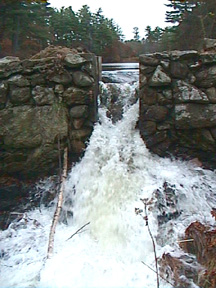 the Foster's Pond
Dam has been opened, lowering the Pond by about an inch a day.
When the water level is 18 inches below the bottom of the dam's
spillway, boards will be replaced in the sluiceway (the narrow channel
to the right of the spillway) to maintain the lower level until next
Spring.
the Foster's Pond
Dam has been opened, lowering the Pond by about an inch a day.
When the water level is 18 inches below the bottom of the dam's
spillway, boards will be replaced in the sluiceway (the narrow channel
to the right of the spillway) to maintain the lower level until next
Spring.
The drawdown began November 1, in accordance with an Order of Conditions approved by the Andover Conservation Commission and affirmed by the State Department of Environmental Protection earlier this year.
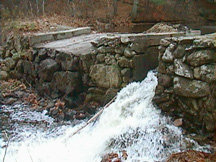 As of November 10,
the water level was about 7" below the bottom of the spillway - about
the same level it was in September, before torrential rains filled the
Pond and sent water rushing over the dam. The aim is to lower the
Pond another 11 inches by December 1. The 18-inch drop is the
maximum allowed under the Order of Conditions - and pretty near the
limit that can be achieved with the existing sluiceway.
As of November 10,
the water level was about 7" below the bottom of the spillway - about
the same level it was in September, before torrential rains filled the
Pond and sent water rushing over the dam. The aim is to lower the
Pond another 11 inches by December 1. The 18-inch drop is the
maximum allowed under the Order of Conditions - and pretty near the
limit that can be achieved with the existing sluiceway.
The primary reason for the drawdown is safety. At least three
times in recent years, melting ice and heavy spring rains "overtopped" the dam - with water overflowing
the concrete spillway and cascading over the earthen embankments on
either side. Overtopping, which can quickly erode an earthen dam,
is one of the principle causes of the catastrophic failure of such dams.
The drawdown has other purposes, too. The drawdown will allow the Dam Committee to undertake additional maintenance on portions of the dam which are normally under water. Drawdowns are also considered effective in controlling some aquatic weeds, which die from the combined effects of freezing and drying.
 Keeping a steady flow through the sluiceway has proved a bit harder
than expected. Almost every night since the sluiceway has been
open, resident beavers have attempted to plug the channel with freshly
gnawed branches. Volunteers have
cleared the debris, throwing it on a steadily growing heap between the
dam and Rattlesnake Hill Road. The Dam Committee will remove the
brush pile as part of its maintenance activities later this year.
Keeping a steady flow through the sluiceway has proved a bit harder
than expected. Almost every night since the sluiceway has been
open, resident beavers have attempted to plug the channel with freshly
gnawed branches. Volunteers have
cleared the debris, throwing it on a steadily growing heap between the
dam and Rattlesnake Hill Road. The Dam Committee will remove the
brush pile as part of its maintenance activities later this year.
The Pond will be allowed to refill next April.
Shallow Well Owners
Get Drawdown Notification
October 2005
The Corporation has sent notices to shallow well owners, reminding them that the Pond will be drawn down 18" beginning on November 1.
The notices were sent to 13 property owners in occupied houses near the
Pond which may use shallow wells for some or all of their potable
water. The properties were identified in a survey conducted by the Corporation last year. The advance notice is
required in the State-approved Order of Conditions authorizing
annual winter drawdowns of the Pond.
Winter drawdowns were a frequent occurrence on Foster's Pond until
about thirty years ago. In the 1940's, according to one older
resident, the Pond was drawn down by about six feet, allowing the use
of vehicles to remove tree stumps from areas in the main Pond.
Even with these larger drawdowns, shallow wells in the area did not
lose water.
Two different methods were used for earlier drawdowns. The original mechanism was the simplest: the removal of "stop logs" from the three-foot wide sluiceway adjacent to the spillway over which water normally flows. At some point in the latter half of the last century - the records are not clear when - an 8" iron drainage pipe was inserted at the bottom of the sluiceway, with a valve operated with a large metal wheel. That mechanism had rusted shut by the early 1970's, and this Fall the remnants were encased in concrete.
Today's drawdown mechanism is the old-fashioned one. Stop logs will be removed to allow a gradual drawdown. They will be left out for the winter, then restored next Spring to allow the Pond to refill.
The November 1 commencement date of the drawdown follows the State-recommended schedule for pond drawdowns, allowing wildlife to move to deeper water, locate alternate lodge sites, or relocate their food caches prior to freezing conditions. The drawdown will be gradual, spread over a month-long period.
Prior to several inches of early October rains, the Pond level had fallen to about 7 to 8 inches below the bottom of the spillway, which had not had water flowing over it for several weeks. October's downpours raised the water level by 5 or 6 inches.
The drawdown is aimed at increasing the winter storage capacity of the Pond, so that Spring rains, combined with melting snow and ice, will not overtop the dam - sending water over the sides and damaging the clay top. Overtopping of an earthen dam carries the risk of catastrophic failure.
Sluiceway Restored to Enable Winter Drawdowns
October 2005
Volunteers mixed and poured nearly a ton of concrete - by hand - as Fall maintenance of the dam cranked into high gear.
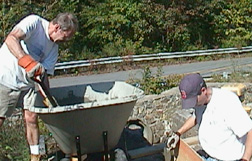 |
| John Lugus and Paul Ross prepare for a pour |
Dam Committee Chairman Paul Ross, John Lugus, Dave York, and Steve Cotton hauled 80-pound sacks of concrete mix to the sluiceway, where it was used to resurface the sides and plug holes in preparation for this winter's drawdown of the Pond. The sluiceway - the two-foot wide opening to the right of the spillway - will be opened November 1 to begin the drawdown.
The four men labored for five hours October 1. Paul, John and Steve returned for another couple of hours October 3 to finish the work in the sluiceway and patch a nearby sinkhole on top of the dam. They also poured a layer of concrete over the crumbling mechanism that had once opened the valve in an 8-inch pipe used in past years to lower the Pond. The pipe has long since collapsed, and the valve hasn't worked for decades.
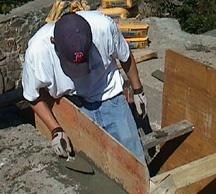 |
| Paul finishes the surface |
By the time they were through, the volunteers had carted 1930 pounds of dry concrete mix to the project.
The work in the sluiceway wound up a critical phase of this year's
maintenance - the work that had to be done in dry weather and before
the water could be let into the narrow channel. Once the concrete
cures and the wooden forms are removed, the next step will be to take
out the temporary sand-bag dam that has kept the sluiceway dry.
Still to come: a bucket brigade to spread clay along Pond-facing
slope of the dam. After frost has subdued the poison ivy which
covers much of the dam, volunteers will also be needed to remove brush
from the top and front of the 150-year old structure.
Fall Dam Maintenance
Under Way
September 2005
In preparation for the first winter drawdown in more than three decades, the Dam Committee has undertaken a program of cleaning and patching parts of the dam - while keeping a wary eye out for the 6-foot black snake that seems to have made its home nearby.
The work, coordinated by Dam Committee Chairman Paul Ross, began on Labor Day, when Scott Fumicello repaired portions of the sluiceway. On September 17, John Lugus and Steve Cotton joined Paul for several hours of backbreaking work, cleaning the culverts and removing a concrete barrier that prevented drawing down the water level more than a few inches. With the barrier now removed, the Corporation will be able to draw the Pond down a full 18" this winter, as authorized by State and local officials.
Further maintenance work is scheduled before the drawdown, which will begin November 1.
The main purpose of a winter drawdown is to create capacity to accommodate the accumulation of winter snows, so that spring runoffs do not result in flooding which "overtops" the dam. Overtopping - which occurs when the water level is so high that the flow cannot be contained within the concrete spillway, and water rushes over the earthen sides of the dam - can be dangerous, resulting in erosion of the dam and the potential for a catastrophic failure.
The dam has experienced overtopping with increasing frequency in recent years, suffering only minor damage but occasioning major concern on the part of State and local safety officials. To see pictures of the 2004 overtopping, click here.
Annual winter drawdowns of up to 18" were approved as part of an Order of Conditions okayed by the Andover Conservation Commission and affirmed by the State Department of Environmental Protection in March, 2005.
Dam Maintenance
Proves Its Worth
April, 2005
Weather forecasters were predicting the type of flooding that nearly overwhelmed the dam in 2004, but things looked a lot different when the April rains hit in 2005. Work by the Dam Committee - with special efforts put in by Paul Ross, Rick Keller, and Scott Fumicello, among others - restored the dam's ability to deal with the excess flow. New "stop logs" in the sluiceway (that two-foot wide slot just to the right of the spillway, where water normally comes over the dam) can now be removed to allow the safe release of additional water when the Pond is rising. Quick work by Dam Committee Chairman Paul Ross on the eve of the highest predicted flow prevented overtopping - a condition when water is so high it pours over the earthen cap of the dam on either side of the spillway, eroding the top and presenting a potential safety problem. Closely monitoring the water levels, Paul removed two of the stop logs, permitting the safe escape of water that would otherwise have built up behind the dam. The result: This year, with the release of the excess flow through the sluiceway, the Spring runoff stayed safely within the spillway, and the earthen cap of the dam suffered no erosion.
April
Showers Hit Dam Hard
April, 2004
If anyone needed a refresher course on why we've got to work on the dam, Mother Nature came through in April with downpours which sent water surging out of the spillway and over the earthen embankments on both sides, exposing some leaky areas.
Dam Committee Chairman Paul Ross noticed the rising level of the Pond during the first week-end of April, and began planning to lay down sandbags. Instead, he hit on the idea of putting down waterproof landscaping cloth, anchored by concrete blocks - a temporary measure which helped stave off significant erosion of the clay cap on the left side of the spillway.
Foster's Pond Road resident Dave Adilman captured the overtopping in a
pair of photos.
Dam Exfoliated: Committee
teams up to give dam a clean appearance
November, 2003
Members of the Corporation's Dam Committee braved poison ivy and ice-cold water to tame brush, clear the spillway, and remove obstructions from the downstream culverts of the Foster's Pond Dam. They also brought down a dead tree that was standing on the top of the dam - a hazard whose removal had been sought by the State's Office of Dam Safety.
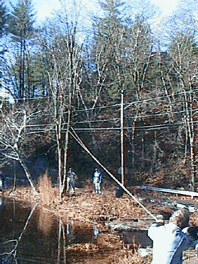 The work on November 22 left the dam free of woody growth which experts
say can endanger the integrity of earthen dams. One birch tree
near the edge of the dam was left standing; the Committee plans to
return in the winter, when the tree can be dropped onto the ice for
easier removal.
The work on November 22 left the dam free of woody growth which experts
say can endanger the integrity of earthen dams. One birch tree
near the edge of the dam was left standing; the Committee plans to
return in the winter, when the tree can be dropped onto the ice for
easier removal.
Removal of the plant cover allowed the Committee to
take a closer look at the condition of the dam, revealing the need for
work on the sluiceway as well as other parts of the 150-year-old
structure. Committee Chairman Paul Ross plans to draw up a list
of items that must be addressed, as well as a timetable for dealing
with them over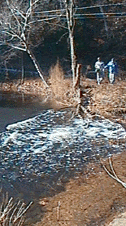 the next several
months.
the next several
months.
The Committee will also be exploring low-cost means for drawing down water in the Pond during winter periods. Winter draw-downs are a common means of addressing three issues: dam maintenance; avoidance of "overtopping" during spring melts; and weed control. A draw-down would require Town approval, and would not be undertaken unless approved by FPC members, after review by both the Dam Committee and the Weed Committee. No draw-down is under consideration for the 2003-2004 winter.


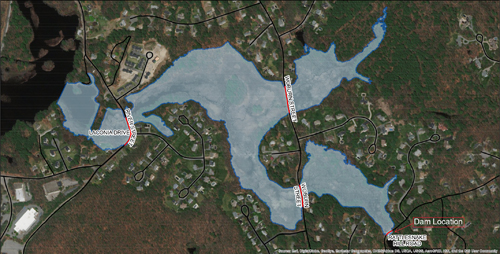

 Questions? Comments? Contact us at
Questions? Comments? Contact us at